Wiederaufbau in Syrien
| Herausforderungen und Handlungsoptionen für die EU und ihre MitgliedstaatenSWP-Studie 2020/S 07, 20.04.2020, 37 Seiten Dr. Muriel Asseburgist Senior Fellow in der Forschungsgruppe Naher / Mittlerer Osten und Afrika. Der Bürgerkrieg in Syrien ist längst militärisch zugunsten des Regimes entschieden. Eine verhandelte Konfliktregelung, eine Aussöhnung oder eine nachhaltige Stabilisierung sind für das Land nicht in Sicht. Syrien steht vor enormen Herausforderungen, die über den Wiederaufbau von Infrastruktur und Wohnraum weit hinausgehen. Dazu gehören vor allem Anschubhilfe für eine wirtschaftliche Erholung, die Stabilisierung der Währung und die Erneuerung staatlicher Versorgungsleistungen, insbesondere bei Bildung, Gesundheit, Strom und Wasser. Der Ansatz der syrischen Führung, die wirtschaftlichen Auswirkungen der Covid-19-Pandemie und die geopolitischen Interessen der Regional- und Großmächte machen es äußerst unwahrscheinlich, dass ausreichend Mittel für einen umfassenden Wiederaufbau Syriens zur Verfügung stehen werden. Ebenso wenig ist zu erwarten, dass die Ressourcen gemäß dem Bedarf der Bevölkerung eingesetzt werden. Die EU und ihre Mitgliedstaaten haben ein Engagement beim Wiederaufbau Syriens von tragfähigen Schritten in Richtung einer verhandelten und einer politischen Öffnung des Landes abhängig gemacht. Sie sollten ihren Ansatz so anpassen, dass er besser den Herausforderungen vor Ort und der aktuellen Realität entspricht. Das bedeutet insbesondere, humanitäre Hilfe effektiver einzusetzen, sektorale Sanktionen abzubauen und die Rehabilitierung von Basisinfrastruktur auch in Gebieten zu unterstützen, die unter Kontrolle der syrischen Regierung stehen. Auf diese Weise ließe sich wirksamer als bislang zur Linderung der Not und zur Verbesserung der Lebensbedingungen beitragen. Eine nachhaltige Stabilisierung Syriens ist allerdings nur zu erreichen, wenn dort tiefgreifende Reformen durchgeführt werden. In diesem Sinne sollten die Europäer ihren »More for More«-Ansatz ausbuchstabieren. Von einer vollständigen Normalisierung gegenüber den Spitzen des Assad-Regimes sollten die Europäer absehen. Stattdessen sind sie gefordert, die strafrechtliche Aufarbeitung von Kriegsverbrechen, schweren Menschenrechtsverletzungen und dem Einsatz international geächteter Waffen noch aktiver als bislang zu unterstützen. |
Ein schwieriger Wiederaufbau: Perspektiven europäischer Initiativen in Syrien
| Jump to Navigation ENGLISH FreundeskreisBAKSbrief Arbeitspapiere Ein schwieriger Wiederaufbau: Perspektiven europäischer Initiativen in Syrien 2/2019 PDF Version: arbeitspapier_sicherheitspolitik_2019_2.pdf Autor/in: Stefan Lukas Marius Paradies Obwohl der Krieg in Syrien keineswegs beendet ist, werden bereits vielerorts Konzessionen und Aufträge für den einsetzenden Wiederaufbau des Landes unter den Partnern von Baschar al-Assad verteilt. Da jedoch Damaskus und seine Verbündeten kaum in der Lage beziehungsweise nicht willens sein werden, den syrischen Staat aus eigener Kraft wieder aufzubauen, stellt sich vor allem für die kapitalvermögenden Staaten Europas die Frage nach mehr Engagement im Land am Euphrat. Europa braucht einen stabilen Nahen Osten und sollte sich daher am Wiederaufbau Syriens beteiligen. Auch wenn das bedeutet, mit Assad zusammen zu arbeiten. Zur Lage im Land Der Syrienkrieg wütet seit 2011 und hat bereits etwa eine halbe Million Leben gefordert. Mehr als eine Million Menschen wurden verwundet und schätzungsweise 12 Millionen Menschen wurden vertrieben, was der Hälfte der Vorkriegsbevölkerung entspricht. Oft herangezogene Vergleiche zum 30-jährigen Krieg sind daher gemessen am Leiden der Zivilbevölkerung nicht ganz unberechtigt. Auch wenn die meisten Medien dem Krieg selbst momentan vergleichsweise wenig Aufmerksamkeit schenken – hin und wieder wird über ein Trump-Tweet zu Syrien berichtet – so ist er noch lange nicht beendet. Der Norden und der Osten des Landes sind weiterhin fest in der Hand oppositioneller Kräfte. Noch im September vergangen Jahres drohte eine Eskalation zwischen Russland und der Türkei um die letzte Rebellenhochburg Idlib. Die russischen Kräfte wollten zusammen mit den syrischen und iranischen Verbänden dabei helfen, die Provinz mit ihren fast drei Millionen Einwohnern von den oppositionellen Islamisten zu befreien, die dort derzeit die Kontrolle haben. Eine Offensive konnte zwar durch einen vorläufigen Deal zwischen Ankara und Moskau abgewendet werden, doch eine dauerhafte Lösung wurde noch nicht gefunden. Nichtsdestotrotz kündigte der türkische Präsident Erdogan jüngst anstehende Offensivoperationen auf syrischem Gebiet an. Die größtenteils kurdisch bewohnten Gebiete im Nordosten sowie nahezu das gesamte Land östlich des Euphrat sind unter der Kontrolle kurdischer und oppositioneller arabischer Einheiten, die zumeist von den USA unterstützt werden. Nun, da die USA ihren Rückzug vorbereiten, und den Kurden eine türkische Intervention bevorsteht, wenden sich diese an Assad. Dass dieser an einem Kompromiss mit den Kurden nicht abgeneigt ist, zeigt nicht zuletzt die Übergabe der bislang kurdisch besetzten Stadt Manbidsch an syrische Regierungstruppen. Ob es solch einen Kompromiss wirklich geben wird und wie dieser aussehen könnte, bleibt vorerst abzuwarten. Der Islamische Staat ist weitgehend besiegt, leistet aber in einigen wenigen Enklaven entlang des Euphrat erbitterten Widerstand, so zum Beispiel in as-Suwayda und Hajin. Nichtsdestotrotz bleibt das Bedrohungspotential durch den Islamischen Staat aufgrund seines Rückzuges in den Untergrund weiterhin hoch, was die wieder zunehmenden Anschlagsserien im Nachbarland Irak bezeugen. Wann Frieden einkehrt und welcher Art dieser sein wird, ist nicht genau abzusehen. Weder ein Ende der militärischen Auseinandersetzungen noch eine Versöhnung zwischen den diversen Fraktionen erscheinen derzeit in Aussicht. Was sich jedoch klar abzeichnet, ist, dass die syrischen Regierungstruppen und ihre Verbündeten aufgrund ihrer starken Stellung in den meisten Teilen des Landes die Nachkriegsordnung maßgeblich bestimmen werden. Doch dieser Sieg hat einen hohen Preis. Ungeachtet des millionenfachen menschlichen Leids, haben allein die Schäden an der Infrastruktur und die Zerstörung der Städte, Dörfer und staatlichen Strukturen das Land um Jahrzehnte zurückgeworfen. Eine Kommission der UN schätzte im August 2018 den bisherigen Sachschaden des Krieges auf 388 Milliarden US-Dollar. Demgegenüber steht ein Vorkriegs-Bruttoinlandsprodukt von fast 60 Milliarden US-Dollar. Nicht eingerechnet sind der Verlust an Menschenleben und verlorengegangenen Knowhows. Allein die Räumung der Trümmer aus den Straßen des bis zu 70 Prozent zerstörten Aleppos dürfte bis zu sechs Jahre dauern.[1] Hieran wird deutlich, dass Damaskus den Wiederaufbau nicht aus eigener Kraft wird leisten können. Dies zeigen auch die schlecht anlaufenden Bau- und Reparaturvorhaben in Homs und Aleppo, wo zumeist nur symbolische und militärische Bauvorhaben vorangetrieben werden. Der öffentliche Sektor ist unterfinanziert, und Gehälter werden bis heute zu spät, nur in Teilen oder gar nicht ausgezahlt. Wie soll ohne Planungsämter, geregelte Vergabeverfahren und funktionierende Aufsichten ein solches Jahrhundertprojekt durchzuführen sein? Hinzu kommt der Mangel an grundlegenden humanitären und logistischen Ressourcen, der durch die Sanktionen gegen das Regime noch verschärft wird. Der Wiederaufbau wird bereits organisiert Abhilfe soll unter anderem die jährlich stattfindende Wirtschaftsmesse in Damaskus leisten. Hier sollen Kontakte geknüpft, Bauvorhaben geplant und Kapital beschafft werden. Wurde diese die letzten Jahre noch von Investoren größtenteils gemieden, so schwärmten im September 2018 besonders aus Russland und dem Iran die größten Delegationen von Wirtschaftsvertretern heran. Auch Chinesen und Inder wollen bei der wirtschaftlichen Neuaufteilung des Landes nicht außen vor bleiben und stellen immer neue Projekte und Investitionsvorhaben in Aussicht. Während China im Rahmen seiner Belt-and-Road-Initiative vor allem auf neue Infrastrukturprojekte zwischen Libanon und dem syrischen Binnenland setzt, bemüht sich Indien insbesondere um den syrischen Industriesektor. So wird mit indischen Mitteln derzeit ein neues Wärmekraftwerk mit einem Wert von 240 Millionen US-Dollar südlich von Damaskus errichtet, und nahe Hama baut das indische Unternehmen Apollo International zusammen mit einem syrischen Partner eine neue Recycling-Anlage. Darüber hinaus sind bei den asiatischen Playern neben Öl-Konzessionen vor allem die Schürfrechte für die Ausbeutung der Phosphatbestände im Landesinneren begehrt. Während Moskau als wichtigster militärischer Partner von Damaskus auf die Offshore-Gebiete vor der syrischen Küste hofft, werden das Landesinnere und die großen Siedlungszentren im Besonderen durch den anderen militärischen Partner mit neuen Projekten dominiert – den Iran. Die Sanktionen sowohl gegen Syrien als auch gegen Iran können letzteren nicht davon abhalten, massiv am Wiederaufbau zu partizipieren. Besonders die Restaurierung des Energiesektors wird seit Ende 2017 insbesondere durch iranische Konsortien vorangetrieben, die gleich für fünf syrische Großstädte Zuschläge zum Wiederaufbau erhalten haben. Neben dem Energiesektor soll das zweite große iranische Standbein im Land das Mobilfunknetz werden, welches von der iranischen Firma MCI Hamrahe Avval von Grund auf modernisiert werden soll. Sowohl MCI als auch die meisten der iranischen aktiven Firmen in Syrien sind sogenannte Bonyads, also Großunternehmen, die mehrheitlich den iranischen Revolutionsgarden (Pasdaran) gehören. Zusätzlich unterhalten die Iraner zahlreiche Militärbasen und bauen diese stetig aus, beispielsweise nahe der Grenze zu Israel in der Provinz Daraa. Teheran will damit nicht nur seinen Wirtschaftskorridor nach Libanon ausbauen, sondern auch das Drohpotential gegenüber Israel verstärken, wodurch sich der Iran auch neuen politischen Verhandlungsspielraum gegenüber den regionalen und internationalen Kontrahenten verschafft. Europa hat ein Interesse, sich zu engagieren Wie die IS-inspirierten Terroranschläge und die Migrationsbewegungen der letzten Jahre gezeigt haben, hat die EU ein vitales Interesse daran, dass Syrien nicht nur wiederaufgebaut wird, sondern auch daran, dass eine stabile Nachkriegsordnung gefunden wird. Derzeit profitiert das syrische Regime noch vom Krieg. Solange in Syrien gekämpft wird, kann es sich vor dem Hintergrund des Kampfes gegen den Islamischen Staat und den Al-Qaida nahen Hay‘at Tahrir al-Sham in Idlib als kleineres Übel für westliche Staaten gerieren. Sobald aber Frieden herrscht, muss Assad liefern. Besonders die neuaufkeimende Mittelschicht wird sich nicht ewig mit Stromausfällen und kaputter Infrastruktur abfinden. Doch für die nötigen Großprojekte fehlt dem Regime das Geld. Die jungen Männer, die Verwandte im Krieg verloren haben, werden die ersten sein, die sich radikalisieren oder ins Ausland begeben, wenn sie keinen Platz im Nachkriegssyrien finden. Die Oppositionellen, die keine Perspektive auf eine Wiedereingliederung in die Gesellschaft haben, werden bis zuletzt den Kampf im Untergrund weiterführen. Schon jetzt stehen Menschen unter Generalverdacht, wenn sie nur aus bekannten Gebieten der Opposition kommen. Die Besitzurkunden und Aufenthaltstitel der im Ausland lebenden Syrer verfallen, weil sie sie nicht verlängern können. Jordanien, Libanon und die Türkei werden kaum in der Lage sein, die Millionen Flüchtlinge in ihre Gesellschaft zu integrieren und wenn, dann nur zum Preis neuer sozialer Spannungen. Darüber hinaus ist eine ganze Generation syrischer Kinder in den letzten sieben Jahren zu wenig oder gar nicht zur Schule gegangen. Assad fehlen die Mittel und auch der Wille, all diesen Problemen zu begegnen und den Menschen eine Perspektive zu geben. Läuft alles weiter wie bisher, wird es zu keinem dauerhaften Frieden kommen. Eine europäische Beteiligung am Wiederaufbau ist daher nicht nur wünschenswert, sondern eine realpolitische Notwendigkeit. Keines der Probleme, die zum Krieg geführt haben, wurde gelöst. Der Alltag vieler Syrer ist von Mangel, Unterdrückung und Denunziation geprägt. Ohne Druck der internationalen Gemeinschaft wird sich nichts daran ändern. Probleme und Ansatzpunkte für ein europäisches Engagement Doch noch ist dies Wunschdenken und dem Wiederaufbau stehen tatsächlich moralische und praktische Hürden im Weg. Zunächst ist es schwer zu vermitteln, warum man nach Jahren des politischen, wirtschaftlichen und militärischen Kampfes auf einmal zum Gegenteil übergehen und einen skrupellosen Regenten mit Milliardengeschenken überhäufen sollte. Selbst wenn dieses moralische Dilemma überwunden werden kann, stünden europäischen oder gar internationalen Finanzhilfen rein praktisch noch Sanktionen im Weg. Diese ohne Zugeständnisse von Seiten Assads aufzuheben wäre fahrlässig, doch auf solche Zugeständnisse wartet die internationale Gemeinschaft immerhin seit sieben Jahren. Gleichsam ist es unwahrscheinlich, dass die US-Regierung sich von ihrer harten Position verabschieden wird. Zu sehr ist man in Washington auf Konfrontation gepolt und zu wenig ist man bereit, Assad, Russland oder gar dem Iran in irgendeiner Weise entgegenzukommen. Doch hier sollte Europa zur Not allein vorangehen, denn Europa leidet deutlich mehr als die USA unter den Spillover-Effekten dieses Krieges. Jedoch ist dies nur in begrenztem Maße möglich, denn unilaterale US-Sanktionen betreffen auch Unternehmen, die in den USA Geschäfte machen oder den Dollar im globalen Zahlungsverkehr nutzen. Letztlich hängt eine erfolgreiche europäische Initiative für den Wiederaufbau Syriens auch von Zugeständnissen an Teheran und Moskau ab, die den wesentlichen Einfluss auf die syrischen Regierungskreise haben. Beide Mächte werden das mühsam erkämpfte Feld nicht wieder preisgeben wollen, indem westliche Akteure die Konkurrenz auf den ökonomischen Raum ausweiten. Vor allem Teheran wird vielen europäischen Ambitionen entschiedenen entgegentreten, solange der Iran selber von schweren Sanktionsmaßnahmen betroffen ist. Zugänglicher wäre hierbei allerdings Moskau. Russlands Präsident Putin hat bereits auf mehreren Treffen ein europäisches Engagement zum Wiederaufbau Syriens gefordert, da Russland selber nicht im Stande ist, die wesentlichen Mittel zur Verfügung zu stellen und zugleich kaum noch Kräfte im Land binden will. Doch Russland ist bekanntlich kein einfacher Partner, wenn man tatsächlich neue internationale Mittel für Syrien bereitstellen will, da nicht nur die Frage nach dem sicheren und nachhaltigen Verbleib der Hilfsgelder zusammen mit Moskau geklärt werden müsste, sondern auch die Vermittlung zwischen den einzelnen sicherheitspolitischen Interessen ausgerechnet mit jenem Land organisiert werden müsste, dem man in Europa oftmals zurecht kritisch gegenübersteht. Sollte der angekündigte Rückzug der US-Truppen tatsächlich stattfinden, würde dies eine Verständigung zwischen den Gegnern und Unterstützern des Assad-Regimes erleichtern, waren es doch die USA, die auf eine Zukunft ohne Assad beharrten. Auch die sich abzeichnende Rehabilitierung Assads in der Arabischen Liga eröffnet einige Chancen. Ein gangbarer Weg könnte ein von der UN gestützter Investitionsrat sein. Dieser könnte gesammelte Hilfsgelder verwalten und ein faires Vergabeverfahren organisieren. Doch auch hier hängt ein möglicher Erfolg davon ab, ob sich die Staatengemeinschaft – zumindest übergangsweise – mit einem Verbleib Assads an der Macht arrangieren kann. Fazit Die Frage nach Hilfen für den Wiederaufbau Syriens ist für die europäischen Akteure insbesondere eine Frage nach dem größeren Übel. Auf der einen Seite steht dabei der moralische Anspruch, das Leid und die Instabilität in einem Land zu beenden, welches von Berlin aus genausoweit entfernt ist, wie die Touristenhochburgen in Südspanien. Auf der anderen Seite stehen die Bedenken, mit Akteuren zusammenzuarbeiten, welche im Verdacht stehen, mehrfach Chemiewaffen gegen Zivilisten eingesetzt zu haben. Schlussendlich werden sich aber realpolitische Argumente durchsetzen müssen, da der derzeitige Zustand vor dem Hintergrund der neuen Blockbildung in der Region nicht mehr beibehalten werden kann und auch die deutschen und europäischen Interessen zwangsläufig in einer sukzessiven Befriedung Syriens münden. Dass dies nicht ohne gegenseitige Zugeständnisse aus Paris, Berlin und Moskau passieren kann, steht außer Frage. Es bedarf daher neuer Vorstöße auf diplomatischer Bühne, um den Druck zwischen den Parteien herauszunehmen, auch wenn dies bedeuten würde, dass man unliebsame Zugeständnisse machen müsste. Stefan Lukas ist Doktorand am Historischen Institut der Universität Greifswald zum Themengebiet der Neuesten Geschichte und Sicherheitspolitik der Staaten des Nahen und Mittleren Ostens sowie Redakteur beim ADLAS-Magazin für Außen- und Sicherheitspolitik. Marius Paradies hat Geschichts- und Politikwissenschaften an der Freien Universität Berlin studiert. Er befasst sich mit der Wirtschaft sowie der Außen- und Sicherheitspolitik des Nahen und Mittleren Ostens. Die Autoren geben ihre persönliche Meinung wieder. [1] Wagner, Patrick (2017): Wiederaufbau Syrien, Die Einsätze, in: Zenith (4), S. 54-59. Arbeitspapier Thema: Innerstaatliche Konflikte Region: MENA Syrien Schlagworte: Syrien Innerstaatliche Konflikte Wiederaufbau PRESSE DATENSCHUTZ IMPRESSUM FAQ  Ein schwieriger Wiederaufbau: Perspektiven europäischer Initiativen in Syrien Ein schwieriger Wiederaufbau: Perspektiven europäischer Initiativen in SyrienCookie-Einstellungen Diese Webseite verwendet Cookies, die personenbezogene Daten verarbeiten. Einige sind notwendig, um Ihnen unsere Webseite fehlerfrei anbieten oder ihre Datenschutz-Präferenzen speichern zu können. Weitere Cookies werden von uns gesetzt und dienen zur pseudonymisierten Auswertung und Optimierung des Web-Angebotes. Zur Darstellung von Youtube-Videos transferieren wir Daten in den außereuropäischen Adressraum. Ihr Einverständnis können Sie jederzeit auf der Seite Privatsphäre widerrufen. Nähere Informationen finden Sie hier. Technisch notwendige Cookies Details anzeigen Nutzungsstatistik Details anzeigen Integration von Youtube-Videos Details anzeigen Auswahl speichern Alle ablehnen Alle erlauben |
Daraya in Ruinen

Daraya in Ruinen

Kinder verloren in den Truemmern ihrer Stadt
| Daraya war ein Symbol der Rebellion gegen den syrischen Präsidenten Baschar al-Assad. Nun kommen einst Geflüchtete in den Ort zurück Juli 2021. Es ist heiß, die Luft von Staub erfüllt. Am Kontrollpunkt vor Daraya, der einstigen »Hochburg der Revolution« im Süden von Damaskus, herrscht reger Verkehr. Die einfahrenden Autos werden von den Soldaten zügig abgefertigt. Auf der Gegenspur reihen sich Lastwagen aneinander, die mit Müll und Schrott aus dem Ort herausfahren. Unser Wagen wird zur Seite gewinkt. Die Überprüfung der Papiere und Genehmigungen dauert. Um als ausländische Journalistin Daraya besuchen zu können, müssen sowohl das Informationsministerium als auch die Pressestelle der Armee ihre Einwilligung geben. Gegenüber dem Kontrollpunkt liegt eine Gärtnerei, die mit allerlei Grün – Farbe und Pflanzen – auf sich aufmerksam macht. Fast alle Fahrzeuge werden ohne weitere Kontrollen von den Soldaten durchgelassen. Kleine und größere Lastwagen transportieren Holz, Eisenstangen und Maschinen. Private Pkw sind mit Paketen und Einrichtungsgegenständen beladen. Service-Busse, die den öffentlichen Nahverkehr zwischen den Vorstädten und Damaskus bewältigen, sind dicht mit Männern, Frauen und Kindern besetzt. 80 000 Menschen leben wieder in Daraya«, beginnt er, noch bevor eine Frage gestellt ist. Vor dem Krieg seien es 300 000 gewesen. Alle Einrichtungen für die Bevölkerung seien geöffnet, fährt er fort: Schulen, Geschäfte, ein Gesundheitszentrum stehe zwölf Stunden täglich für die Versorgung der Einwohner zur Verfügung. Heute werde das Gericht von Daraya wieder eröffnet, daher habe er nur wenig Zeit: »Das Gericht ist sehr wichtig, weil es den Menschen, die sich um- oder anmelden, die Klagen einreichen oder sich beschweren wollen, den umständlichen und teuren Weg nach Damaskus erspart.« Karin Leukefeld, Daraya 18.08.2021, hu |
Thousands of Syrians start returning to Daraya: state media
| BEIRUT (Reuters) – Thousands of Syrians began returning to Daraya on Tuesday, state media said, for the first time since government forces clawed back the Damascus suburb from rebels two years ago. |

Eine Million syrische Flüchtlinge zurückgekehrt
In vielen Landesteilen gibt es keine Kämpfe mehr. Die UN warnen aber, dass in einigen Gegenden Syriens eine Rückkehr für Flüchtlinge noch nicht sicher sei.
5. Oktober 2018, 10:29 UhrQuelle: ZEIT ONLINE, AP, mbr
eine Million geflohene Menschen sind nach Angaben der Vereinten Nationen in ihre Häuser in Syrien zurückgekehrt. Dabei handele es sich überwiegend um Binnenflüchtlinge, also Menschen, die aus ihren Heimatorten in andere Teile des Landes geflohen waren, wie UN-Koordinator Ali al-Satari erläuterte. Die syrische Regierung veröffentlichte deutlich höhere Zahlen, ihr zufolge seien es 3,5 Millionen Menschen.
Mehr als 500.000 Menschen sind laut al-Satari nach Ost-Aleppo zurückgekehrt, wo eine Schlacht 2016 die halbe Stadt zerstörte. Nach Al-Rakka seien geschätzt 120.000 Menschen zurückgekommen, obwohl Landminen und andere Sprengkörper dort weiterhin eine Gefahr seien. Nach Zählungen der UN sind weiterhin mehr als fünf Millionen syrische Flüchtlinge in anderen Ländern, zudem gibt es 6,2 Millionen Binnenflüchtlinge.
| Während im Westen noch über den Wiederaufbau geredet und die Rückkehrwilligkeit der Flüchtlinge angezweifelt wird (s. Presseberichte w. u. ), sind diese längst in ihre Stadt zurückgekehrt und bauen diese aus den Trümmern wieder auf, restaurieren und rekonstruieren die jahrtausende alten Kulturdenkmäler. Das belegen der folgende Reiseberichte und die Videos aus den Jahren 2017und 2018. While the West is still talking about reconstruction and the refugees‘ willingness to return is being questioned (see press reports below), they have long since returned to their city and are rebuilding it from the rubble, restoring and reconstructing the millennia-old cultural monuments. This is proven by the following travel reports and the videos from 2017 and 2018. |
Wiederaufbau läuft – ohne den «Westen»
| Entnommen dem Reisebericht von Niklaus Ramseyer / 14. Mrz 2018 “Der Rest ist leider nicht schnell erzählt. Sieben Jahre dauert der schlimme Krieg nun schon. Aber es ist offensichtlich, dass der in Washington geplante «Türk»(!) gegen Syrien grässlich misslungen ist: Das Assad-Regime ist in Damaskus weiter fest im Sattel. Teile des eindrücklichen Landes sind zwar zerstört, aber die von Osten eingefallenen Islamisten-Horden sind weitgehend vertrieben. Und der Wiederaufbau läuft. Im Weltkulturerbe Palmyra wie auch in Aleppo.Gerade ins stark beschädigte Aleppo kehren nun mehr und mehr der vertriebenen und geflüchteten Menschen zurück. Mehrere Millionen (die meisten) der zivilen Opfer der Katastrophe waren ja in Syrien geblieben und aus Kriegsgebieten in sicherere Gegenden ausgewichen.Beim Wiederaufbau helfen vorab chinesische, indische oder russische Kreditgeber und Firmen. Der «Westen», der mit seiner «Führungsmacht» USA für die Zerstörungen mit verantwortlich ist, gibt sich hingegen knausrig. Mehr noch: Westliche Machthaber lassen ihren «Nato-Partner» Erdogan nun mit deutschen Leopard-2-Panzern jene mutigen kurdischen Truppen und Städte in Nord-Syrien zusammenschlagen, die wesentlich dazu beigetragen haben, den islamistisch-extremistischen Horror in Syrien und Irak («Islamischer Staat») zu beenden.Zu hoffen ist dennoch, dass ein paar der Polit-Grössen von Berlin über Paris bis Washington nach den grässlichen Fiaskos in Vietnam, Afghanistan, Irak und weiteren zerstörten Staaten – und nun vor allem nach dem Syrien-Horror – endlich merken, dass ihr «good military» in so weit entfernten Gegenden, über die sie meist nichts wissen, auch nichts verloren hat. So sicher ist das indes nicht. US-General Clark berichtet: Auf seine Frage, warum denn das «good military» der US-Regierung in weit entfernten Weltgegenden «Regierungen stürzen» sollte, habe ihm sein Vierstern-Kollege geantwortet: «Weiss auch nicht. Vielleicht, weil sie nicht wissen, was sie sonst tun sollen.» |

As Tourist In Damascus, The Capital Of Syria
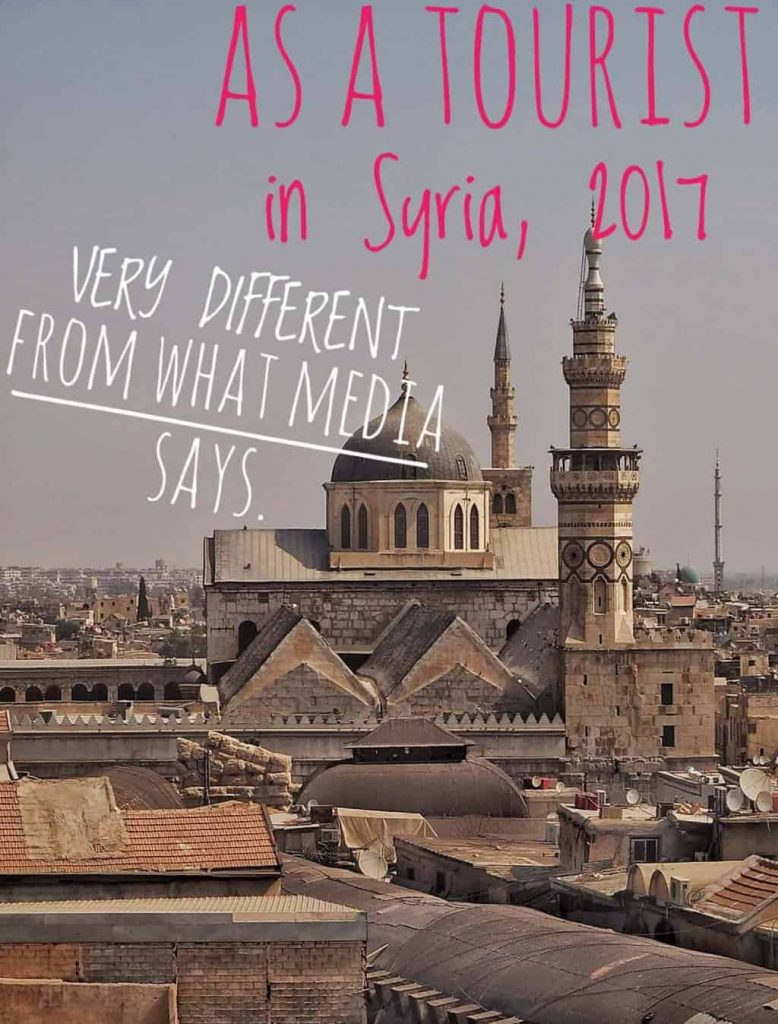

By Christian L. Posted on Published: June 1, 2020 – Last updated: October 2, 2021
In October 2017, was I lucky to be granted a 10-day tourist visa to Syria, almost two years before every other “traveller decided to travel to Syria”.
Friends and family told me I had to be insane and that I must have a death wish to want to visit Syria in 2017. Everyone knows there is a brutal war raging in the country that is heading into its 7th year now.
The people I told about my plans were all saying the chance of entering Syria was around zero and, if I did manage to enter, I would most likely end up getting killed or kidnapped.
So when I finally managed to secure a tourist visa to Syria, I booked the first flight possible to Beirut, the capital of Lebanon, since there are currently no easy flight connections to Damascus and Syria.
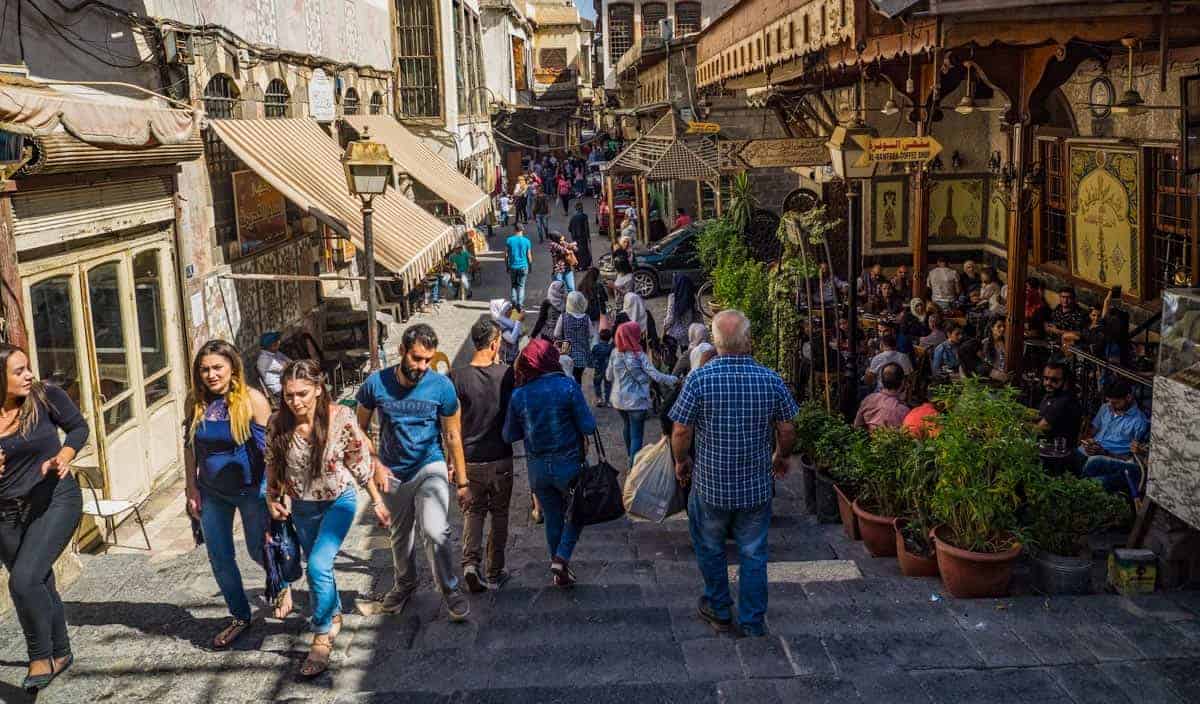
Streets are full of people and Shisha houses are full.
Over the 10 days, I travelled around Syria, I visited Damascus – Aleppo (Read About my visit to Aleppo by clicking here) – Homs with the countryside around it, and the Mediterranean coast before I went back to Lebanon for my flight back home to Europe.
I went to Syria with an open mind and with no political intentions at all.
How´s Damascus these days, after the war
To obtain a visa for Syria these days, you will have to get a recommendation from someone with contacts inside the country, fill out some paperwork, wait for around 9 – 10 weeks to get an answer, and pray that you will get accepted.
Most people don´t even receive an answer.
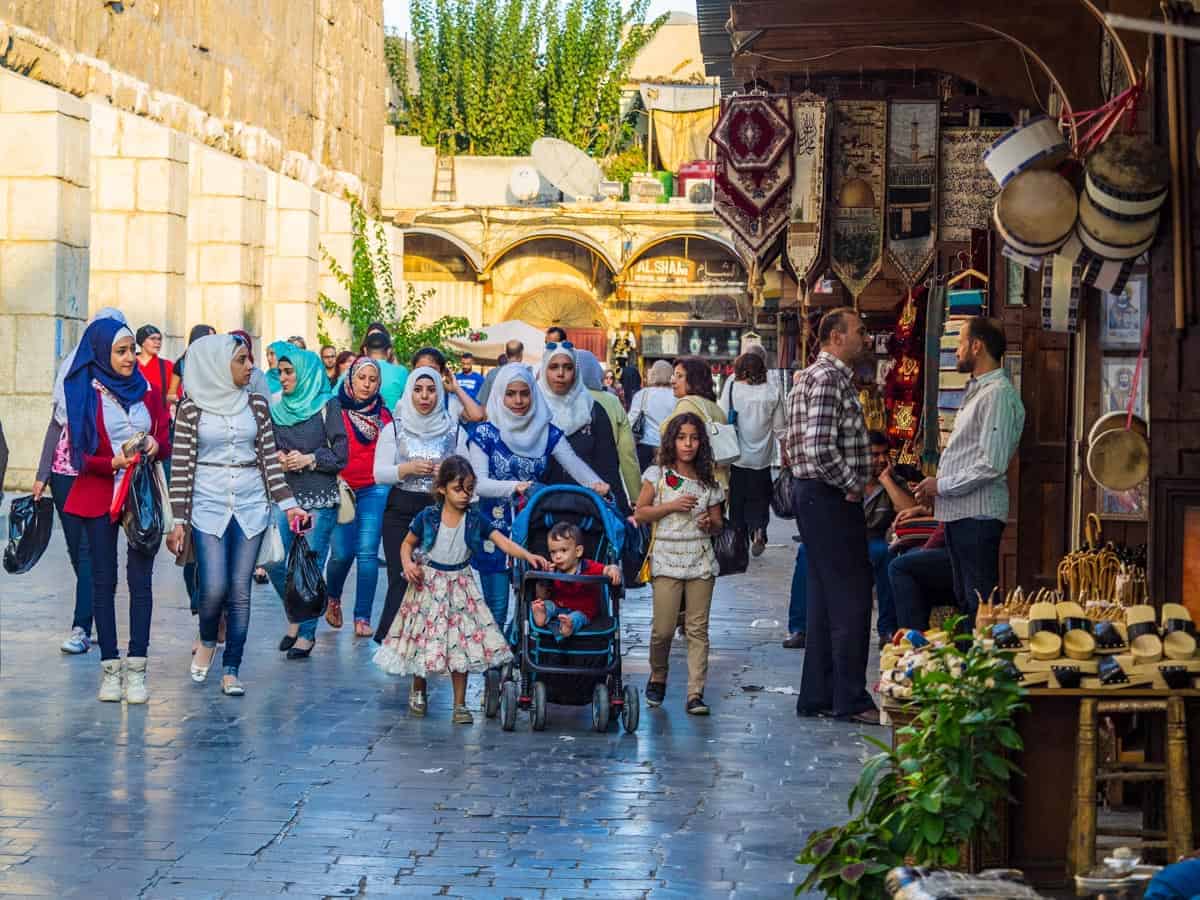
Local families in the street, all souvenir shops are open.
I left my hotel in Beirut in the afternoon with a shared taxi heading for Damascus and I would be lying if said I wasn’t excited about my trip into Syria.
The trip between the two capitals is no more than 120KM /75Miles, a journey that used to take only around 2 hours to travel between before the war, including immigration procedures.
With the circumstances these days I would be happy if I could just make it across the border and into Syria at all.
Leaving Beirut proved to be the most time-consuming on my whole trip to Damascus since I got stuck in the notorious Beirut traffic jam when leaving the city centre.
When entering the immigration office on the Lebanese side of the border I noticed early on that myself and the 5 other westerners I was travelling with was not the only foreigners crossing the border.
There were another 9 Europeans together with the tens of locals exiting Lebanon at the same time as me (the border is open 24/7). Exiting and get stamped out of Lebanon only took a few minutes.
Here´s a short video from my trip to Syria, filmed with GoPro.
The first thing I noticed when entering the Syrian side of the border is how organized and calm everything was. People are lined up in queues.
There are no soldiers around and only a few welcoming border guards. To make a long story short, the Immigration on the Syrian side took only around 20 minutes before I was stamped into the country and ready to go.
I entered Syria just in time to hear the 7 PM call to prayer from the Mosques in the distance.
When leaving the border to head towards Damascus there are a few military checkpoints to go through.
None of them was any problem at all and every single soldier greeted me and my friends with a big smile, a handshake, and a “Welcome to Syria My Friend.”
The first thing to notice when arriving in Damascus is all the street life going on; young couples holding hands in the streets, shops open everywhere, shawarma stalls next to tea and coffee stalls and, in general, the streets are full of people like in any other country.
There are no signs of war going on except the few relaxed soldiers sitting on a street corner.
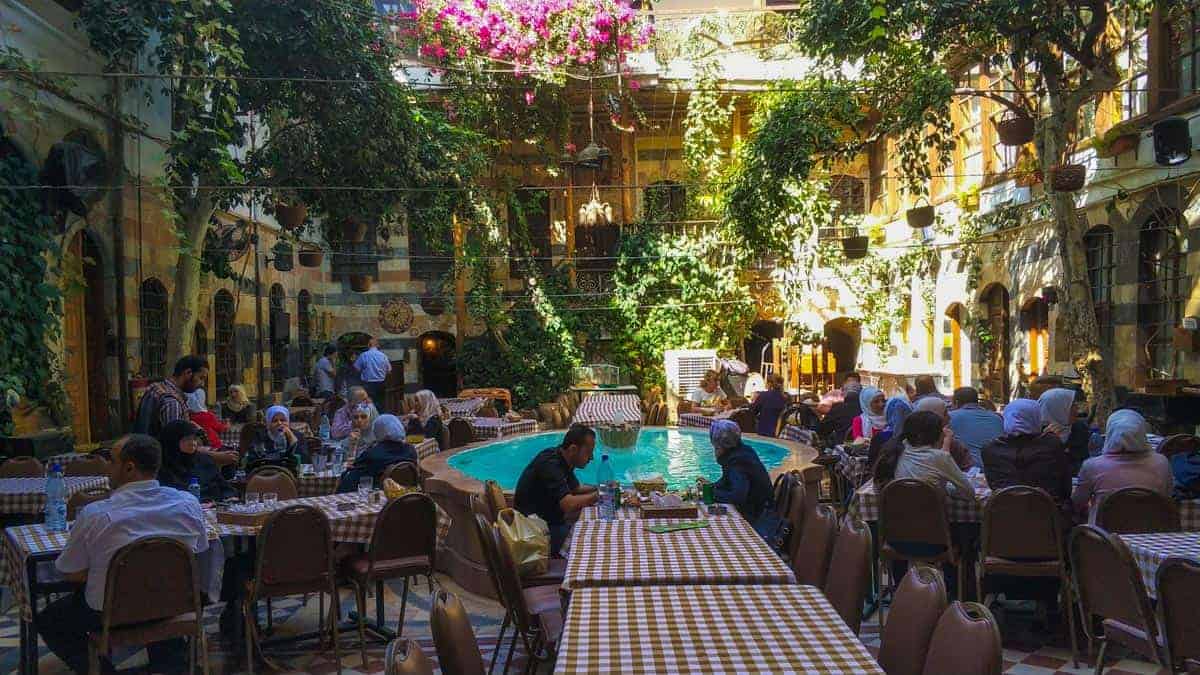
Traditional Restaurant in an old home.
I only went for a fast dinner and a few beers in a traditional restaurant full of people before heading to bed.
I wanted to be fully rested and up early to explore the streets of Damascus the next morning.
After waking up early to walk around of the oldest cities in the world, I left my hotel in the old city and you quickly notice the smell of fresh bread.
The milkman is on his bike delivering milk around the old narrow streets and the fruit and vegetable stalls are full of fresh fruit and vegetables.
Established between 10,000 to 8,000 BC, Damascus is credited with being the oldest continuously inhabited city in the world.
Things To do in Damascus
When walking around the old city, you start to wonder if there is even a war going on. There´s absolutely no damage here. All shops are open and the streets are bustling with life.
There are a few military checkpoints here and there but you don´t really notice them.
Even here the soldiers are happy to see tourists. Shopkeepers are overwhelmed with happiness when they see that tourists are back in town.
You are completely free to travel around Damascus on your own. You can take photos of everything you want except for military checkpoints and government buildings.
It´s very easy to forget that you’re in a country that ravaged by war when visiting Damascus but then you suddenly hear rocket hitting the terrorist-infested Jobar district only two km away in a straight line from where I’m staying and enjoying life.
Between 10 – 30 rockets, I could hear a day.
Just like before the war, there is plenty to see in Old Damascus – The Umayyad Mosque, the 4th holiest place in Islam, take a walk around The Souq al-Hamidiyya (old market), visit The Damascus Citadel or just get lost in the narrow streets filled with a century after century with history.
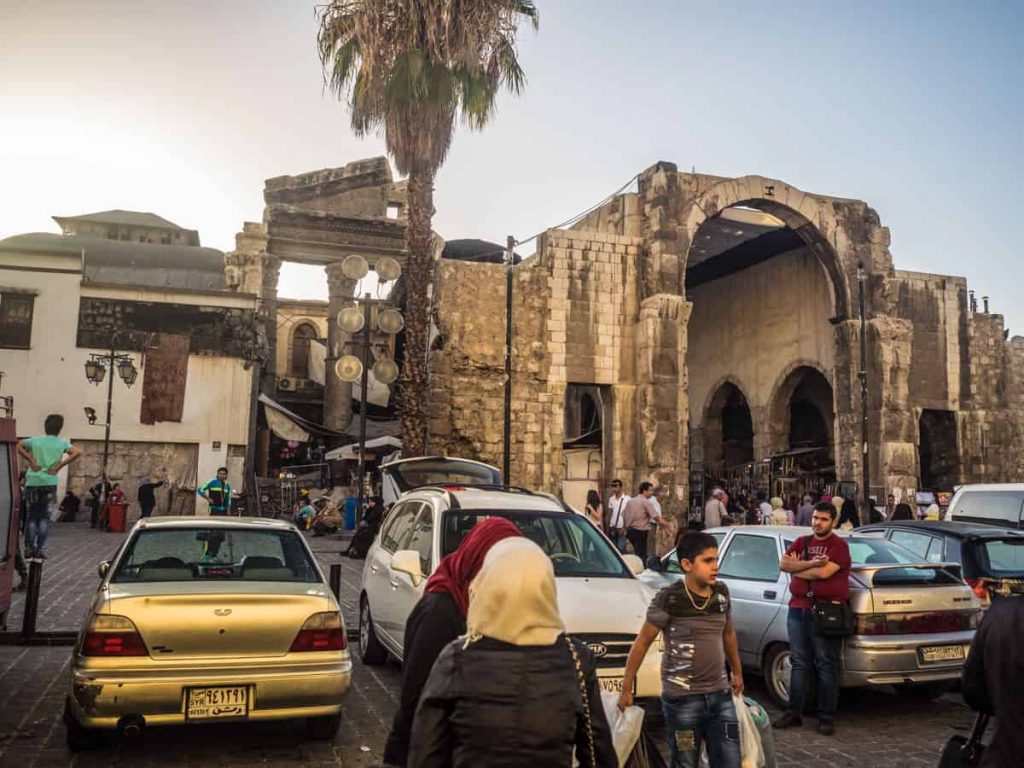
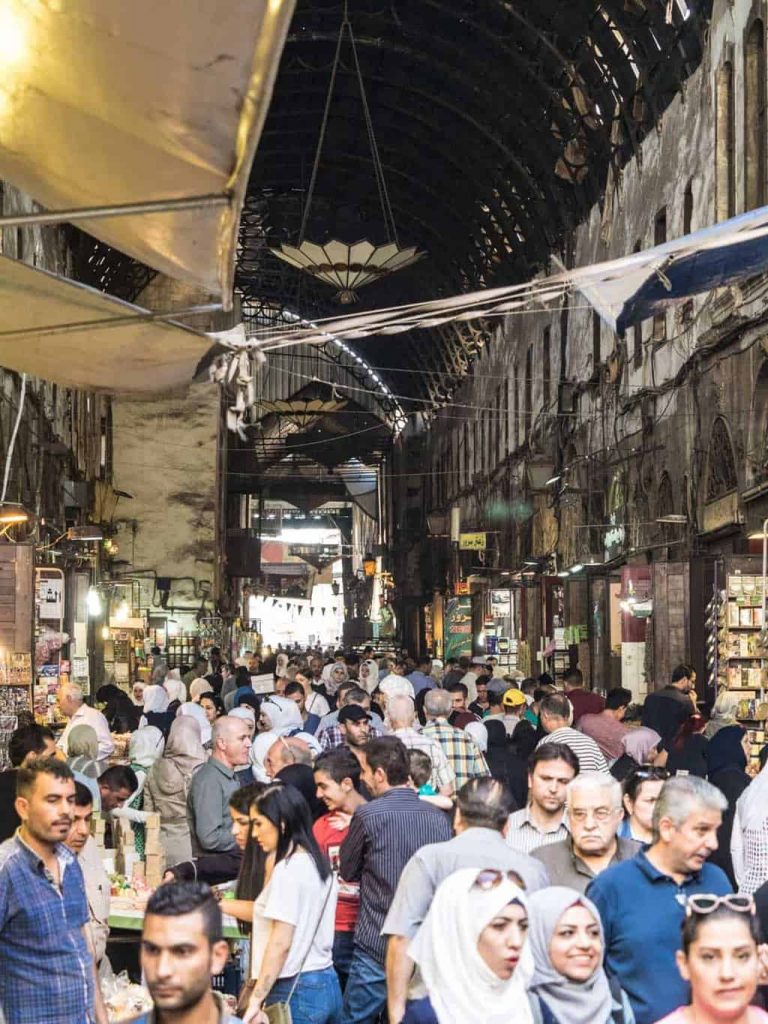
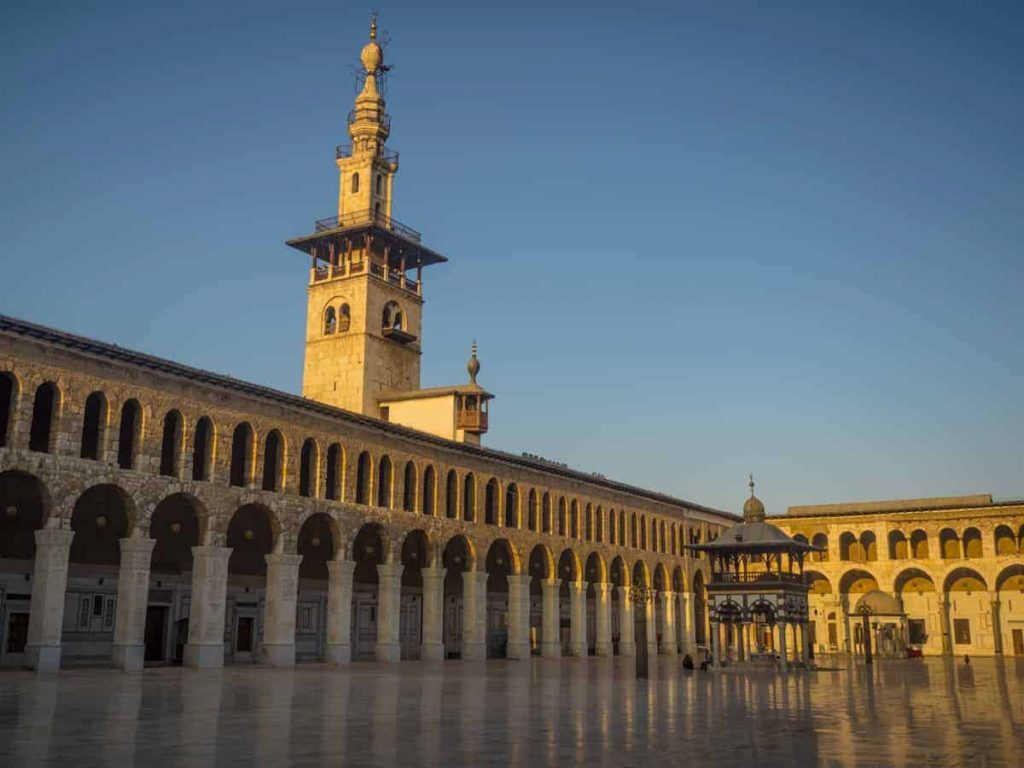
If you get tired of walking around the streets, just walk into an art gallery to have a look at modern art in Syria, relax in a local Hooka cafe while looking at bustling street life or listen to a local storyteller. Everything here is just like it was before 2011.
But like before 2011, so is the Old Town of Damascus the place you to stay to explore.
The only real reason to head into to a modern part of Damascus is if you need to do some proper shopping at a western-style shopping mall or to visit a supermarket just as well-stocked as any supermarket back in Europe or America. Everything is available here.
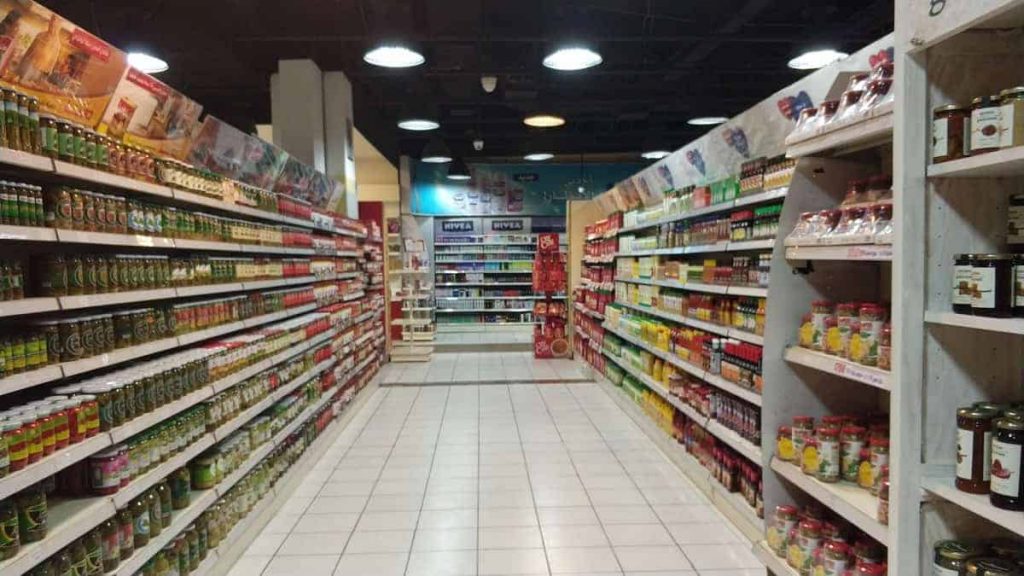
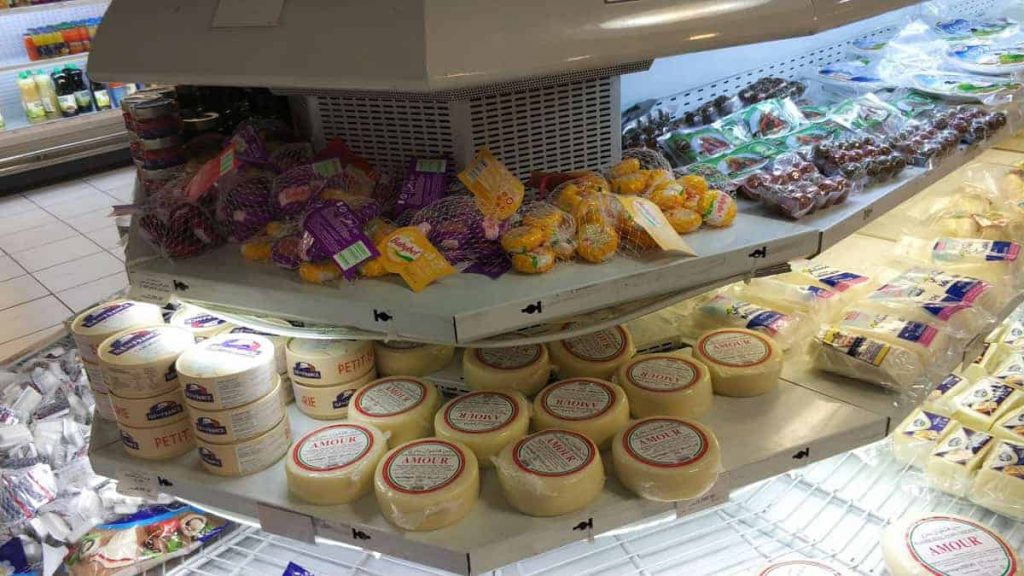
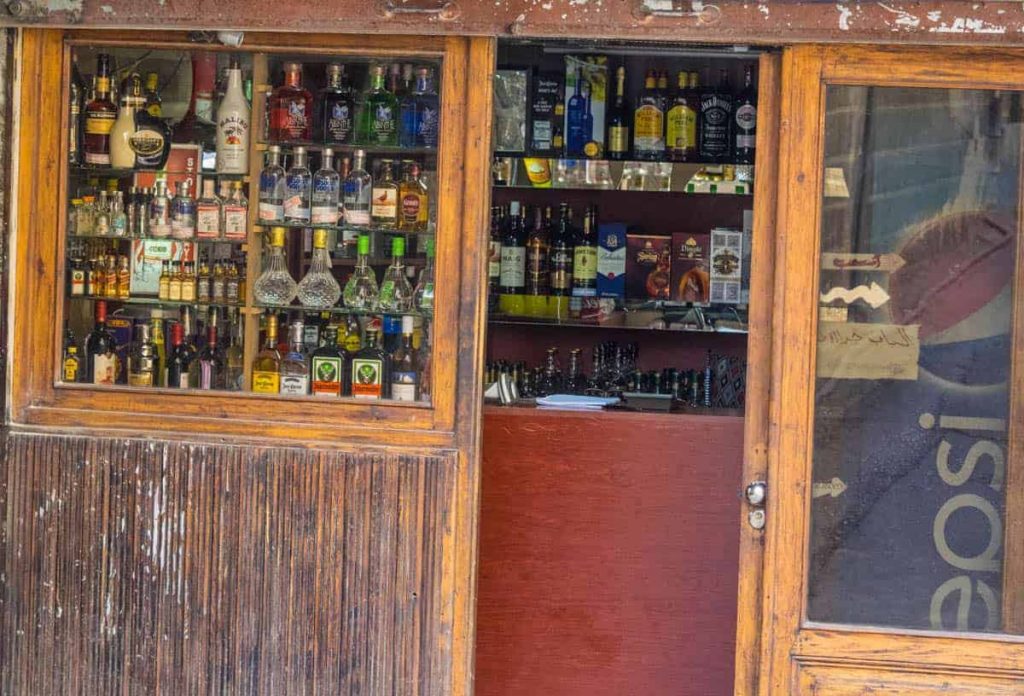
Overall, Damascus is so completely opposite of what the media has been telling us for the last 7 years. So I wonder if the journalists have actually ever been here themselves.
Christian churches are located right next to Mosques. Both are filled with people. Even the Jewish Synagogue in the Old City of Damascus is still open.
You will see Christian weddings around the city and Priests walking around in public. And in general, are Damascus residents enjoying life.
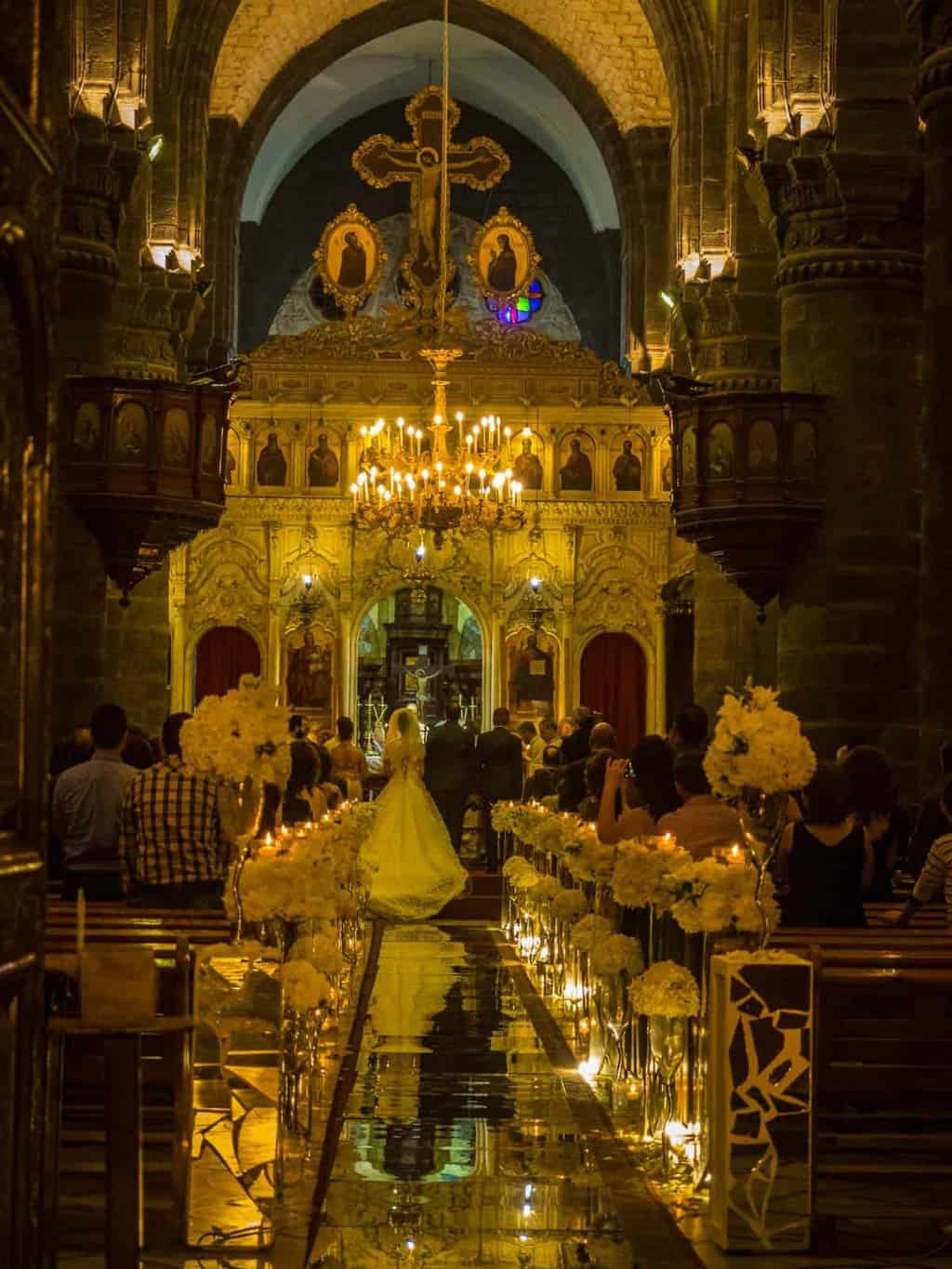
In the afternoon, the bars and pubs are filled with locals that enjoy a few beers and drinks together with watching European football on big screens.
And all of them are welcoming to you as a tourist. I went out drinking with the locals to 2 am before walking back to my hotel on my own.
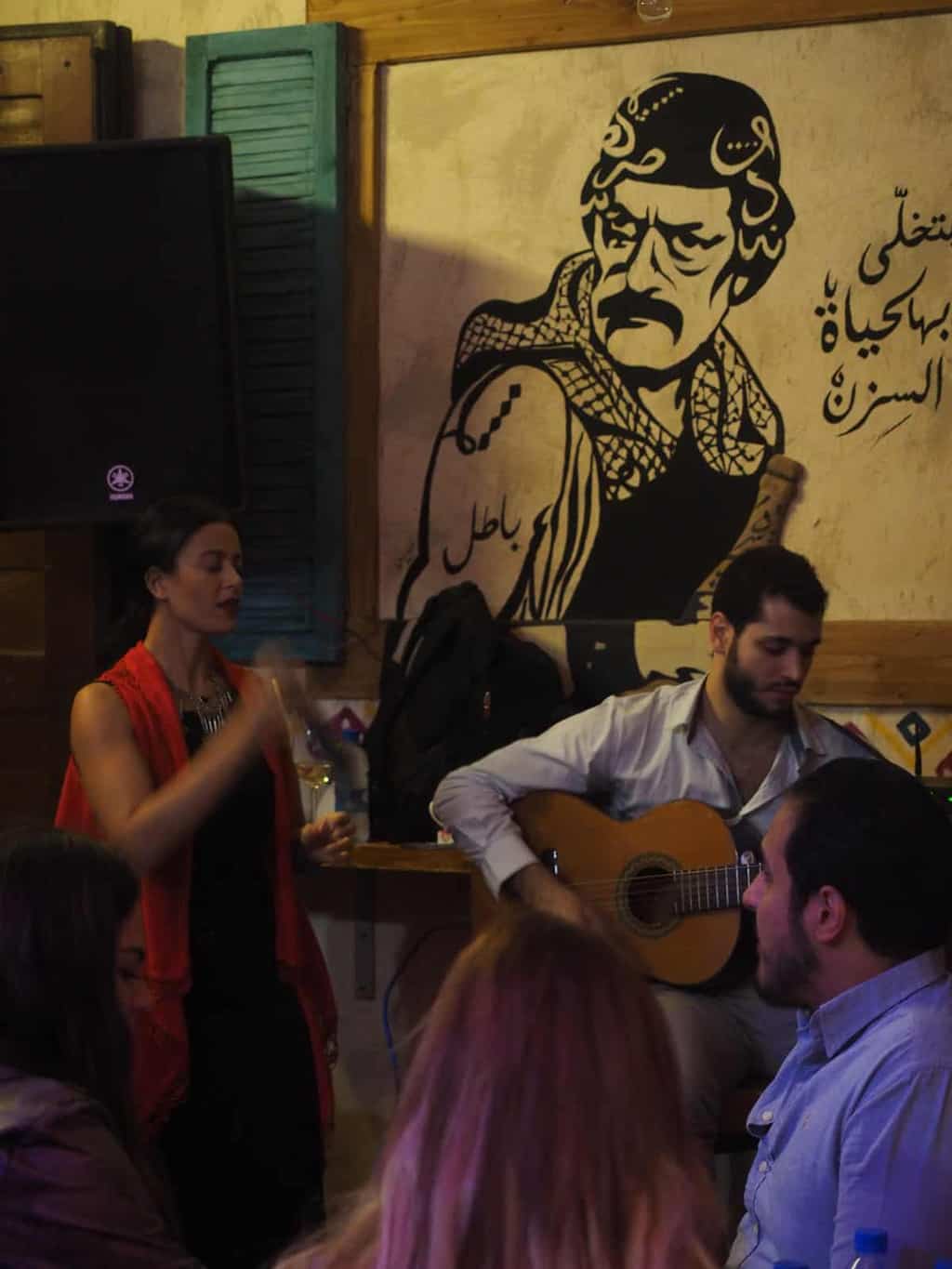
Locals out enjoying live music
I was lucky enough to walk around and explore Damascus for 3 full days. Never did I experience any hostile or unfriendly people.
Everyone was so happy to see that tourists are back in town.
Visiting Damascus in 2017 as a tourist feels just like being home in Norway or walking around Barcelona or any big western city. Damascus is very safe and ready to welcome tourists back.
After 3 Peacefull days in Damascus was it time to leave the capital and travel north to Aleppo. Click here to read.
Travel To Aleppo as a tourist, Syria
By AuthorChristian L.Published: November 1, 2017 – Last updated: October 2, 2021
After spending 3 great days in Damascus, was it time to travel to northern Syria and to Aleppo, which was before the Syrian Civil war the largest city in Syria.
But to get to Aleppo, did I have to drive along the world´s most dangerous road, the Salamiyah – Ithriya – Khanasser Road, notorious for being attacked by Daesh (ISIS) and Al Qaeda, and getting shut down for days.
And yes, Daesh (ISIS) attacked the road the same day I travel it as well, less than 1hour after I passed by it.
After spending 3 great days in Damascus, was it time to travel to northern Syria and to Aleppo, which was before the Syrian Civil war the largest city in Syria.
But to get to Aleppo, did I have to drive along the world´s most dangerous road, the Salamiyah – Ithriya – Khanasser Road, notorious for being attacked by Daesh (ISIS) and Al Qaeda, and getting shut down for days.
And yes, Daesh (ISIS) attacked the road the same day I travel it as well, less than 1hour after I passed by it.

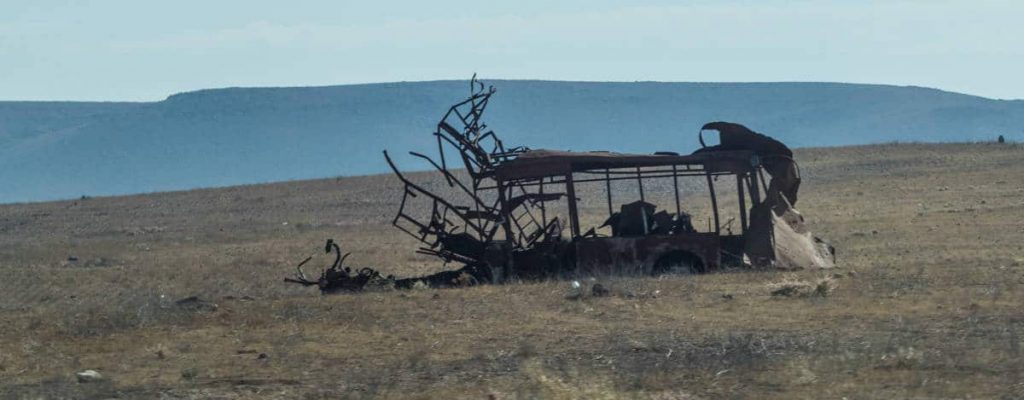
The road between the two biggest cities in Syria used to take only 5 hours to drive; however, these days, it will take you between 7 to 9 hours.It´s now really easy to visit Syria; click here to read about the travel guide about how to get the visa in less than 48hours.
Watch this 3min long video that I filmed with my GoPro during my trip to Syria.
Mostly because of the detour you have to take along Salamiyah – Ithriya – Khanasser road (The highway is off-limits since it goes through deep Al Qaeda land), and there a few compulsory military checkpoints with friendly soldiers who do papers checks. This rarely takes more than a minute or two. UPDATE, the M5 highway to Aleppo reopened in early 2020.
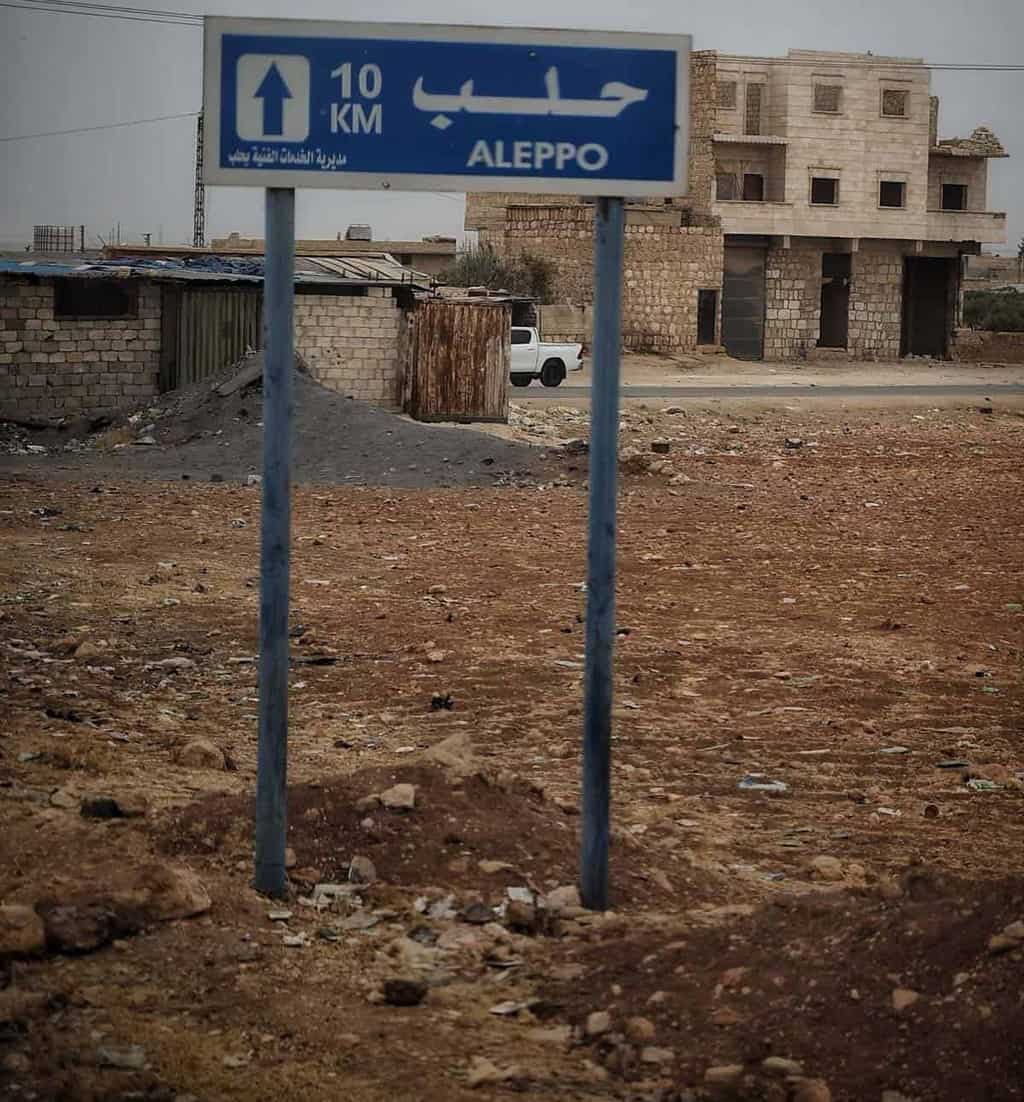
Getting close to Aleppo now.
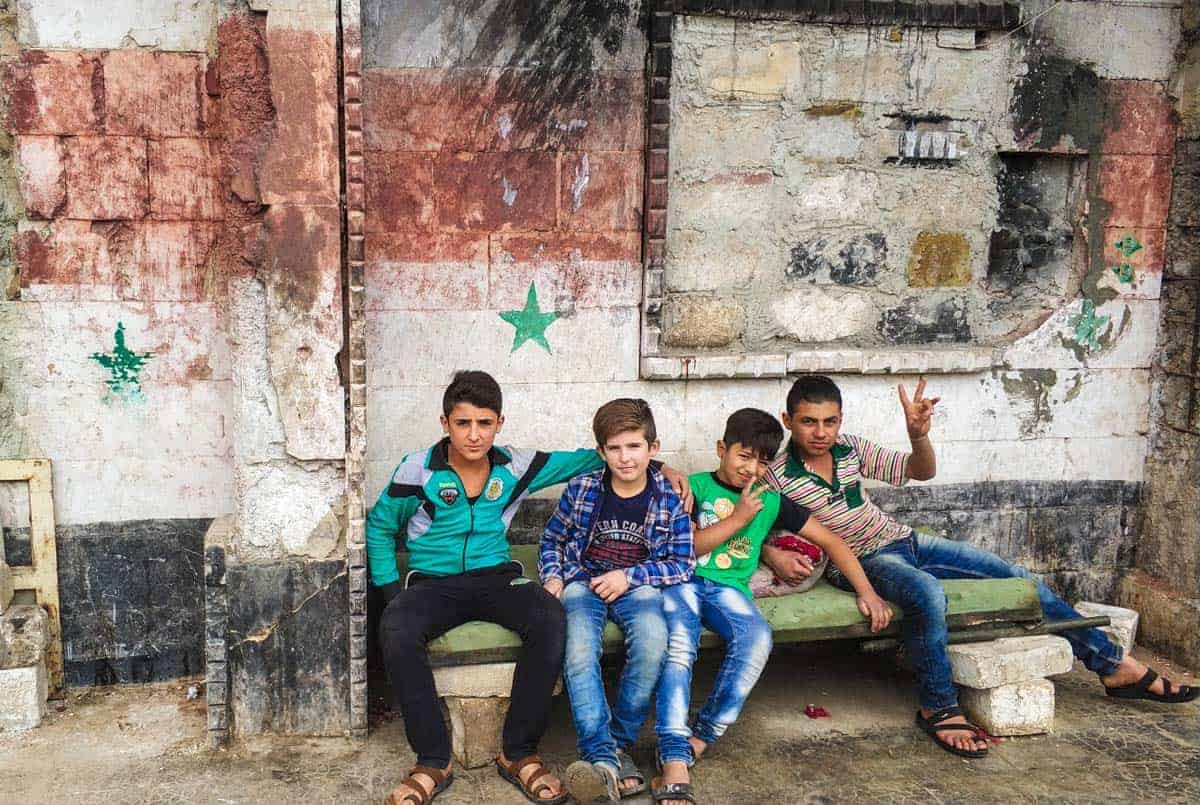
Local kids posing for a photo when having a fast drink stop.
When you finally reach Aleppo, you will go through the broken parts of East Aleppo, the places where some of the most fierce battles in the war happened.
There are three sides to every story: yours, theirs, and the truth somewhere in the middle.
But it doesn’t take long before you notice that only a small part of Aleppo is destroyed; as soon as you reach central Aleppo, the city is bustling with life, just like Damascus. So too are the shops, restaurants, supermarkets, and parks filled with people.
Yes, There´s a lot of destruction in Aleppo, especially the historical old part of town with the Souq (market) and surrounding areas are mostly destroyed, but rebuilding has already started.
But there’s far less destruction in Aleppo than what the media has been telling us; only about 20% of Aleppo is destroyed or damaged. The city centre is mostly unharmed.
Contents [hide]
- But there’s far less destruction in Aleppo than what the media has been telling us; only about 20% of Aleppo is destroyed or damaged. The city centre is mostly unharmed.
- I was never told that I could not visit an area, or even told that I wasn’t allowed to take photos!
- The Remains of The Old Souq.
- Umayyad Mosque, The Great Mosque Of Aleppo.
- Aleppo Citadel after the war.
- Like It? Share It! Pin It!
The university is open together with 913! schools, the local trains are running, and there are seven public transportation routes around the city.

Aleppo Trains station, there’s a local train running, the station opened in 1912! On the 25th of January 2017, train services resumed in Aleppo for the first time in four years.
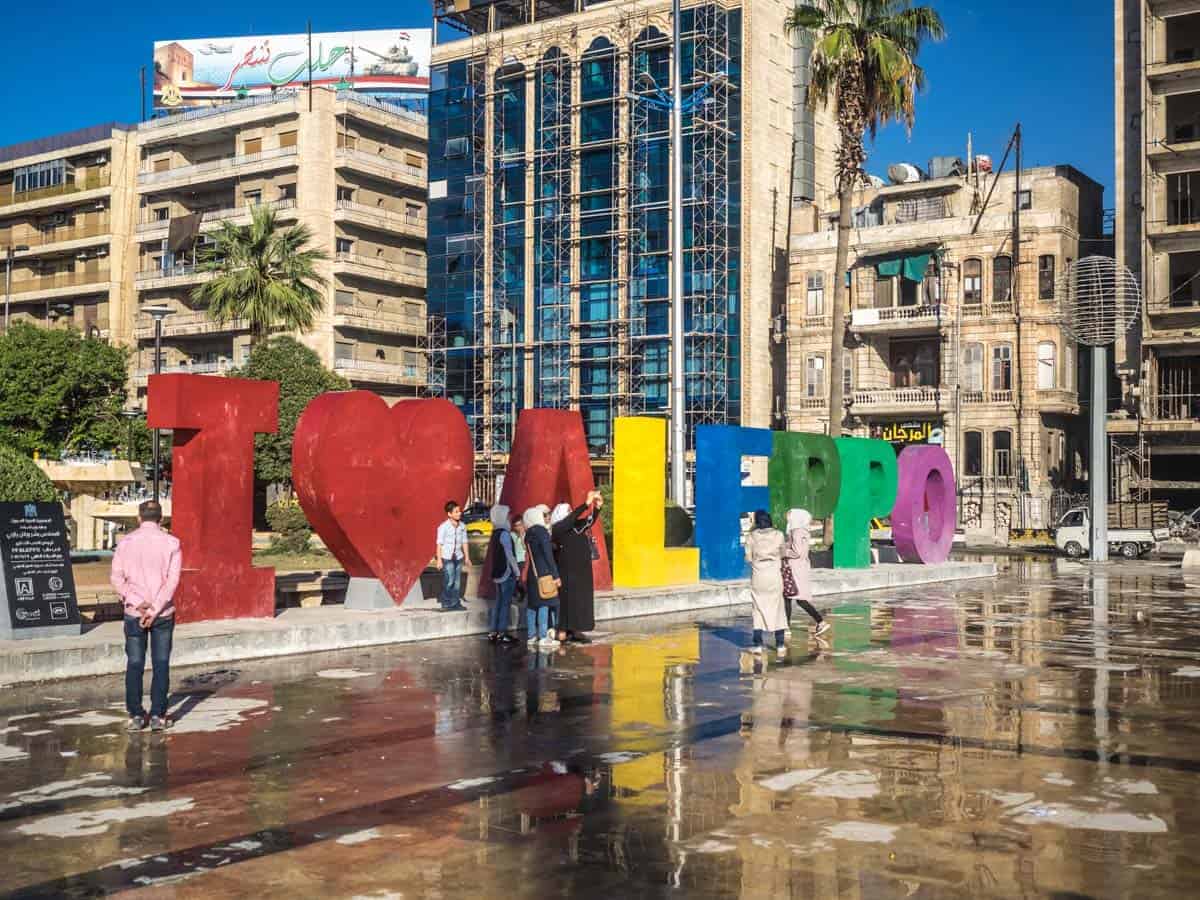
The I Love Aleppo sign is a popular selfie spot for locals; notice the rebuilding of the hotel in the background.
As a foreigner in Aleppo, you may think that big parts of the city were off-limits? Not at all! I was granted full access to inside the Aleppo Citadel, to walk around the old Souq, visit the devastating remains of the historic Umayyad Mosque, and to visit East Aleppo. I was in the Citadel before CNN, BBC, etc. This was in 2017 before Syria started to reopen for tourists.
I was even allowed to visit a school that Desh (ISIS) and Al Qaeda used as headquarters.
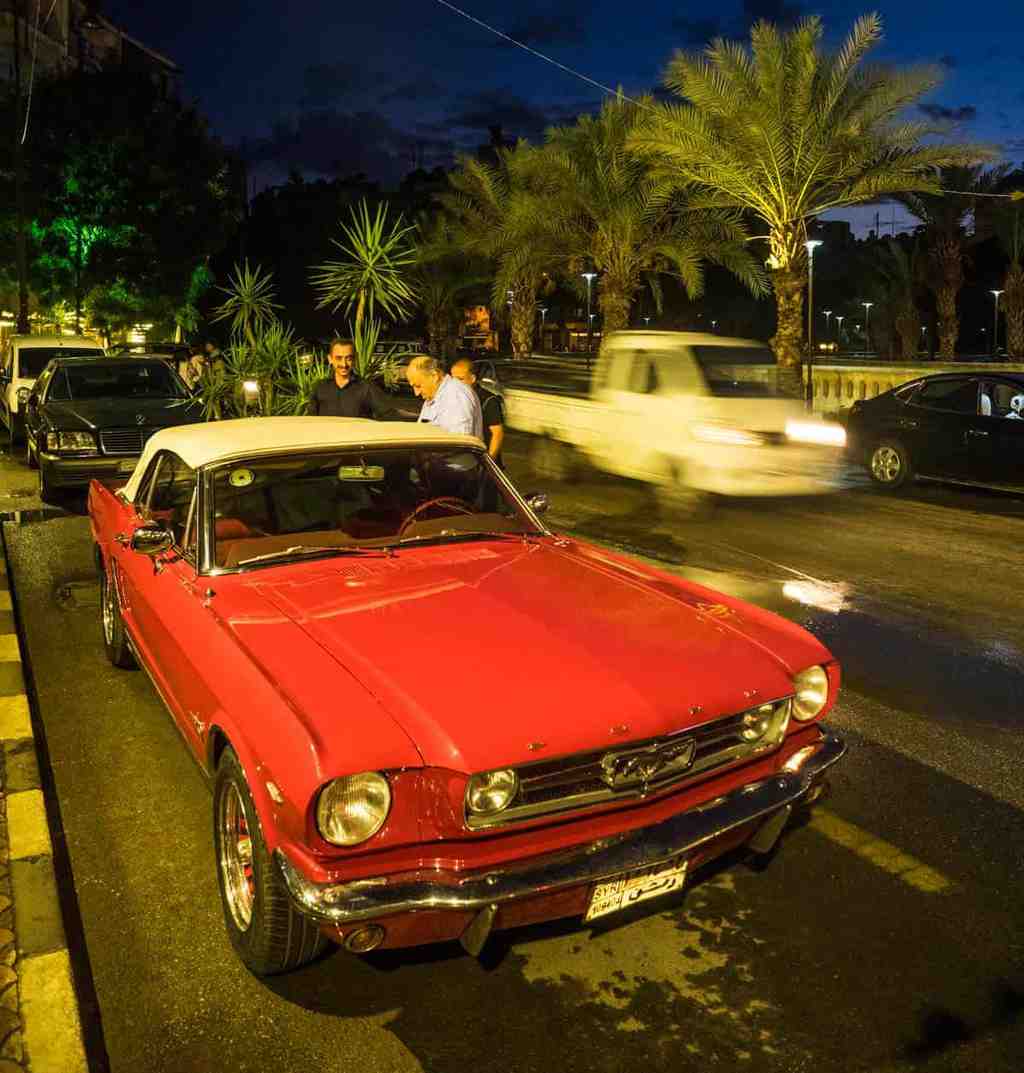
Not what you expect to see in Aleppo? An American Sports car and a palm tree-lined boulevard. You do see a few American sports cars around the streets of Aleppo.
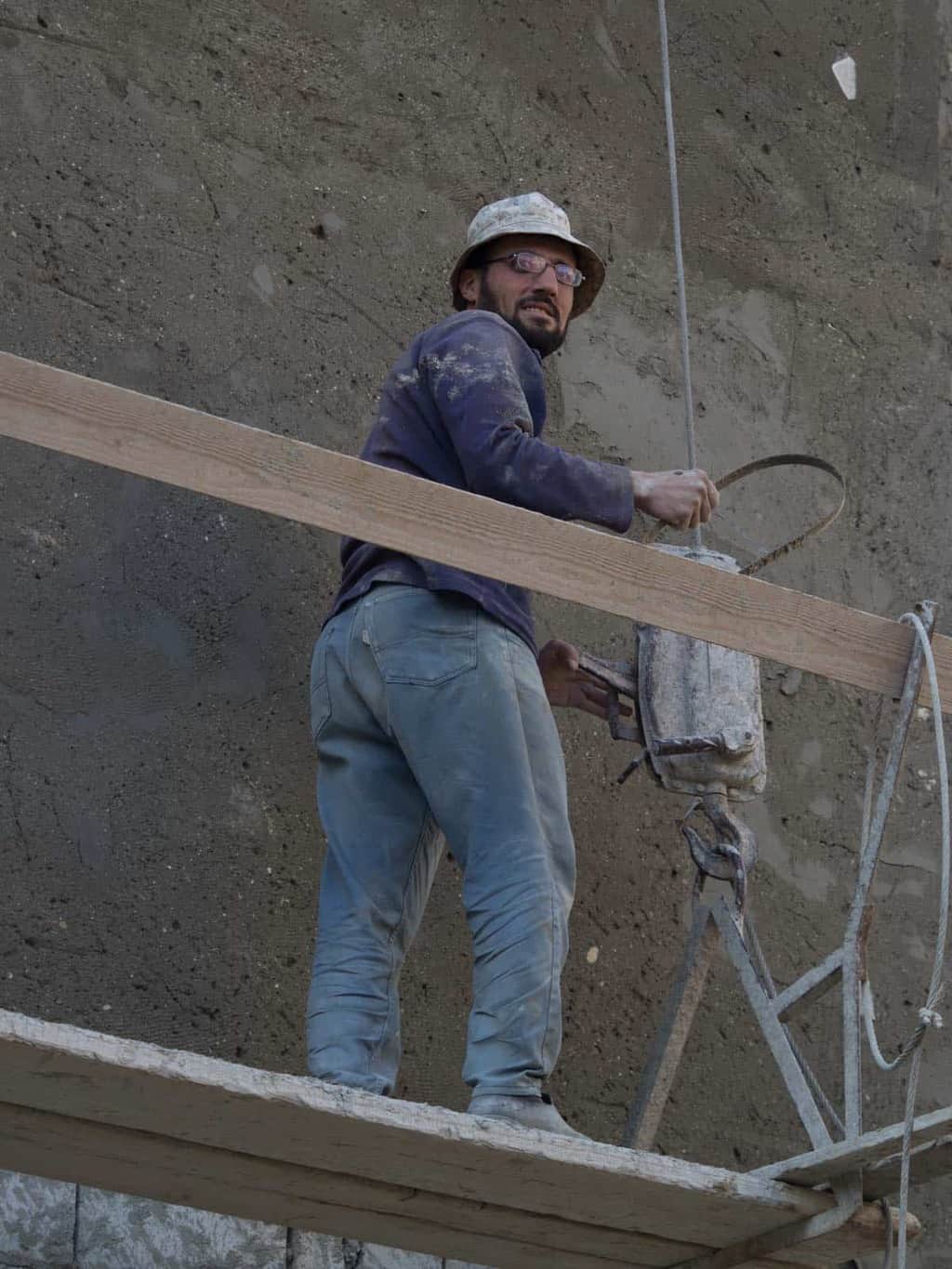
Rebuilding is happening all over Aleppo.
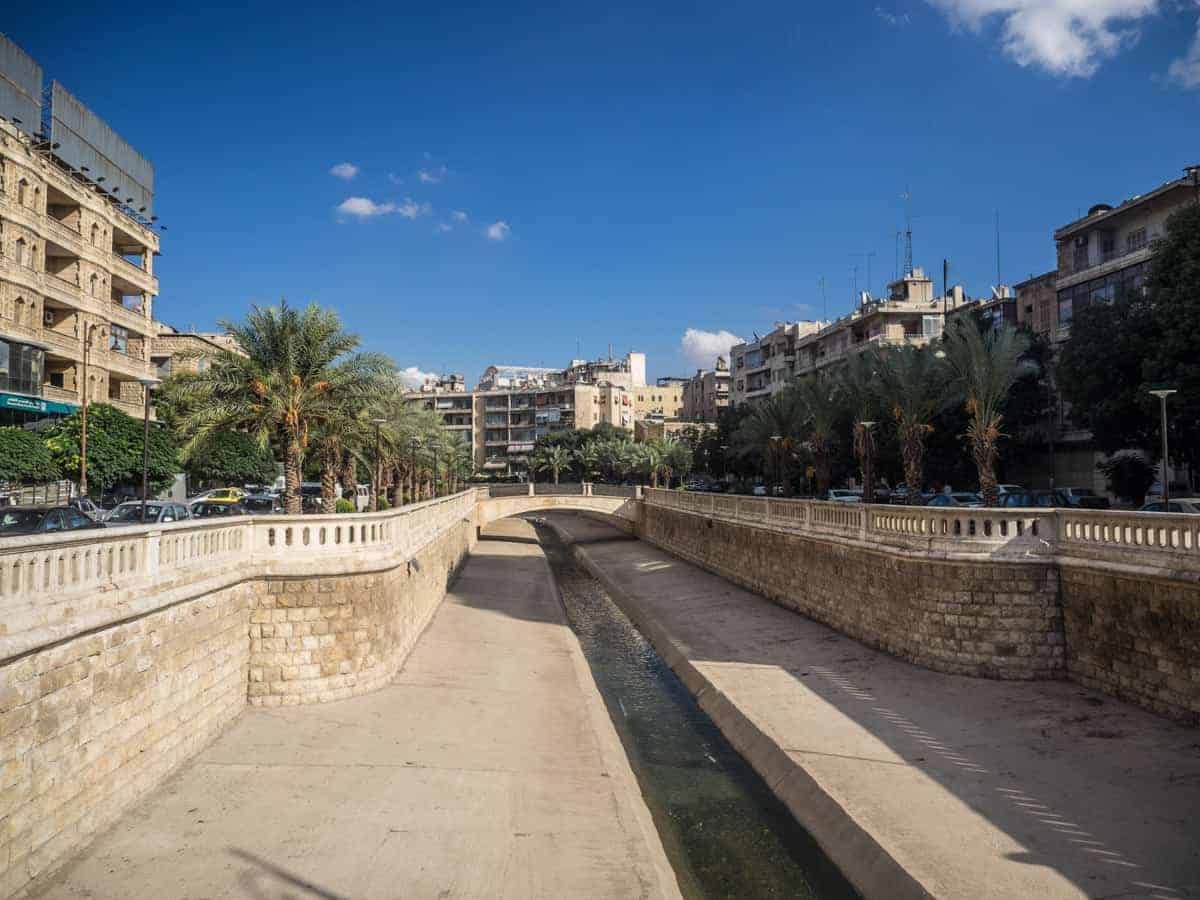
The streets of Aleppo.
I was never told that I could not visit an area, or even told that I wasn’t allowed to take photos!
Before the war in the Old City of Aleppo is one of the highlights of every trip to Syria; it was even added to the UNESCO world heritage list all the way back in 1986!

The Aleppo Citadel from the eastern side. There are tons of photos from the Citadel further down on this post.
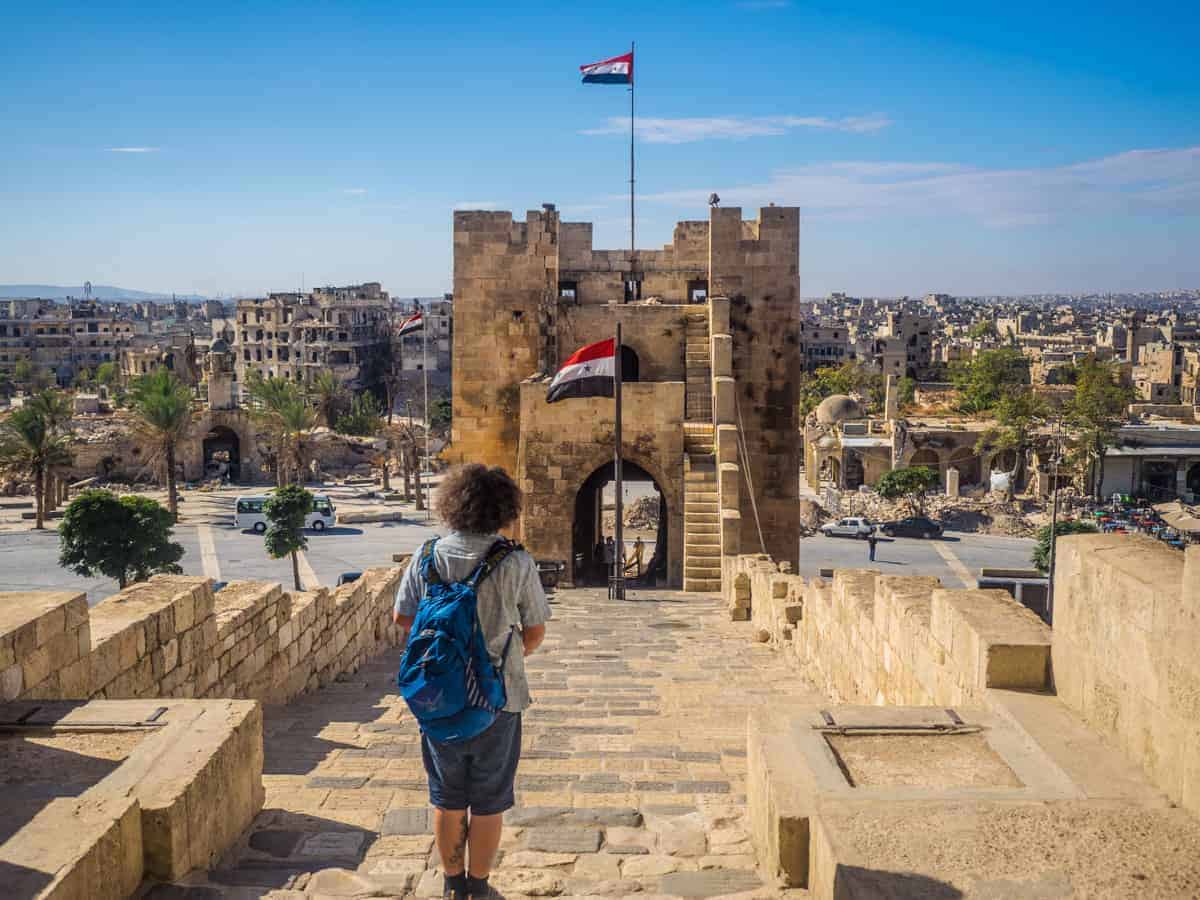
Me leaving the Citadel, I’m probably the most obvious looking tourist in all of Syria. Notice that the restaurant on the far right side of the photo is open again!
From the UNESCO website:
Located at the crossroads of several trade routes from the 2nd millennium B.C., Aleppo was ruled successively by the Hittites, Assyrians, Arabs, Mongols, Mamelukes and Ottomans. The 13th-century citadel, 12th-century Great Mosque and various 17th-century madrasas, palaces, caravanserais and hammams all form part of the city’s cohesive.
It´s heartbreaking to walk around the Old City of Aleppo and see all the destruction that happens here. But where there’s sorrow, there´s hope.
A few shopkeepers in the old Souq are working every day and night to rebuild (in the original style) and reopen their shops, and there are stonemasons working at the entrance of Aleppo Citadel, the jewel of the Middle East.
So where is Aleppo actually? Aleppo is located in the northwestern part of Syria. only about 30 miles (50 km) south of the Turkish border.
The Remains of The Old Souq.
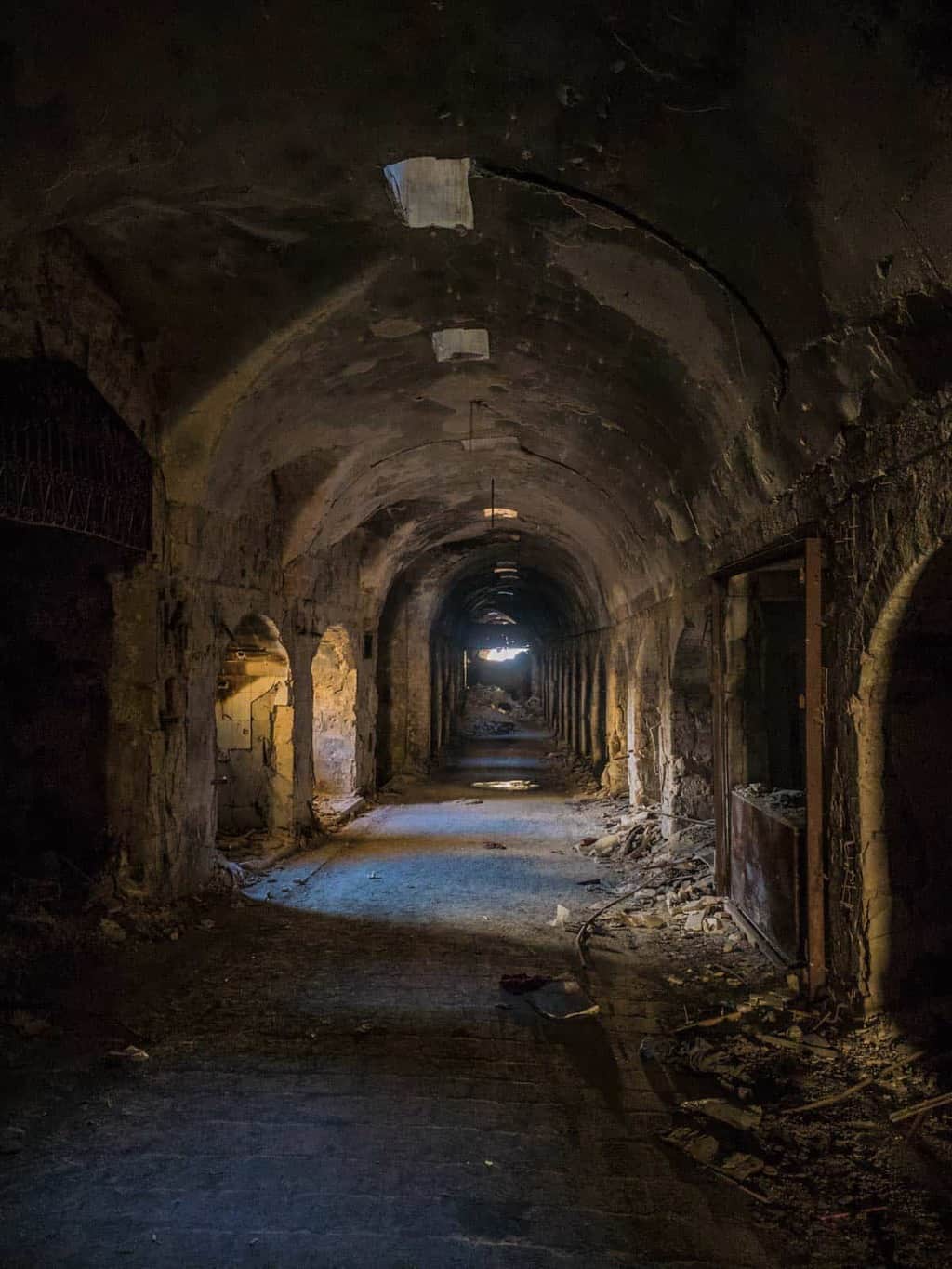
From Inside the Souq, most of it looks like this part.
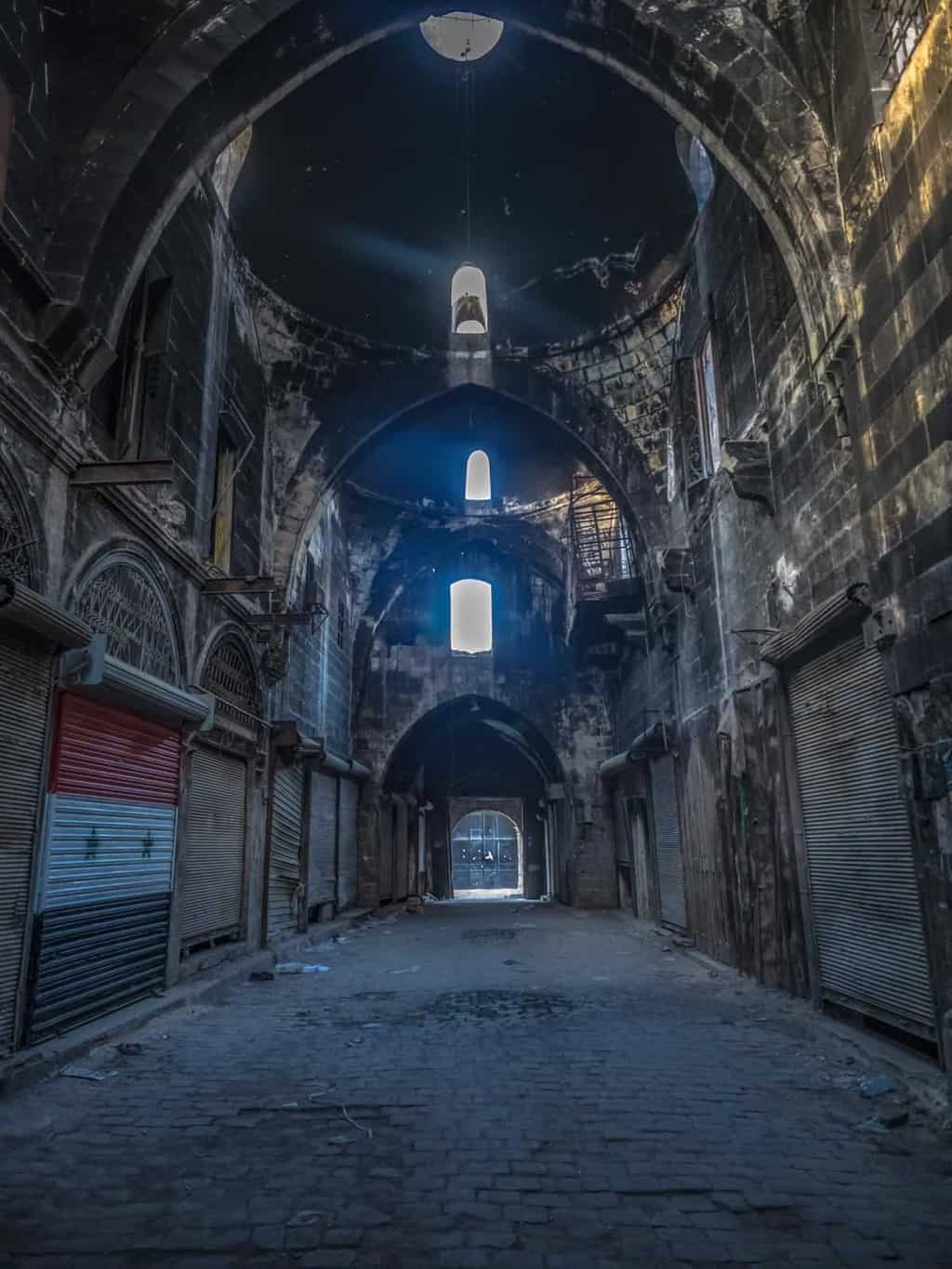
But luckily, so are some parts of the Souq almost untouched.
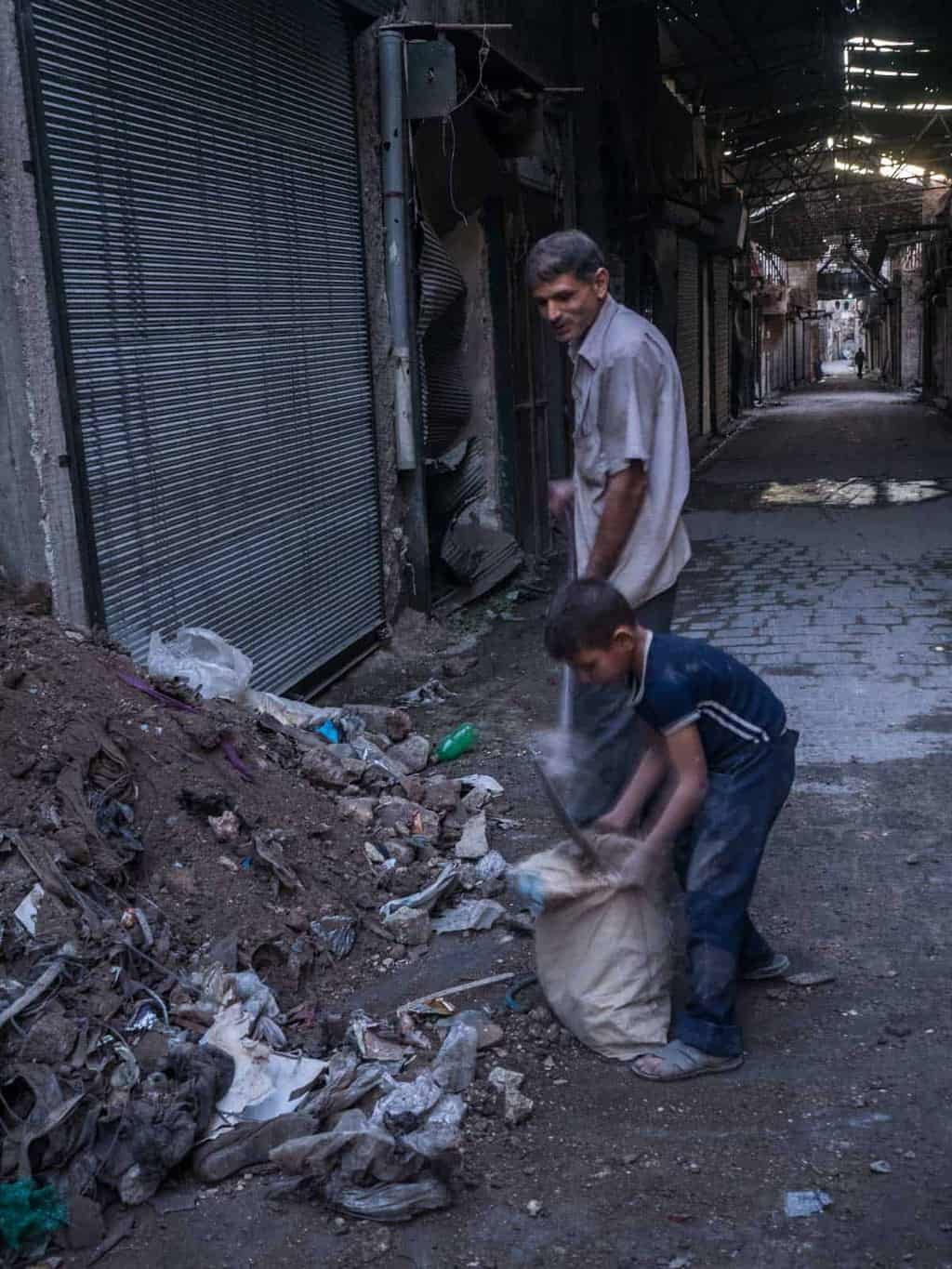
Father and son cleaning out the damage to their shop in the old Souq.
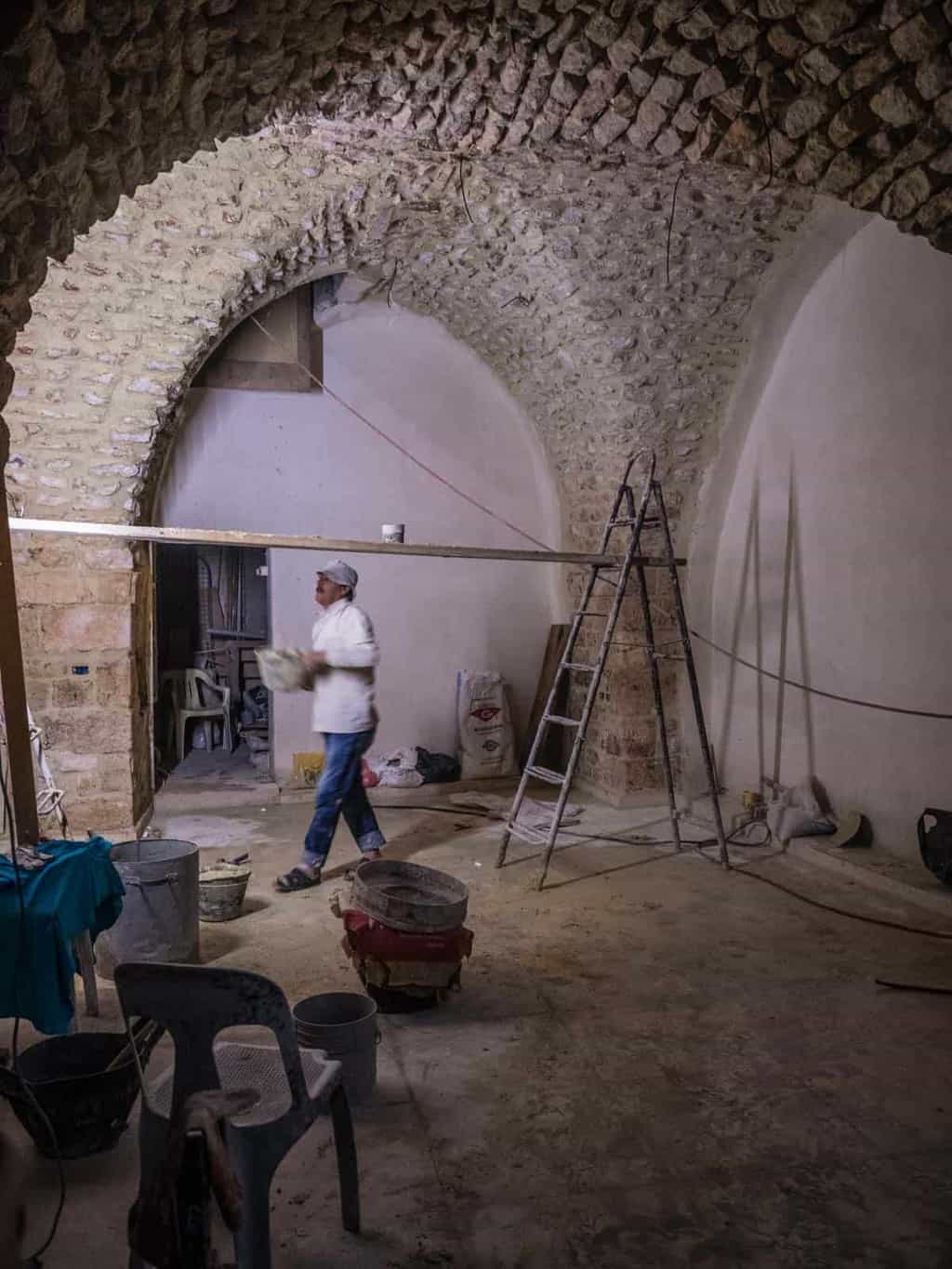
Some shops are almost rebuilt, notice that it’s rebuilt in the original style.
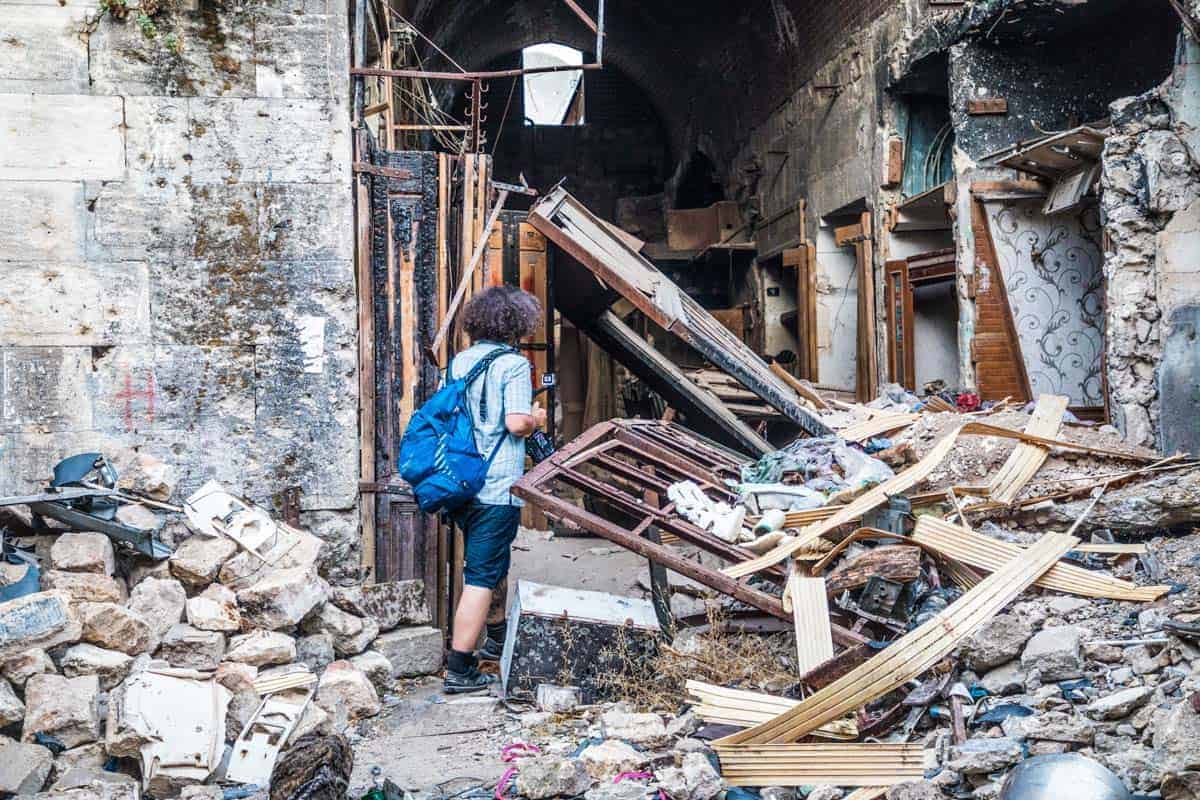
I like exploring!
Umayyad Mosque, The Great Mosque Of Aleppo.
The Umayyad Mosque was the largest and oldest mosque in Aleppo; it dated back to the year 715 and was one of the most beautiful mosques in the world, especially because its minaret was considered to be a national treasure, but unfortunately, it was blown up in on 24 April 2013 by Al Nusra (Al Queada).
The whole mosque is now planned to be rebuilt and restored to its former glory.
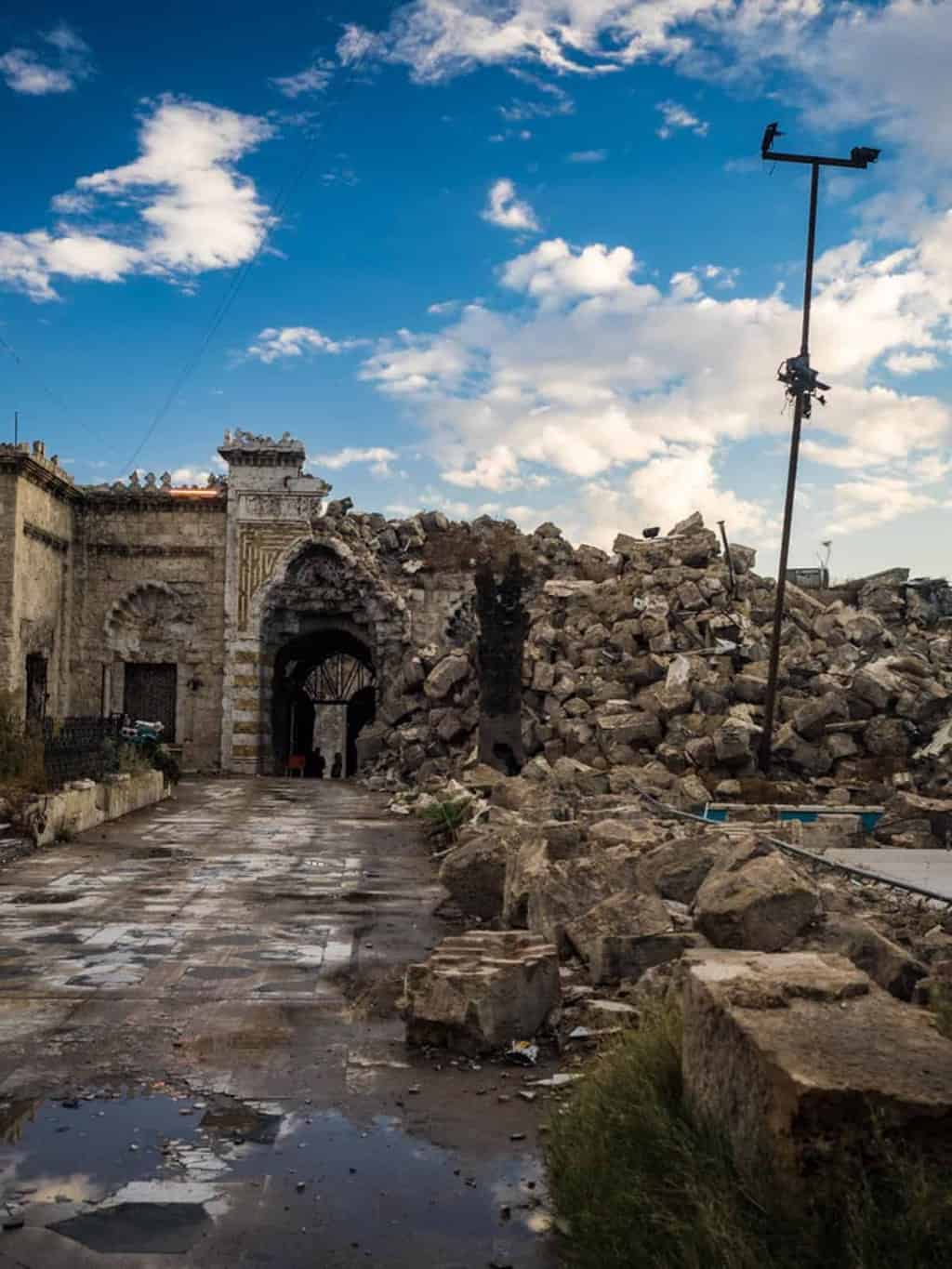
The entrance to the Grand Mosque, the Minerat, used to stand on the right side.
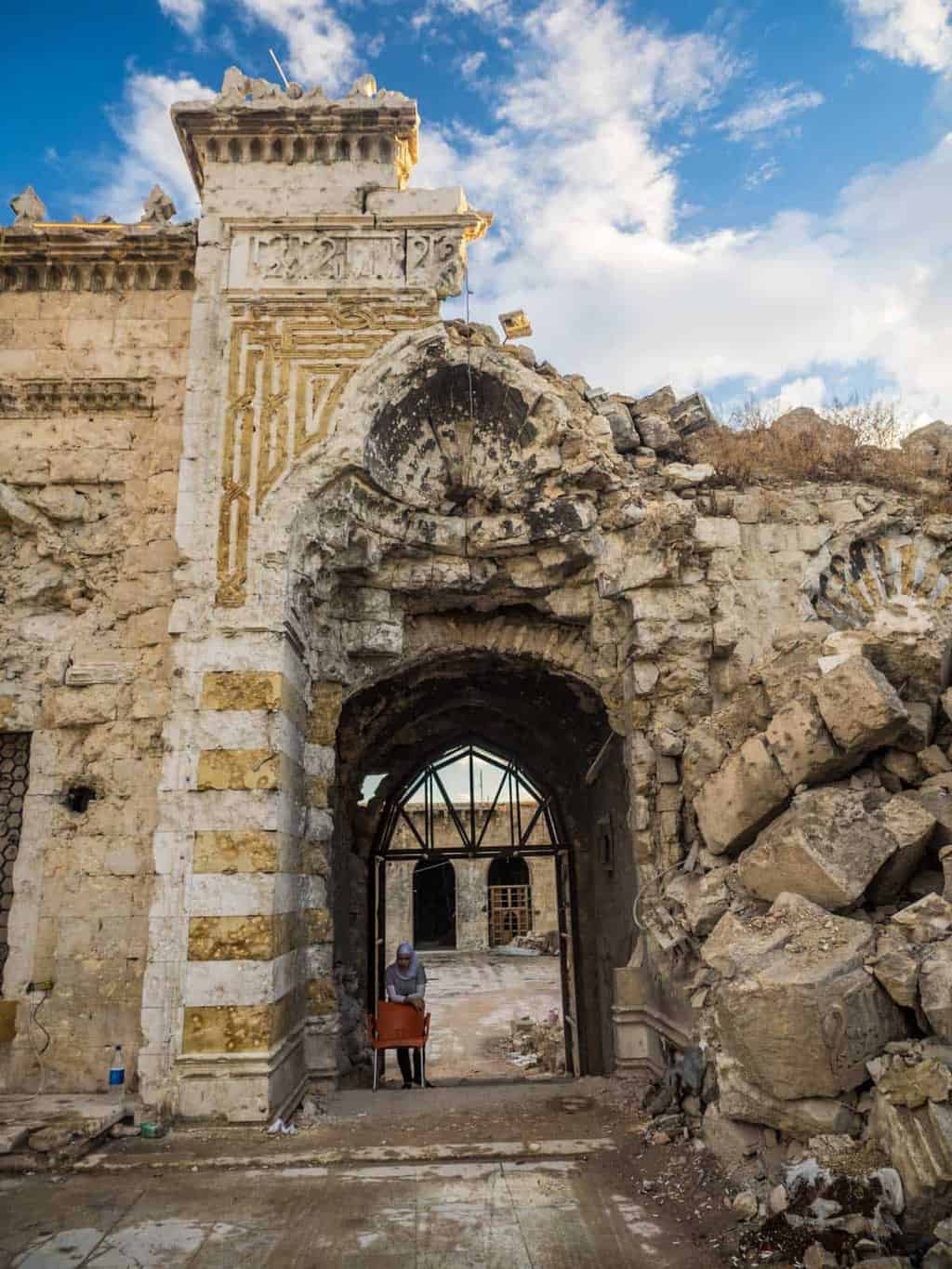
The broken entrance

The courtyard, the Minaret, used to be at the back left corner.
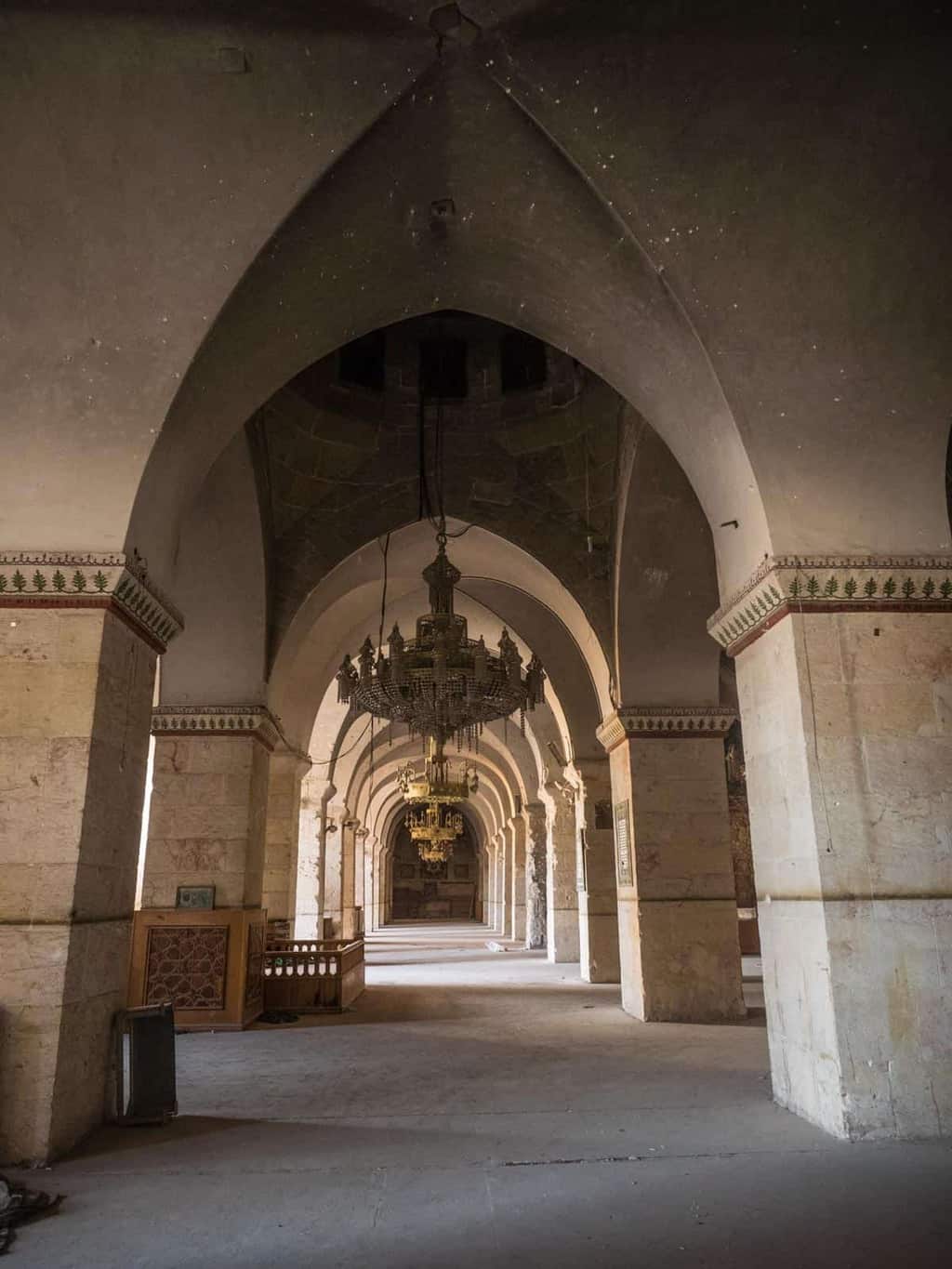
There´s less damage inside than I feared.
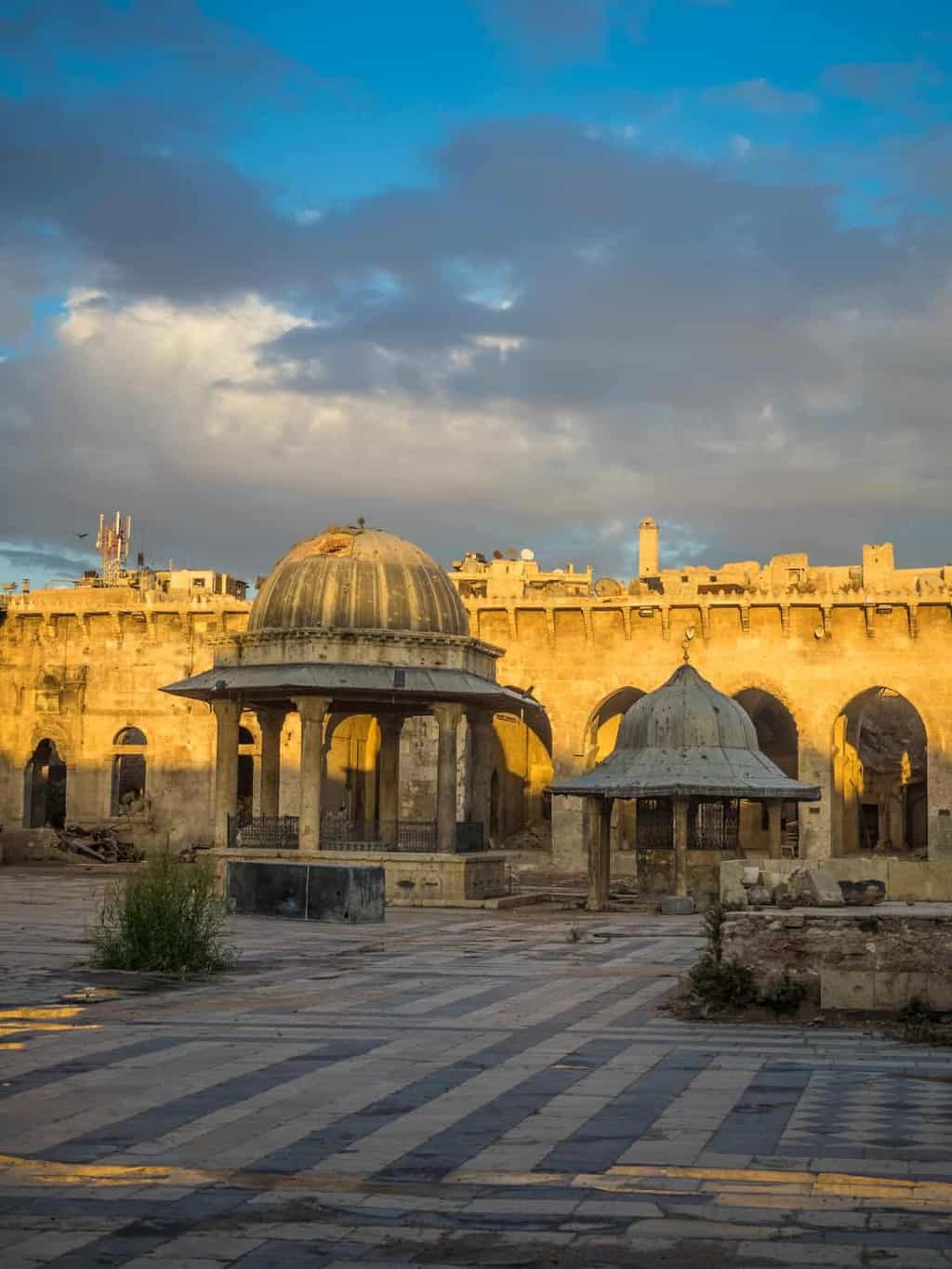
From the courtyard.
Aleppo Citadel after the war.
The Aleppo Citadel, a UNESCO world heritage site, was a proud treasure for the whole of the Middle East before the war.
It is considered to be one of the oldest and largest castles in the world. Usage of the Citadel hill dates back at least to the middle of the 3rd millennium BC.
Aleppo International Airport reopened on 21 December 2020, with weekly flights to Cairo, Beirut and Erbil.
It has been used by and survived through many of the greatest civilizations in history, from the Greeks, Romans, Mongolians to the Ottomans, and it´s still standing now after the war.
It´s badly dammed inside, but restoration has already started. And it shouldn’t take many years before it’s back to its former glory and open once again to hoards of tourists.
I was granted full access to inside the citadel.
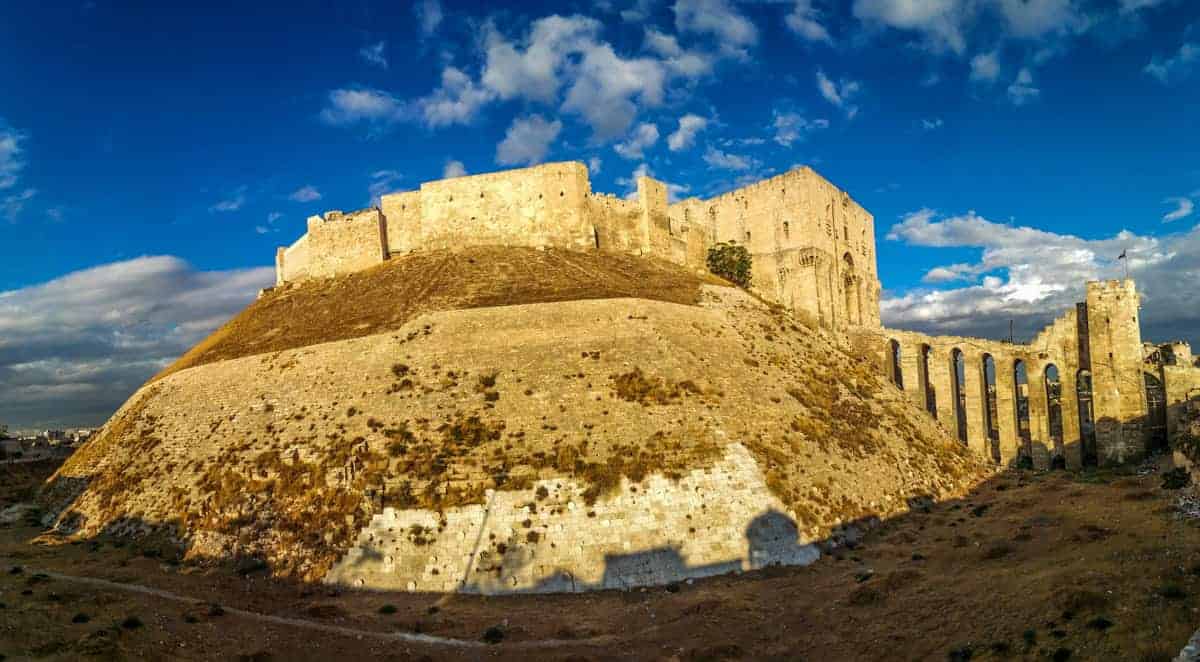
Aleppo Citadel from the western side.
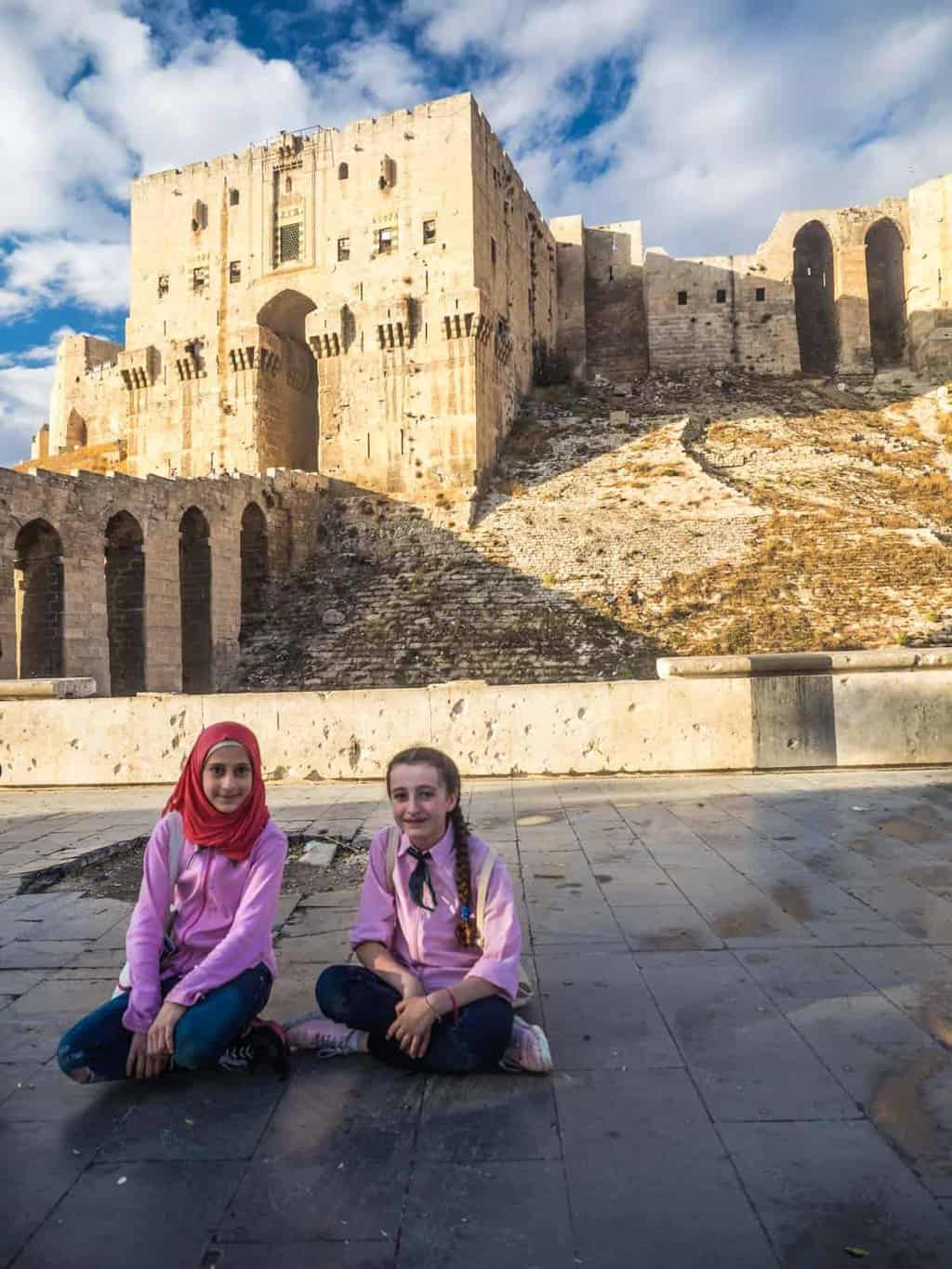
School kids are back visiting the Citadel, Girls choose themselves if they want to cover their hair or not in Syria.
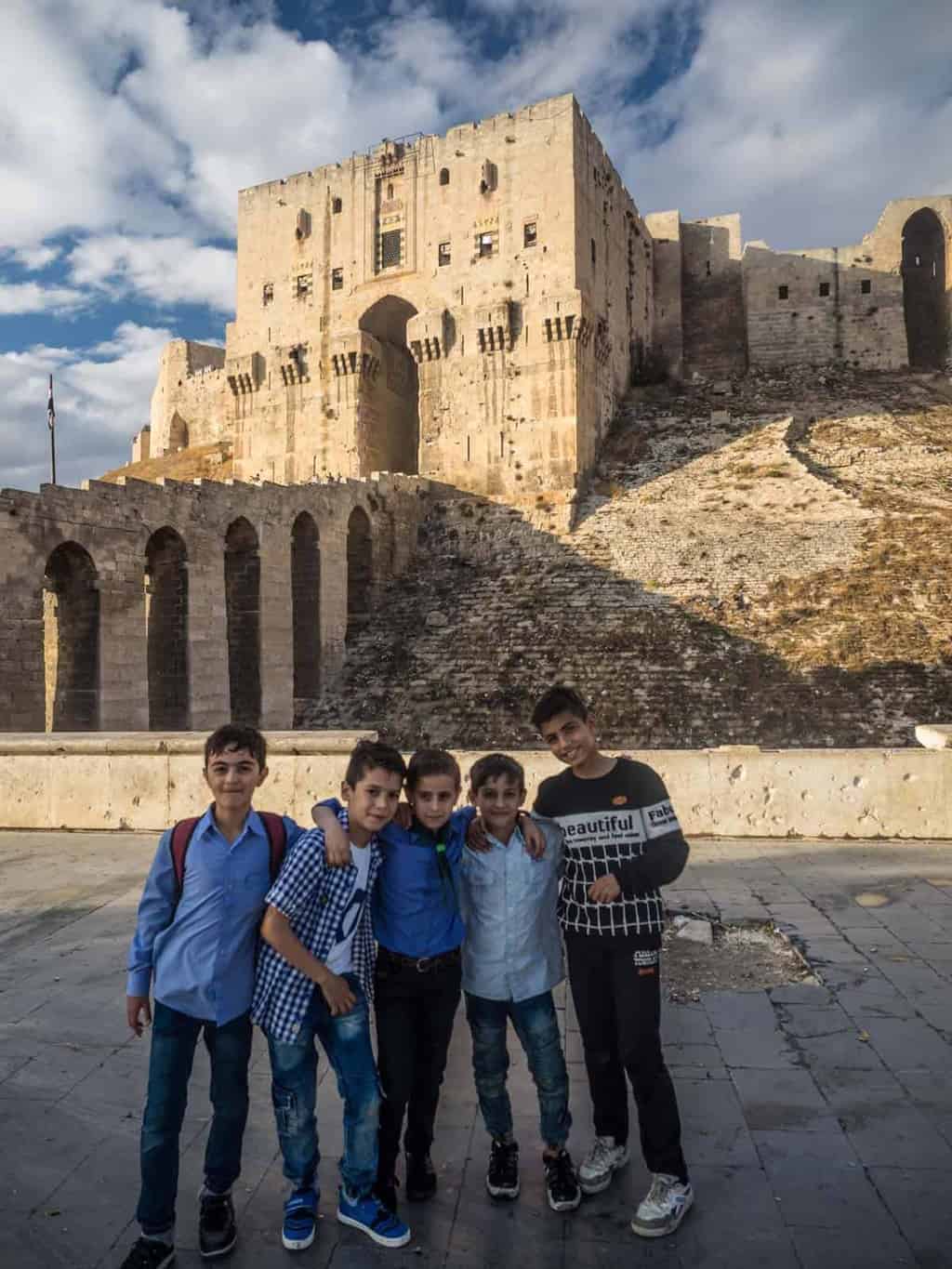
School kids are back visiting the Citadel.
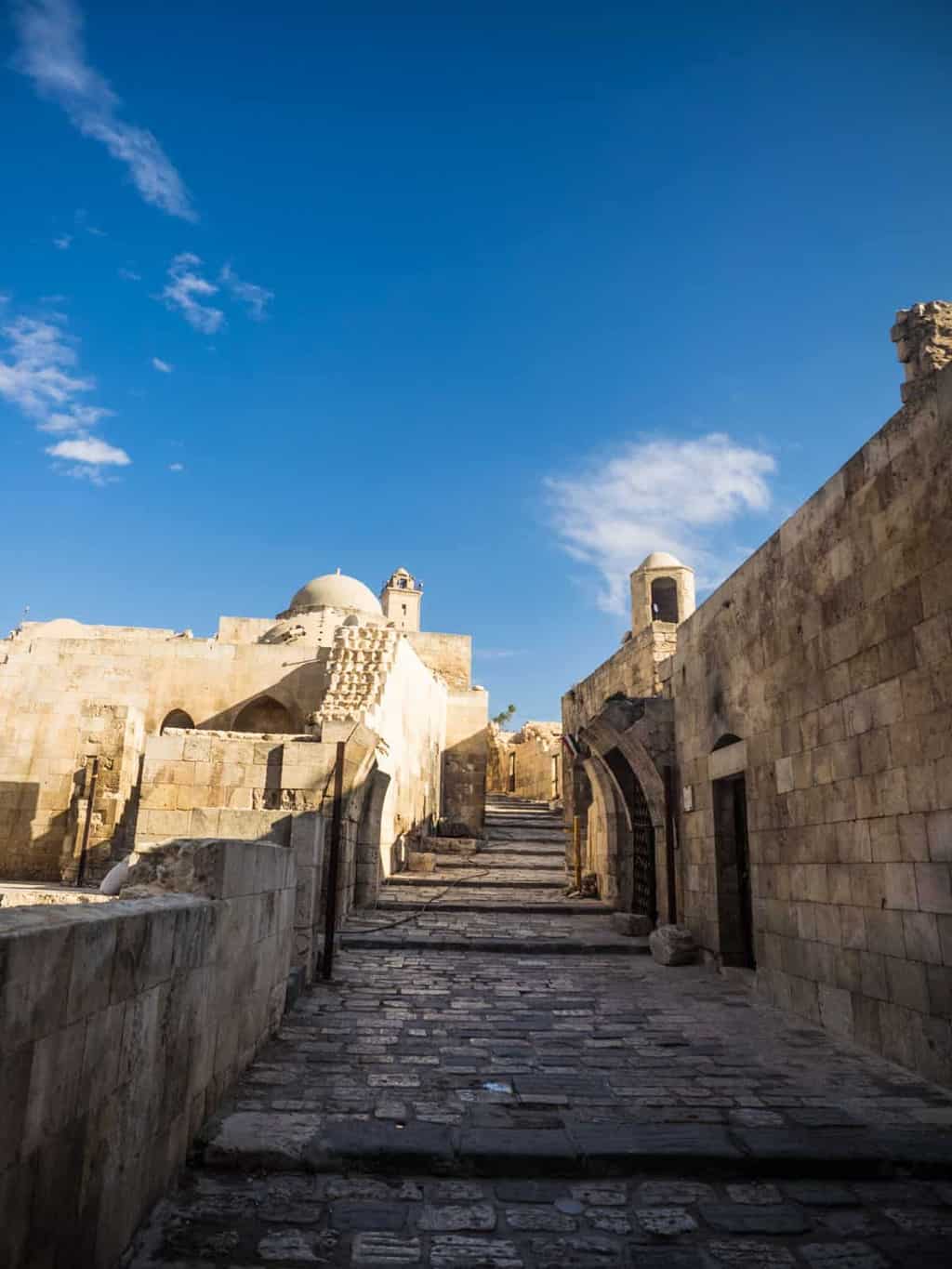
walkway trough the citadel
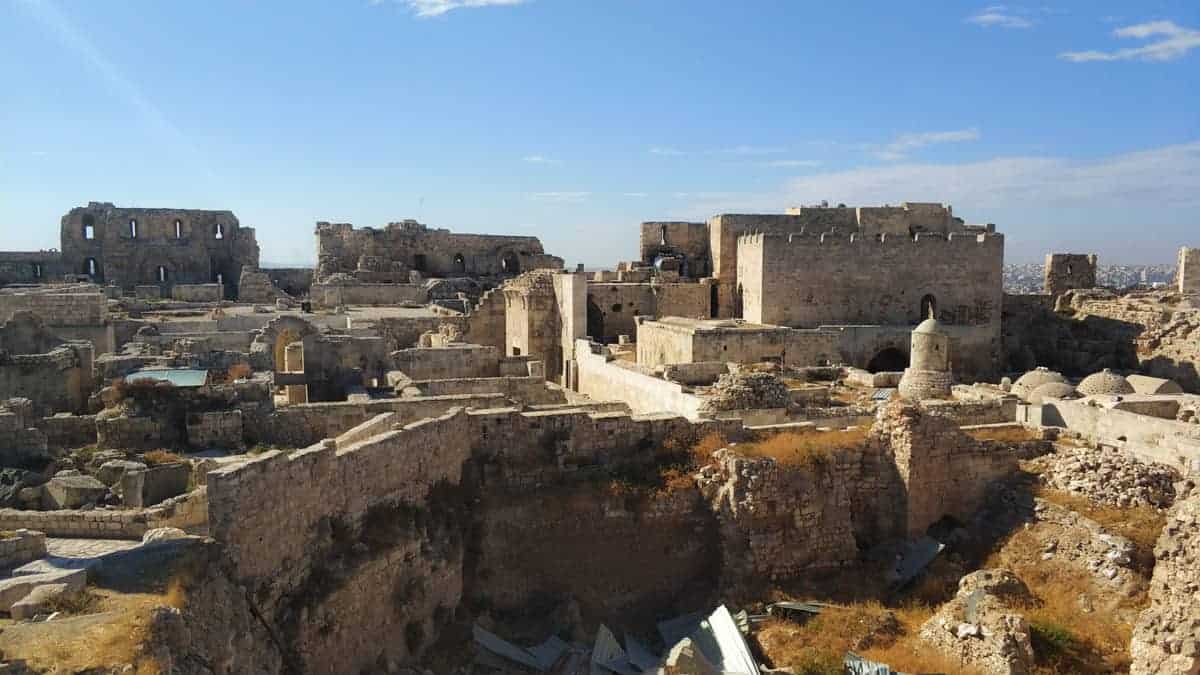
The place where some of the oldest excavation has taken place.
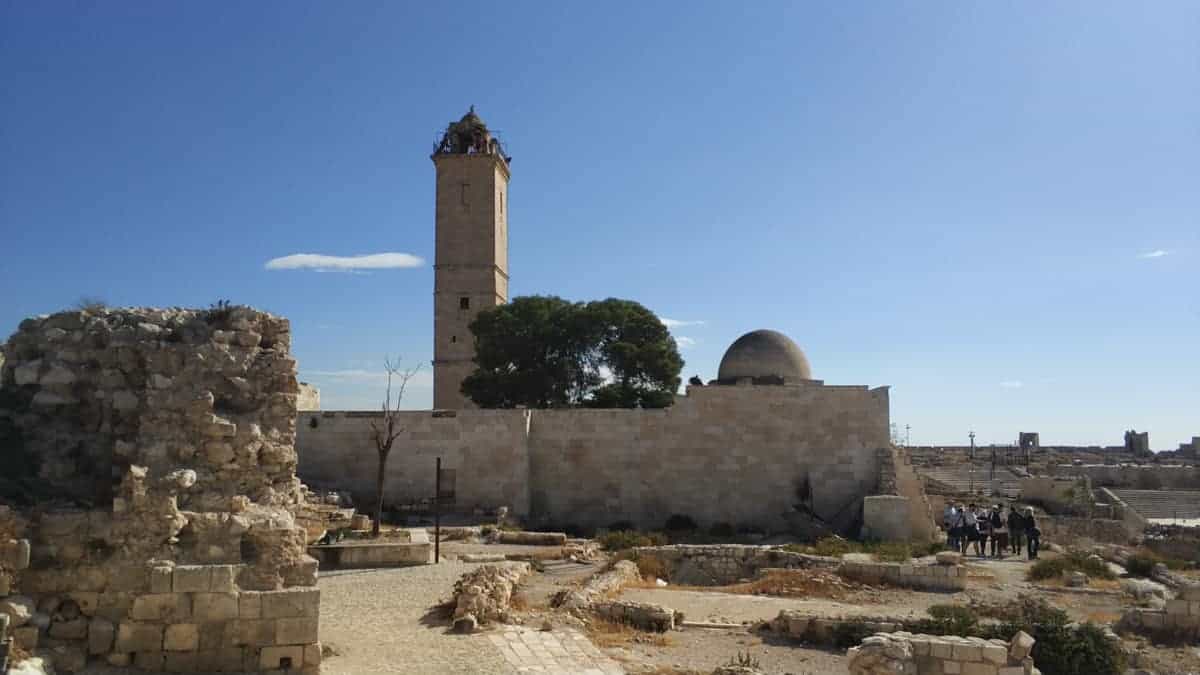
The mosque inside is not damaged too badly.
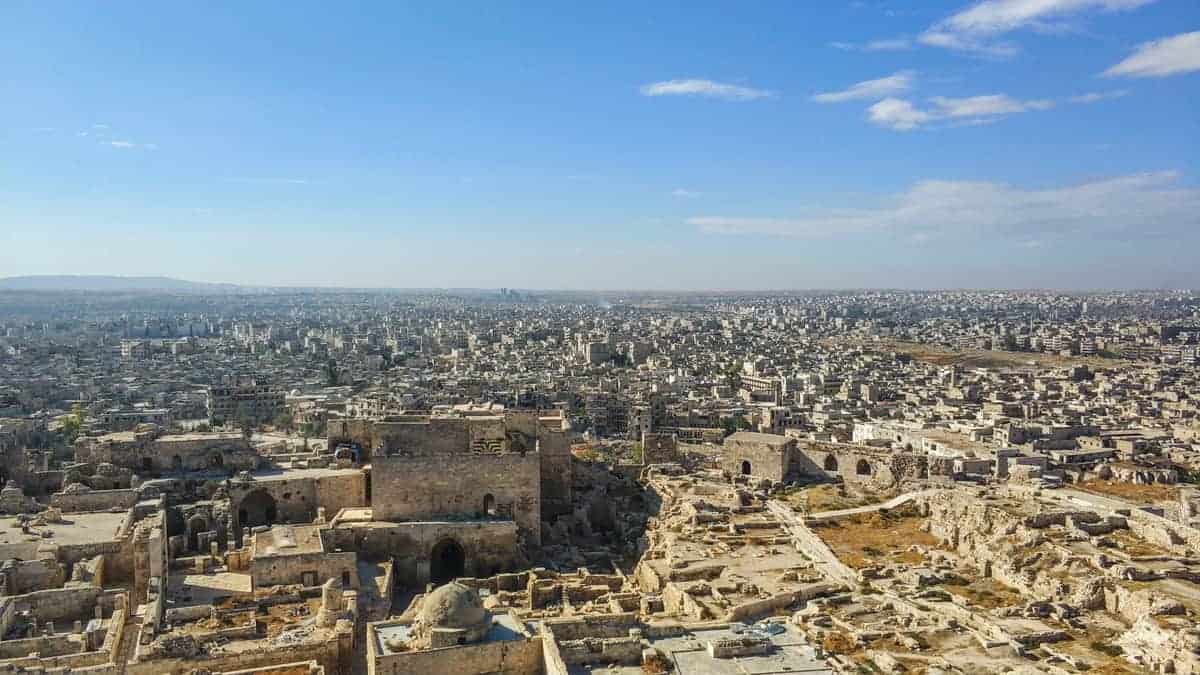
The view from the top of the Minaret to the mosque.
Daily Life In Aleppo Ala 2017.
The daily life in Aleppo these days is very normal once again after the government regained control over the city. While walking around central Aleppo, will you wonder if there ever was a war happening here.
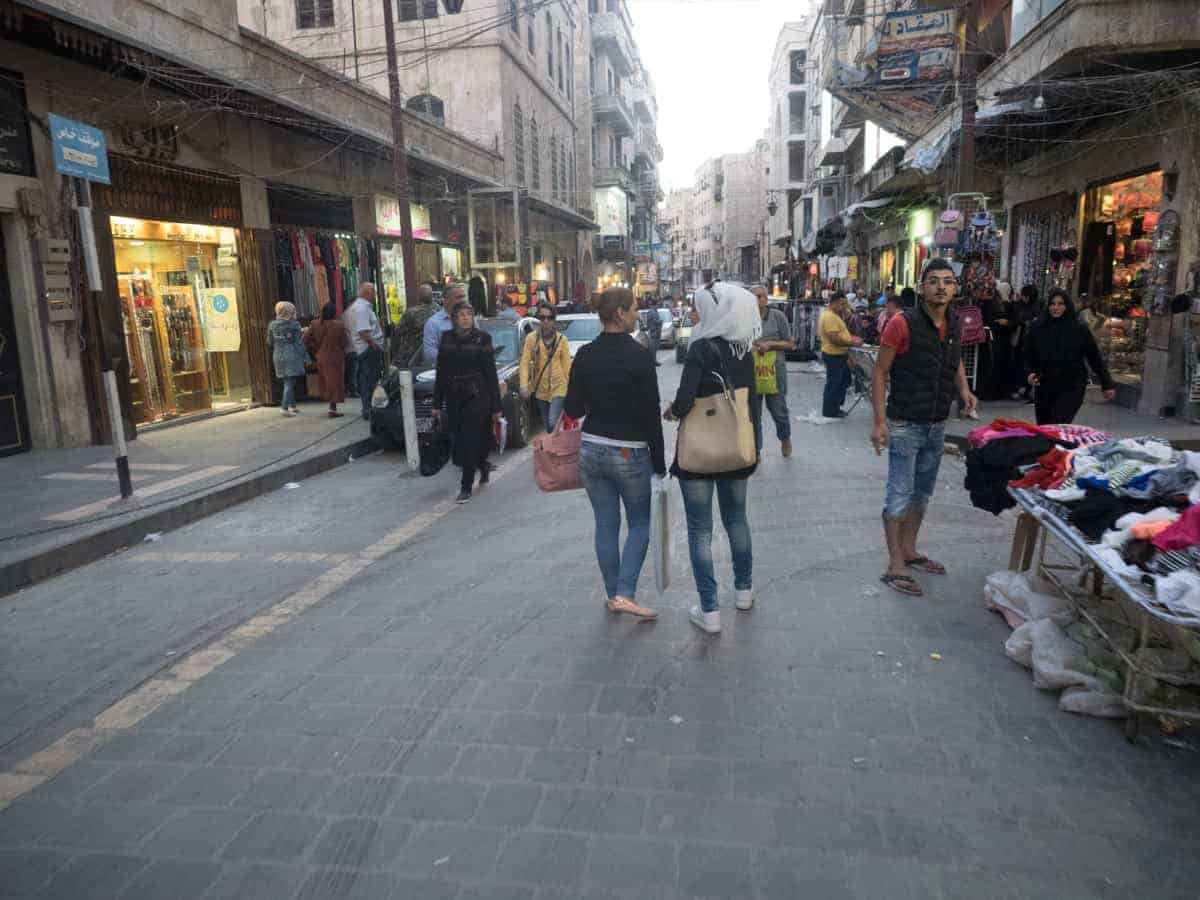
Locals on the streets.
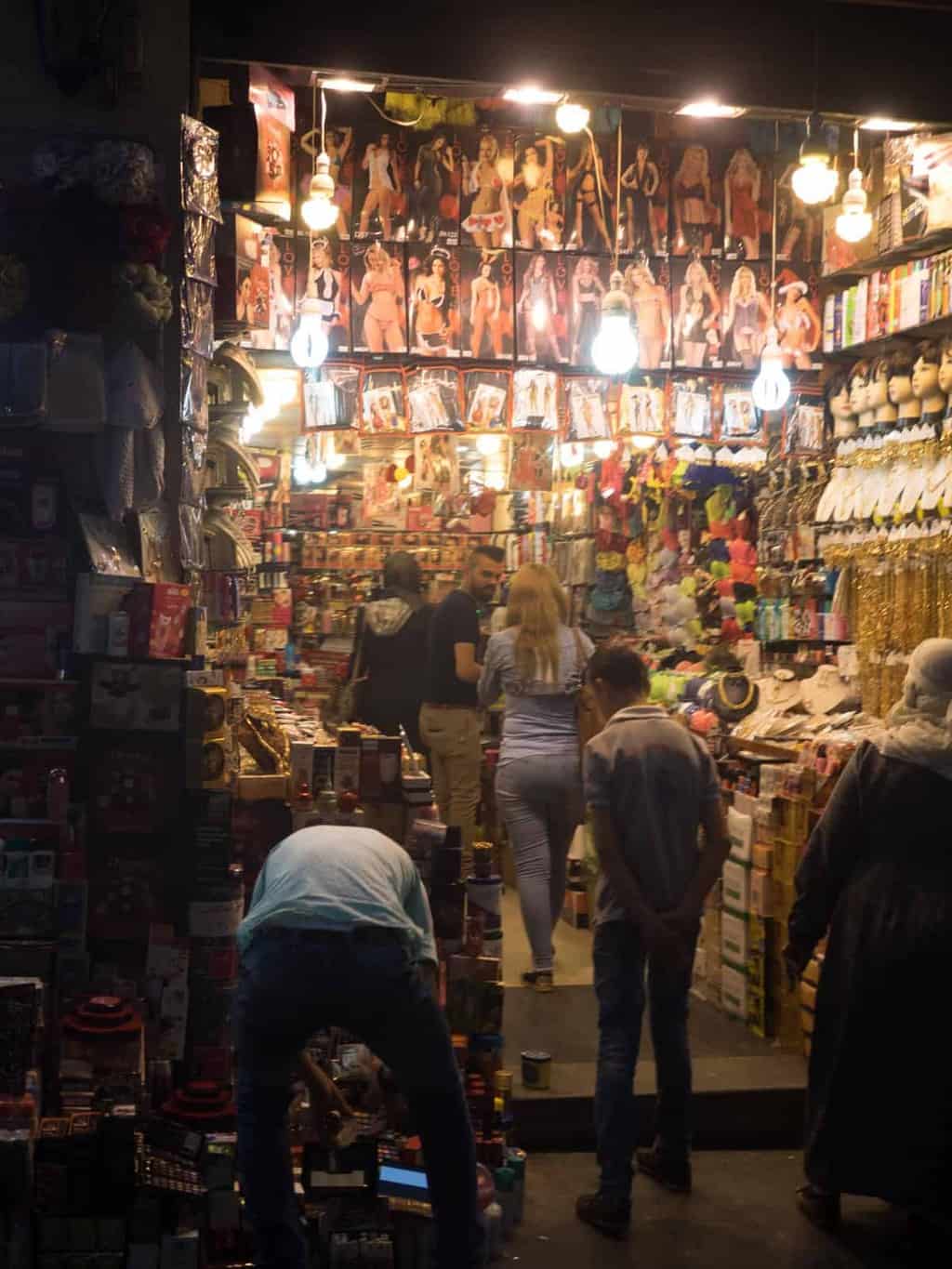
Fancy some sexy underwear?
During Syria´s national football time, everyone gathers to watch it. I watched the football game between Syria and Australia at a public watching inside a basketball court.
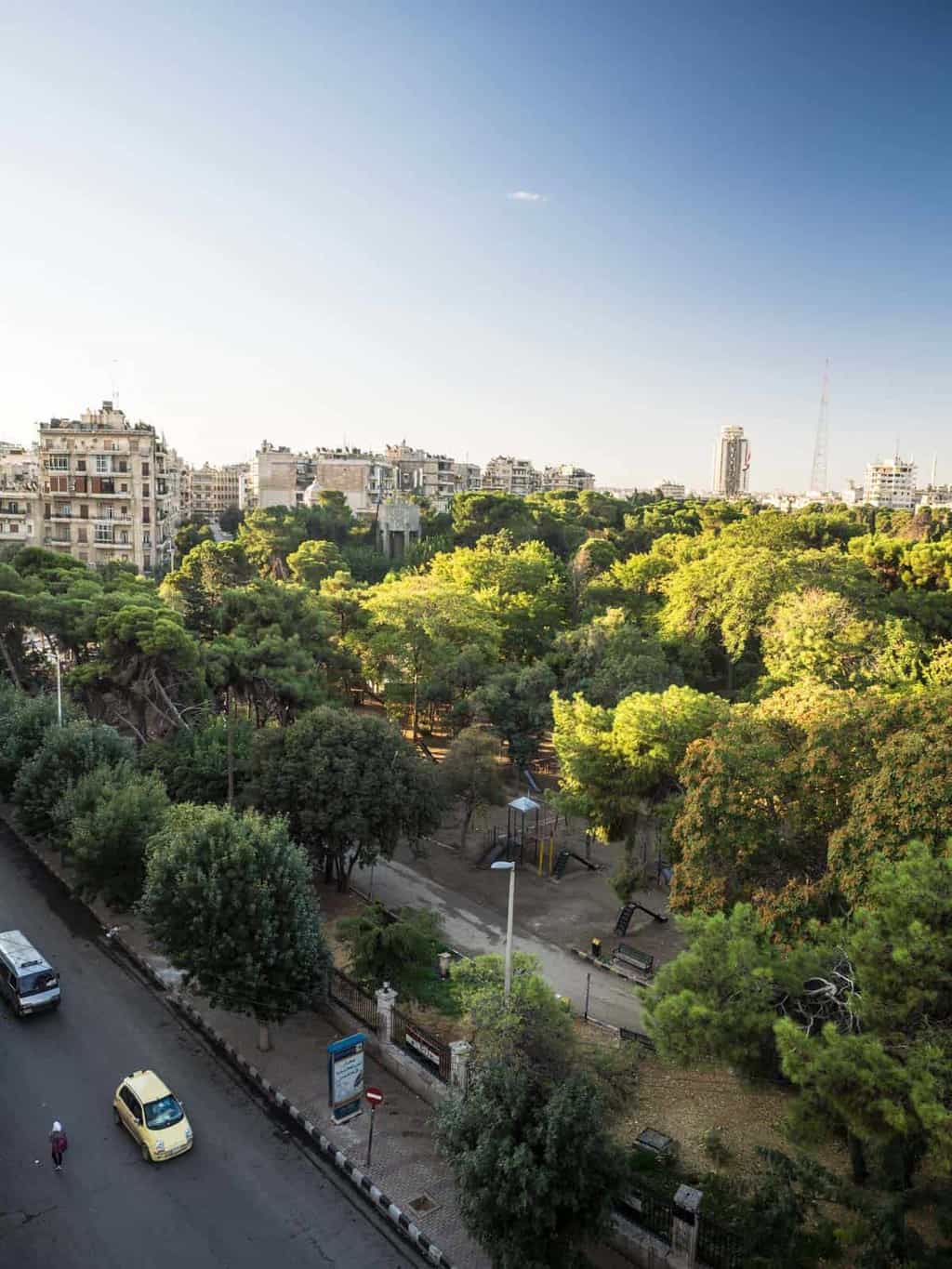
The central park in Aleppo
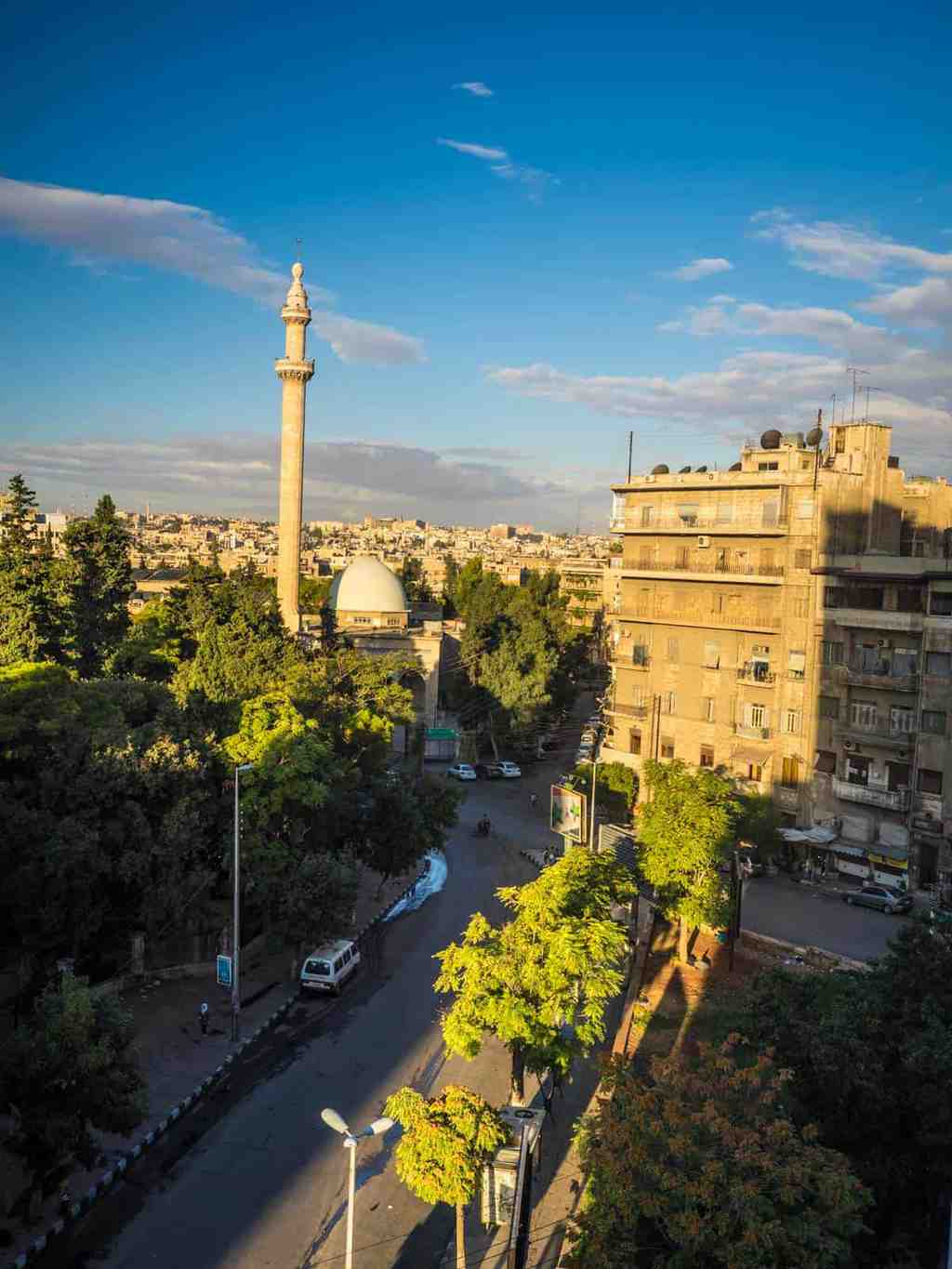
Clean and green
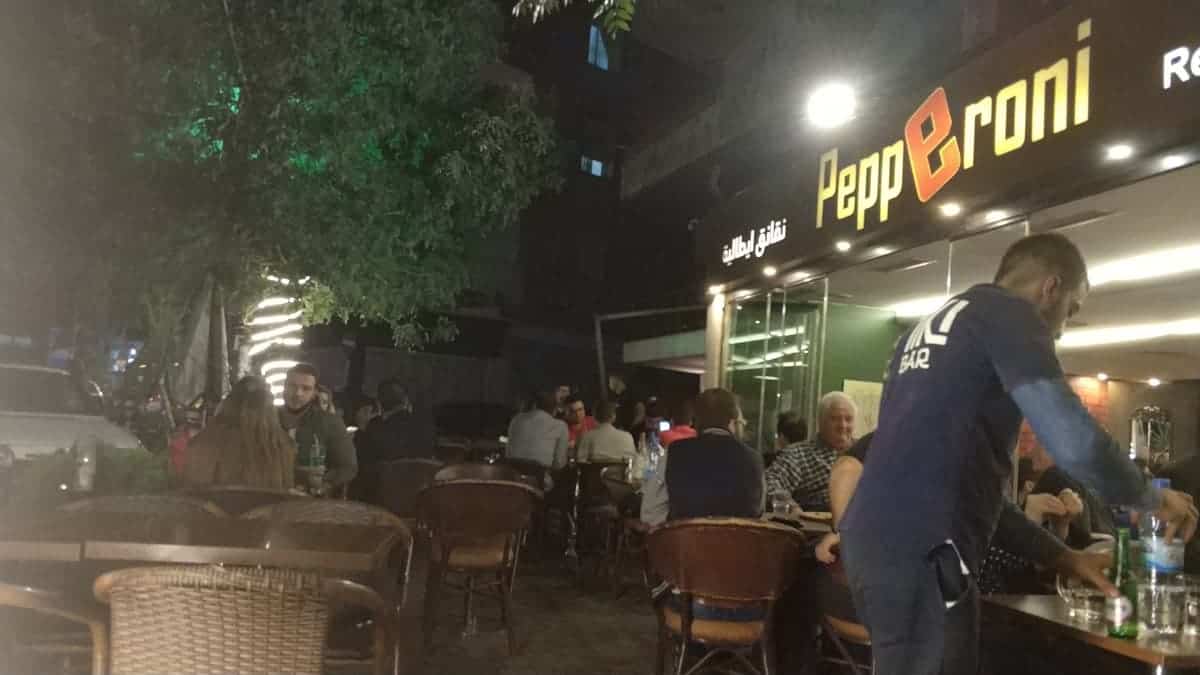
Locals enjoying pizza and beer.
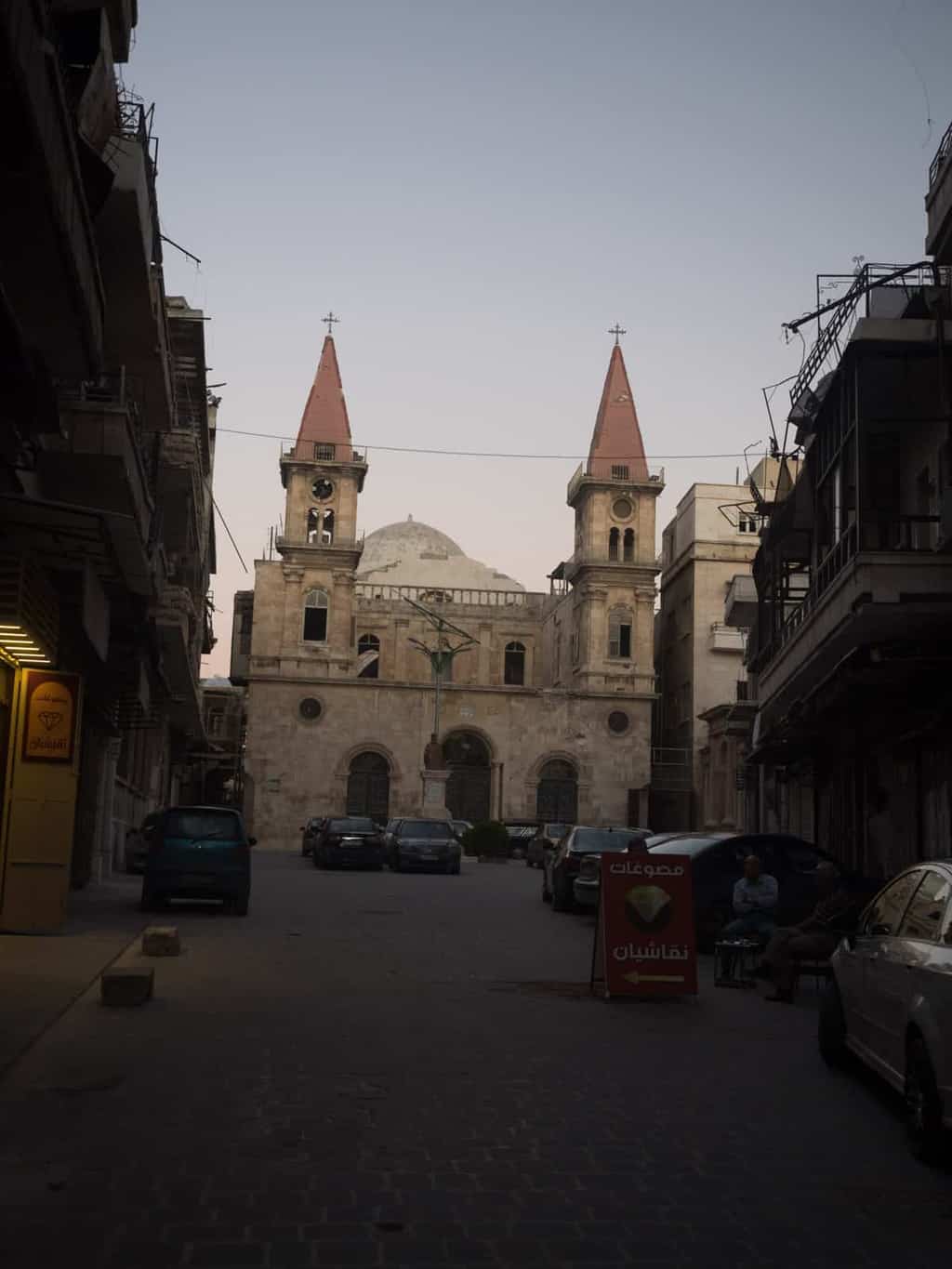
Christian Churches are open.
East Aleppo after the war.
The most destruction is located in this area, but even here have rebuilding begun, and we all remember reading about the last school that got bombed? It looks like a normal school to walk down to the basement and see ISIS flags.
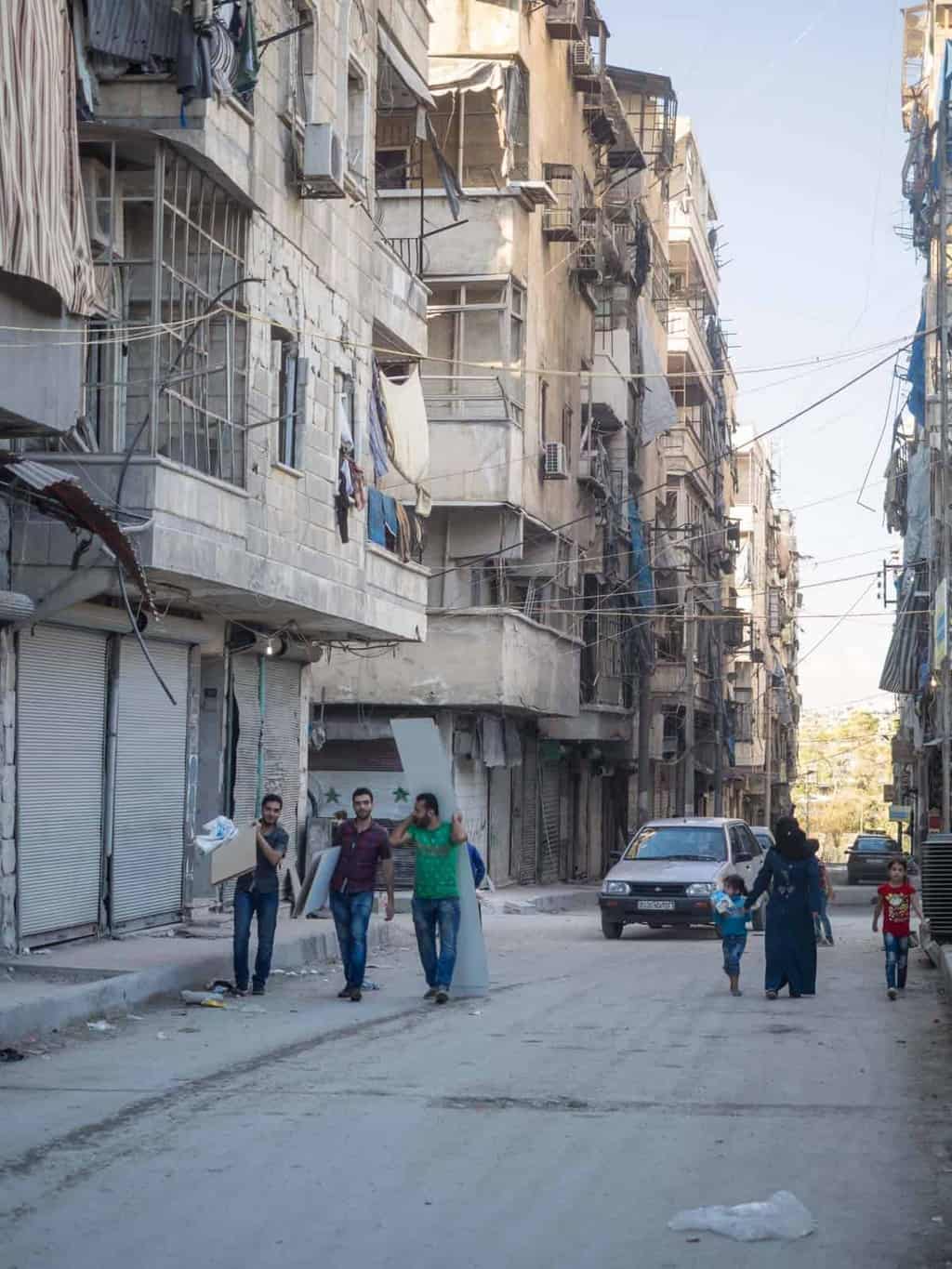
Streets of the Eastern part of town, people caring building material back home.
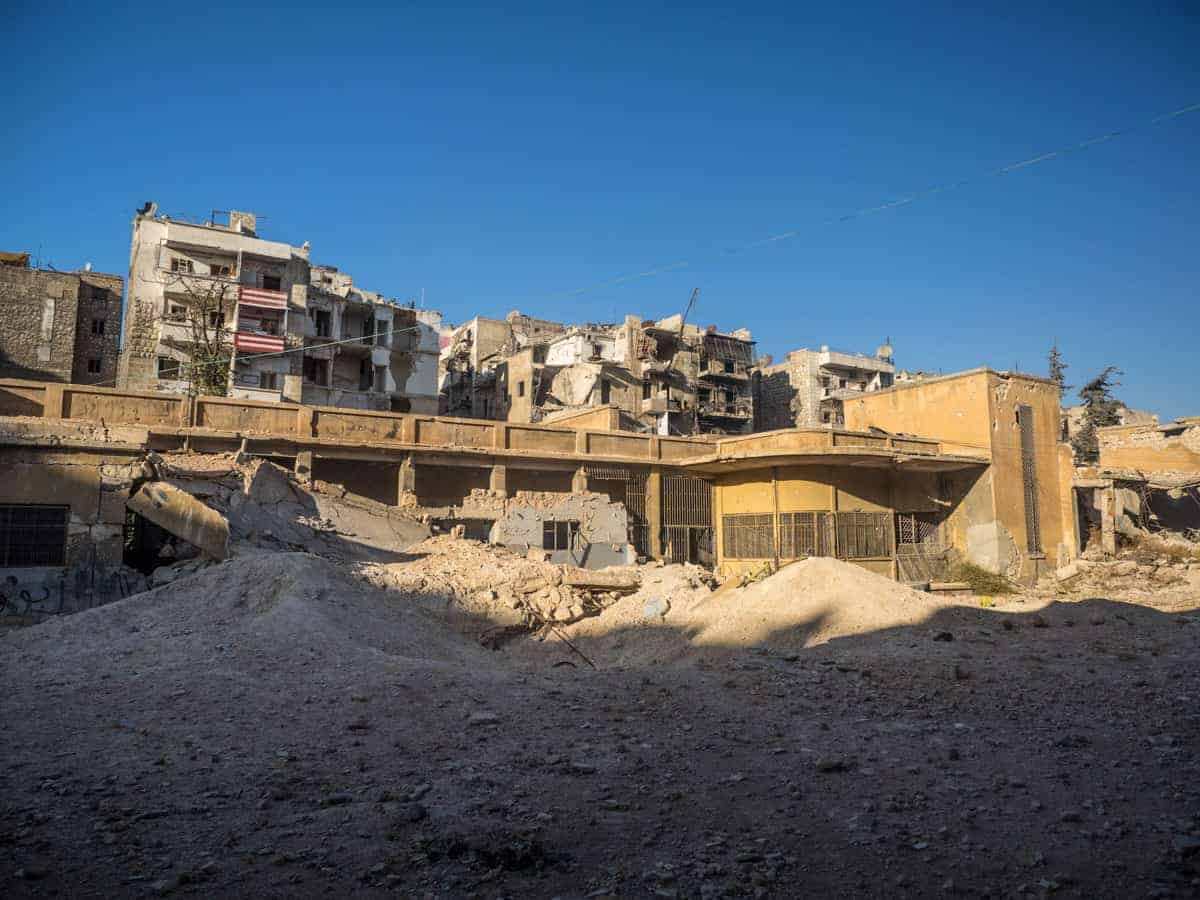
That´s how a school looks like after it got hit by an airstrike.
So do you still think Aleppo is a city in ruins? I have some hundred more photos from my visit to the city, and I will be posting more photos in the near future. I will also include the photos from the children’s school that was used by Daesh (Isis) and Al Queada as headquarters in a general post about my visit to Syria soon.
After 3 eye-opening days in Aleppo, was it time to head back down to central Syria and Homs.
Read about my trip to Krak des Chevaliers & The Valley Of Christians by clicking this link.
Aleppo: Between Liberation and Rebuilding.
Posted by INTERNATIONALIST 360° on MARCH 14, 2021
| From ‚Gagzi everywhere‘, 7 December 2020. Gagzi is a young Syrian woman posting videos about heritage, culture and life in Syria and studying tourism at Damascus University. You can subscribe to her channel and see the original post here: Gagzi shows off Aleppo, under reconstruction |
Homs, Syria (From The Most Devastated Town And Back To Normal Life)
By AuthorChristian L.
Published: November 28, 2017 – Last updated: October 2, 2021
Homs was the city where the war in Syria started for full in March 2011, when the so-called moderate opposition killed 10 Syrian Army soldiers at a checkpoint and captured another 19 soldiers.
Government forces began an artillery bombardment of the old city of Homs on the night of 3 February 2012.
The protests started in the southern city of Daraa on March the 15th. But it was in Homs where it escalated and went from protests to a war.
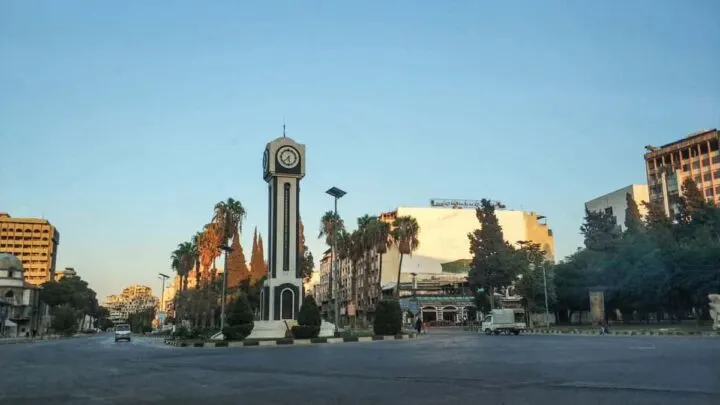
The main square
Around 70% of Homs was destroyed before the city was back under Government control. Homs is the city where you will see the most destruction in Syria, but rebuilding has started and even the old Souq (market) that was completely destroyed during some of the heaviest battles during the war, is very soon ready to reopen.
A few shops are up and running already, and all others are soon to follow.
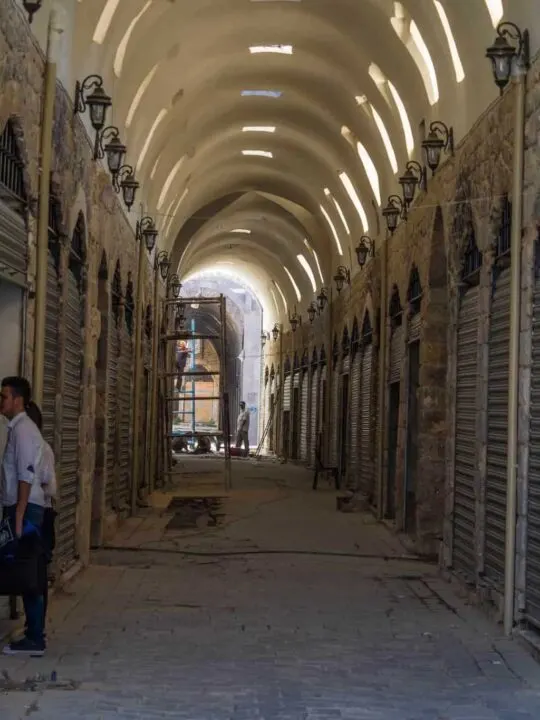
The Old Homs Souq is almost ready for reopening
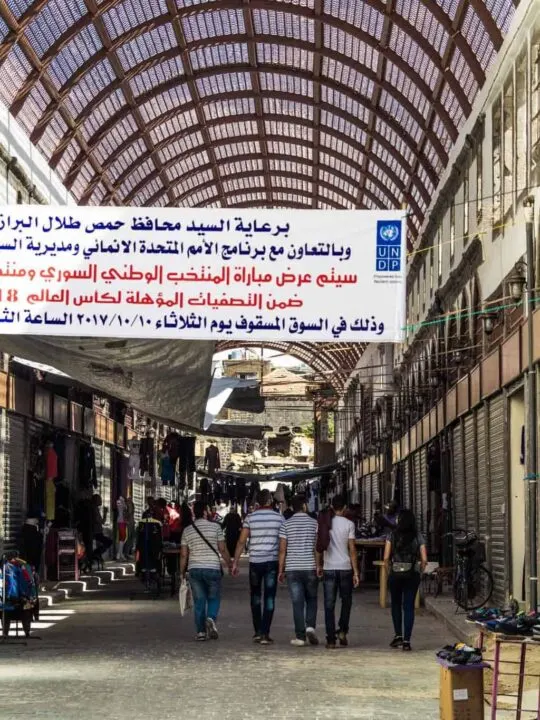
Some parts of the Old Souq are already open after aid from UN
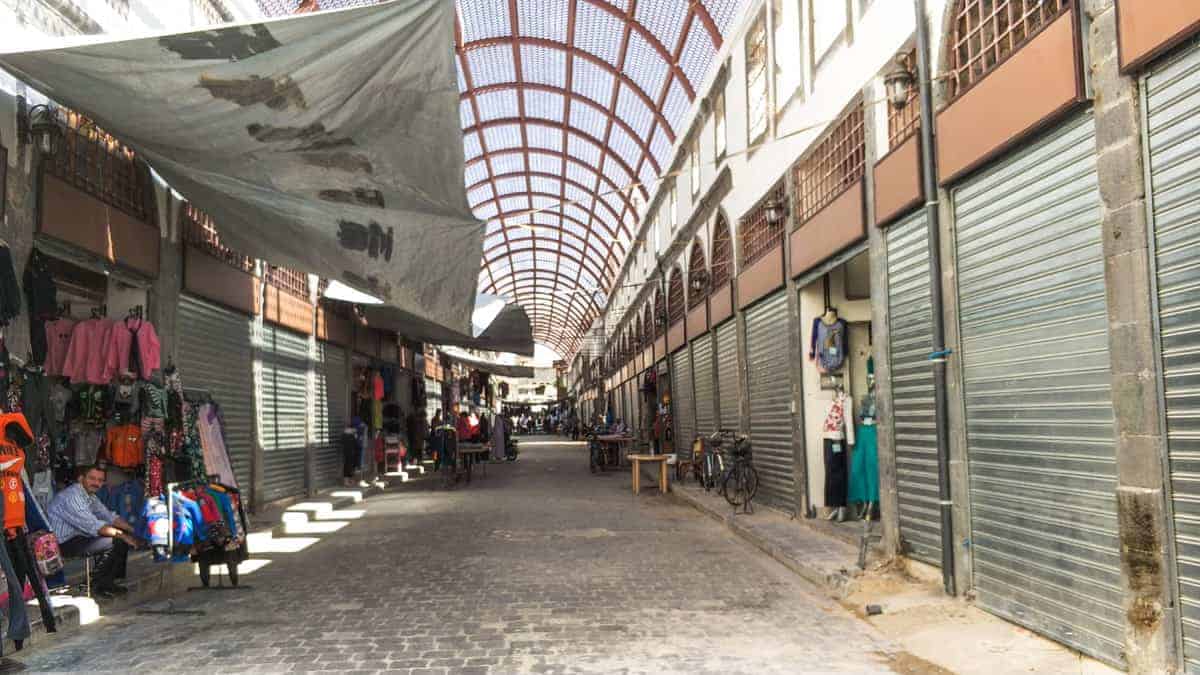
Some shops are already open.
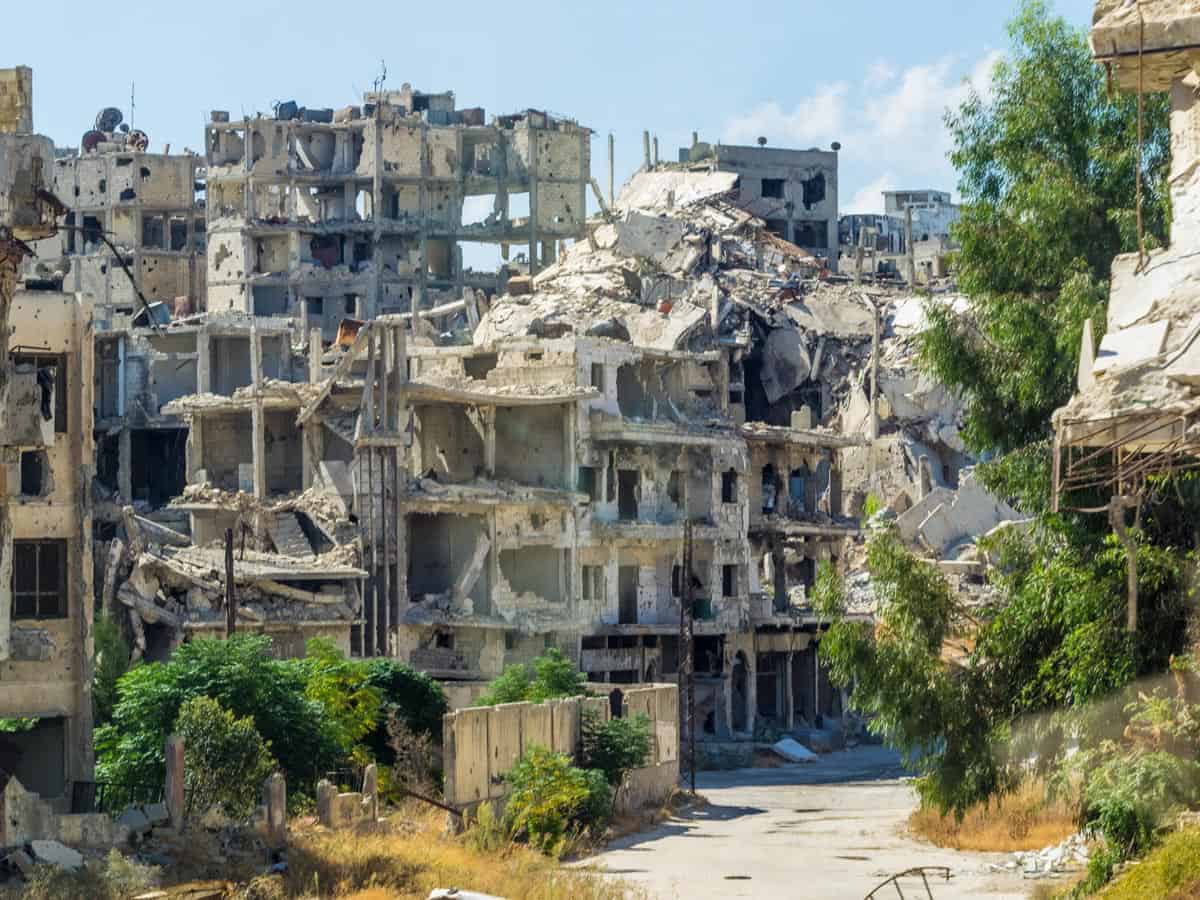
Nature Taking over the broken part of Homs.
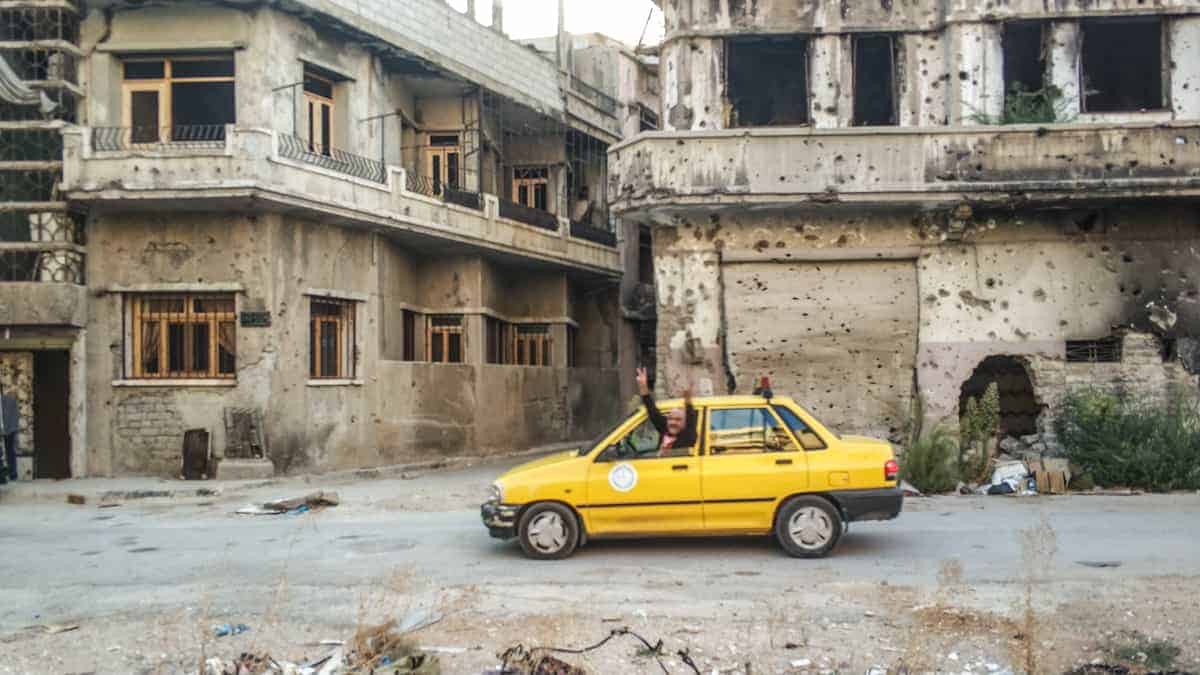
A waving and cheering taxi driver.
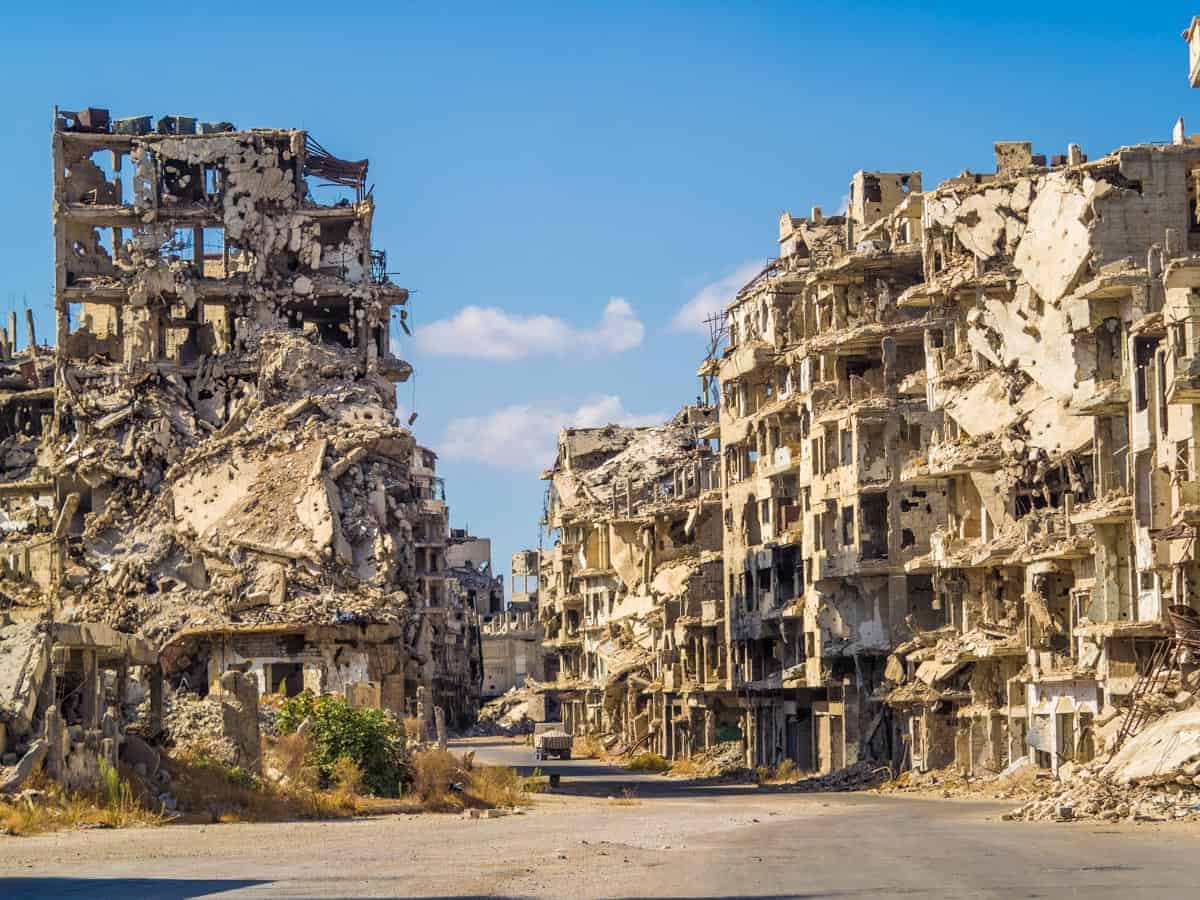
One of the areas with almost complete destruction.
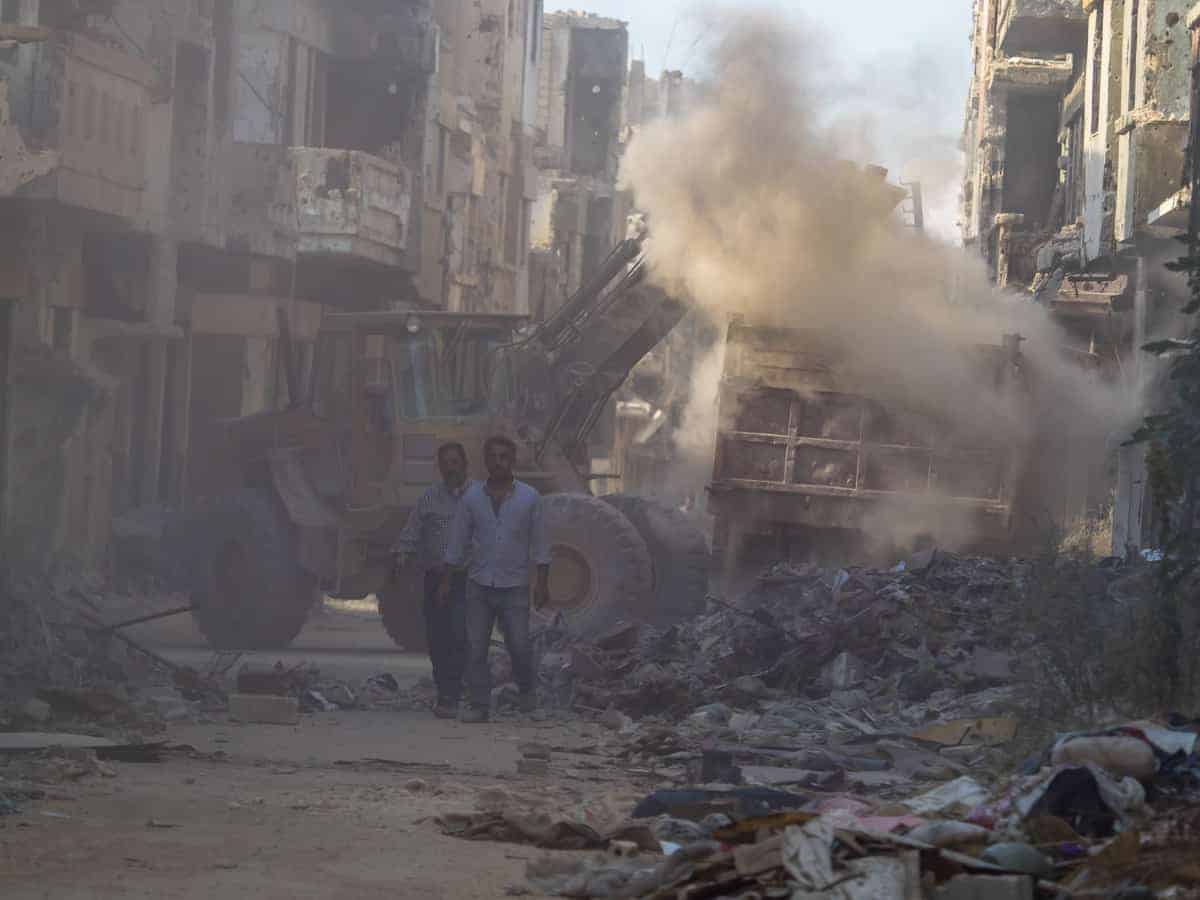
There´s cleanup happening all over the destroyed areas.
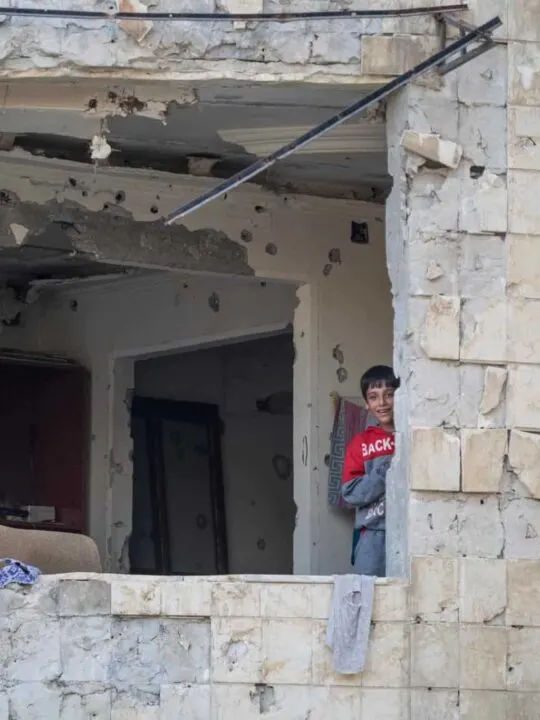
The Kids still have smiles on their faces.
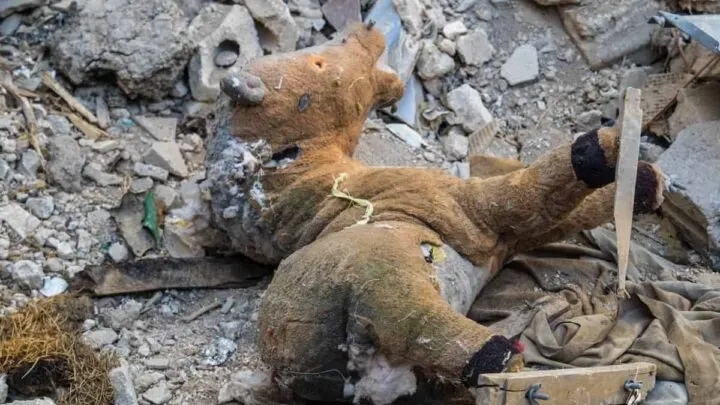
Kids are the biggest victims of every war.
Normal life in Homs is returning back to normal with the city getting rebuild fast;
Kids are back to schools, traditional restaurants are open, locals have started to move back and rebuild their homes, and shashlik stands are filling the street with the great smell of bbq.
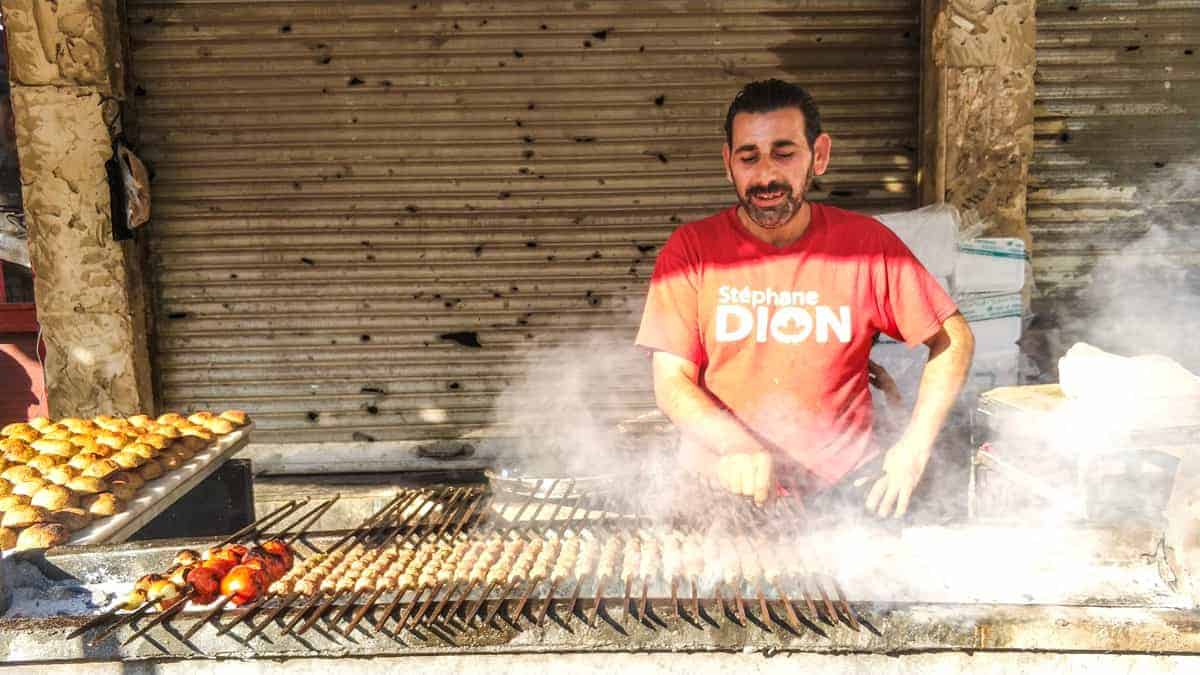
Street BBQs are back on the streets.
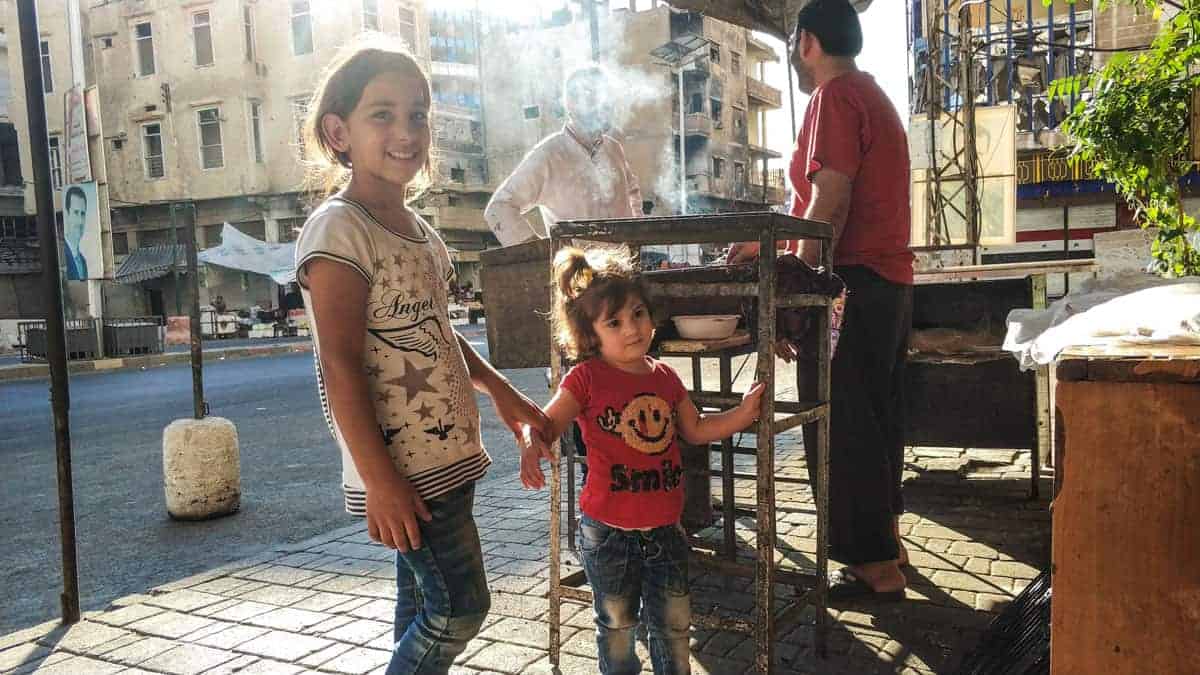
Two young girls waiting for their dad at the Shaslki stand.
But Homs is also the city where you will hear the most disturbing tales from the locals, as for months they had to live under rebels rules.
The stories contain, rapes, decapitations, abductions of their kids, and in general things that make even the worst horror movie seem like a romantic date movie.
And one of the places with a lot of sorrow is the primary school where close to 50 school kids got killed by a double suicide bomb, the first bomb went off at the school’s gate, then when people rushed to help a second bomb went off at the Akrameh al-Makhzumi school.
The school is today completely rebuilt and up and running, and the bomb remains, and damage of the school is positively being used by the students in an art project for a better future.
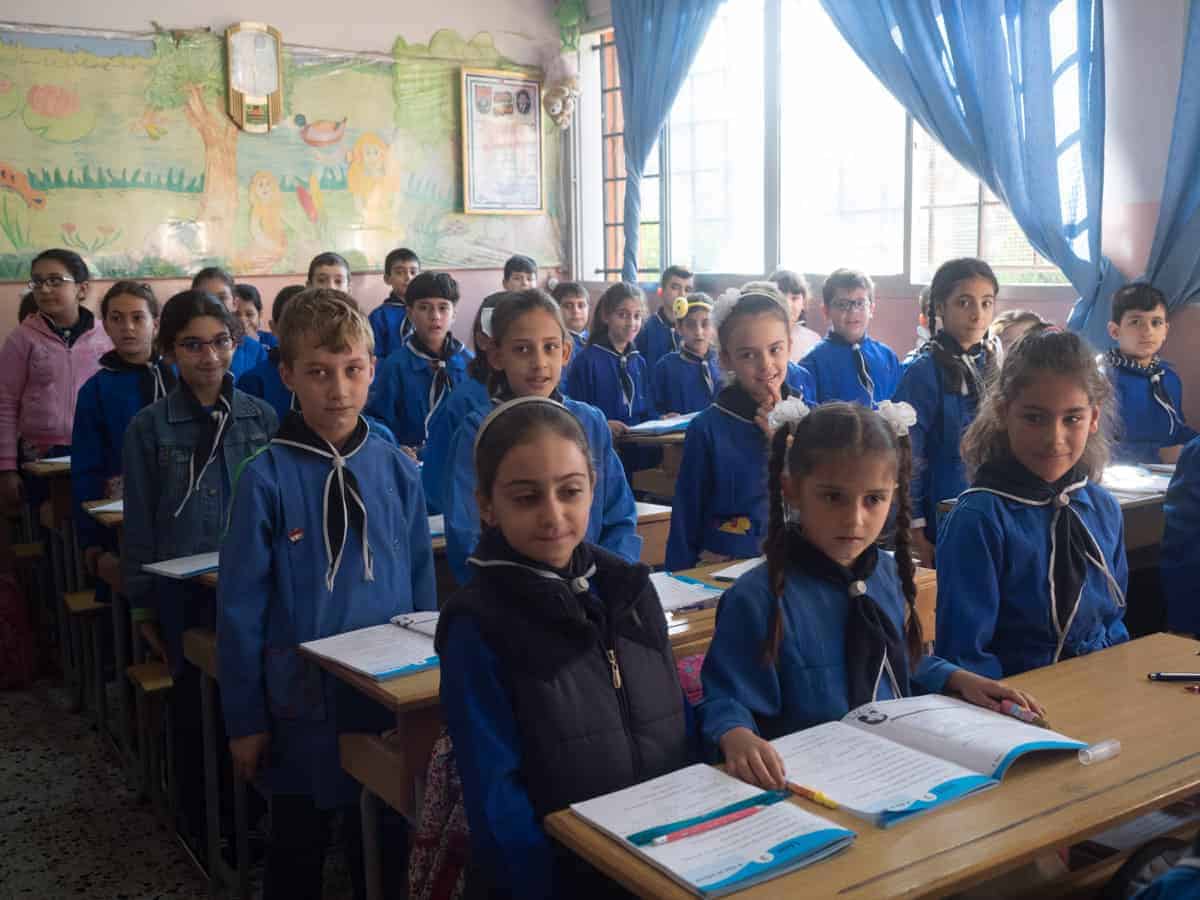
School children in Homs.
Education in Syria is completely free and compulsory from the age of 6 to 15 (1st to 9th grade). English and French are taught from 1st grade, and for the young students, I met their English skill was very impressive and far ahead of the students back in my home country Norway.
If parents deny their kids education, they you be sentenced to 6 months in jail.
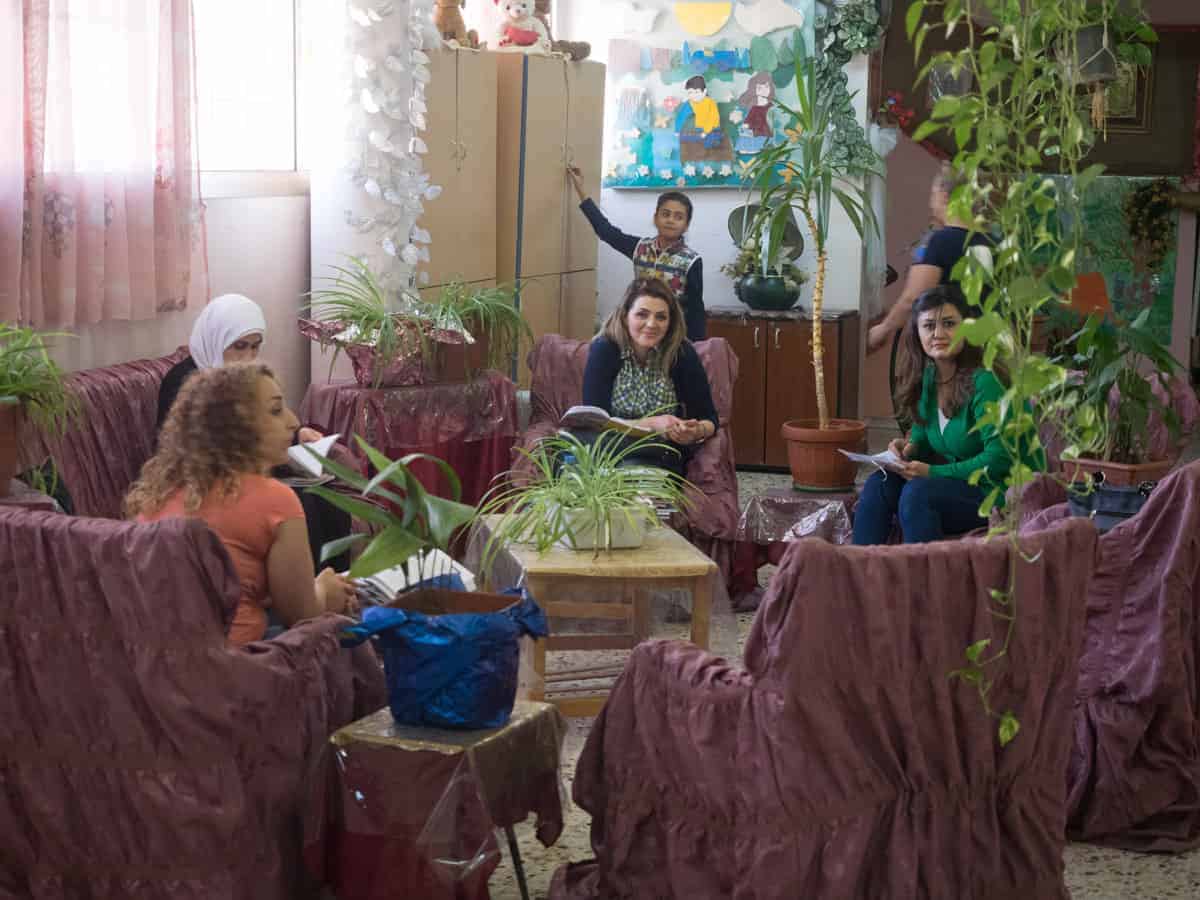
The Teachers Lounge.
While the outskirts of Homs is still almost completely devastated so has the center of Homs returned so somewhat normal life again, with locals enjoying shopping, shisha at street cafes, young couples holding hands, and young men watching European football on the big screens. Even I did some shopping here, I bought two nice shirts.
So you can see that even the most devastated city in Syria is returning to normal, do you still believe mainstream media claiming that Syria is a country in Ruins??
Before the war, Homs was the starting point to the amazing Crusader Castle Krak des Chevaliers from the 11th century and The Valley Of Christians home to the famous Saint Georgie Monastery and the villages surrounding the valley being home to more than 200 000 Christians in Syria. I did visit both Krak des Chevaliers and the Valley of Christians during my visit to Syria.
Recommended
- Things To Do In Damascus, Syria | 20 Best Tourist AttractionsRead More
- Pushkar Mela, Rajasthan: A Glimpse of Rural IndiaRead More
- Socotra Island, Yemen丨Guide to the Most Alien-looking Place on EarthRead More
By AuthorChristian L.
Published: November 28, 2017 – Last updated: October 2, 2021Tags
| Wiederaufbau in Syrien Herausforderungen und Handlungsoptionen für die EU und ihre MitgliedstaatenSWP-Studie 2020/S 07, April 2020, 37 Seiten Dr. Muriel Asseburg ist Senior Fellow in der Forschungsgruppe Naher / Mittlerer Osten und Afrika.pdf ■ Der Bürgerkrieg in Syrien ist längst militärisch zugunsten des Regimes entschieden. Eine verhandelte Konfliktregelung, eine Aussöhnung oder eine nachhaltige Stabilisierung sind für das Land nicht in Sicht .■ Syrien steht vor enormen Herausforderungen, die über den Wiederaufbau von Infrastruktur und Wohnraum weit hinausgehen. Dazu gehören vor allem Anschubhilfe für eine wirtschaftliche Erholung, die Stabilisierung der Währung und die Erneuerung staatliche ■ Die EU und ihre Mitgliedstaaten haben ein Engagement beim Wiederaufbau Syriens von tragfähigen Schritten in Richtung einer verhandelten Konfliktregelung und einer politischen Öffnung des Landes abhängig gemacht. Sie sollten ihren Ansatz so anpassen, dass er besser den Herausforderungen vor Ort und der aktuellen Realität entspricht. ■ Das bedeutet insbesondere, humanitäre Hilfe effektiver einzusetzen, sektorale Sanktionen abzubauen und die Rehabilitierung von Basisinfrastruktur auch in Gebieten zu unterstützen, die unter Kontrolle der syrischen Regierung stehen. Auf diese Weise ließe sich wirksamer als bislang zur |
Problematischer «Wiederaufbau» in Syrien
Februar 2019 AUTOR Harald Etzbach
| Die Pläne sind längst geschmiedet. Das Dilemma: Eine Förderung des Aufbaus in Syrien unterstützt immer auch das Assad-Regime.(…)Nicht verwunderlich ist, dass das Assad-Regime wiederholt erklärt hat, der Wiederaufbau des Landes solle vor allem von seinen Verbündeten geleistet werden. Russlands ökonomische Rolle ist schon in den letzten Jahren parallel zu seiner militärischen Bedeutung für das Überleben des Assad-Regimes deutlich gewachsen. Bereits im Oktober 2015 führte der Besuch einer russischen Delegation in Damaskus zum Abschluss von Verträgen in Höhe von insgesamt mindestens 850 Millionen Euro. Ein Jahr später, im November 2016, erklärte der syrische Außenminister Walid Muallem anlässlich des Besuchs einer weiteren russischen Delegation, Russland stehe beim Wiederaufbau Syriens Priorität zu.Im Januar 2018 unterzeichnete Moskau ein bilaterales Abkommen mit Damaskus, das ihm exklusive Förderrechte für Öl und Gas in Gebieten unter unmittelbarer Kontrolle des Assad-Regimes einräumte. Diesem Abkommen folgte die Ankündigung des russischen Energieministers Alexander Nowak, dass Moskau mit Syrien einen «Fahrplan» zur «Wiederherstellung von Ölfeldern und Entwicklung neuer Lagerstätten» unterzeichnet habe. Im Oktober 2018 wurde schließlich die Zusammenarbeit zur Verbesserung der syrischen Ölförderanlagen angekündigt.(…) |
Syria’s society, culture, civilization, religions and women – with Janice Kortkamp

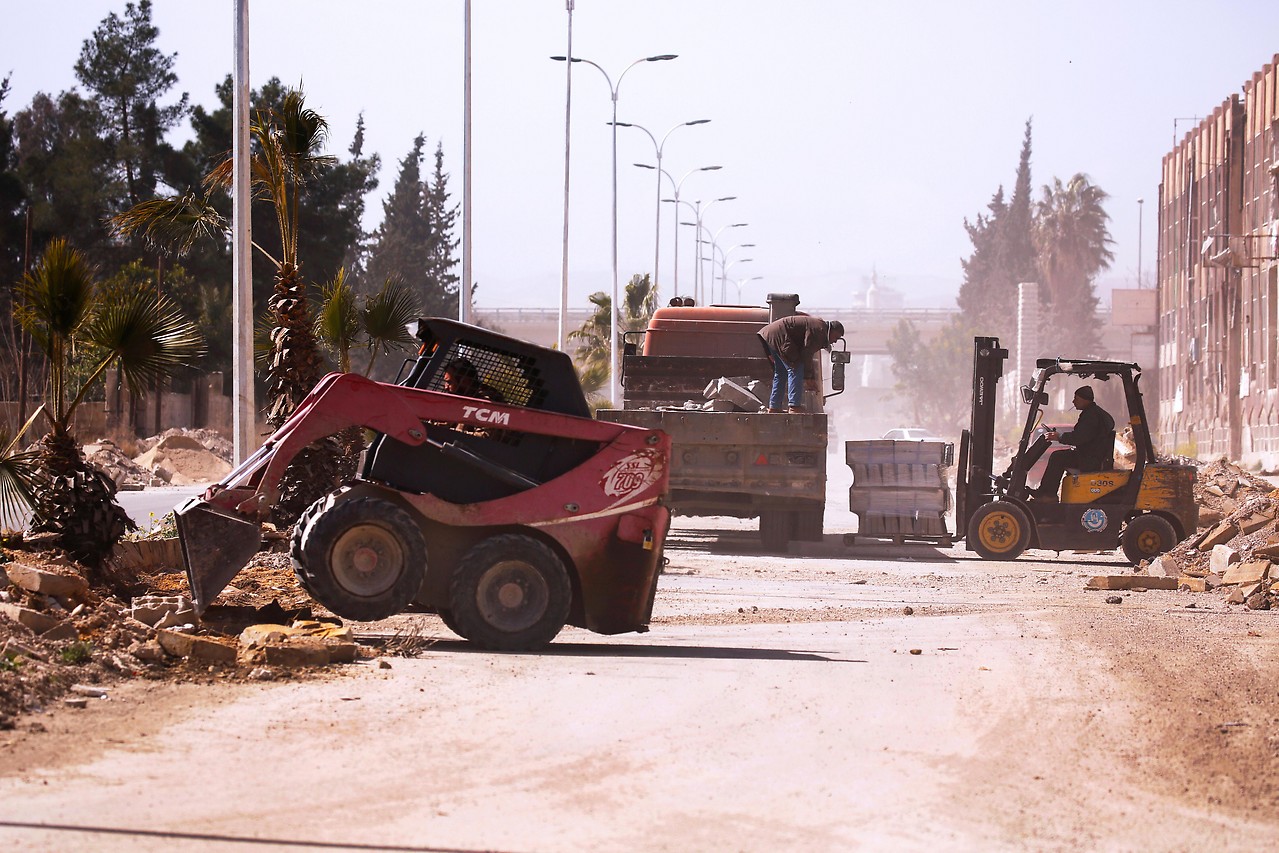

Schreibe einen Kommentar